fall inside a hole
Stelco Junior Express
First written December 19, 2023Updated with additional catalogue information April 29, 2024
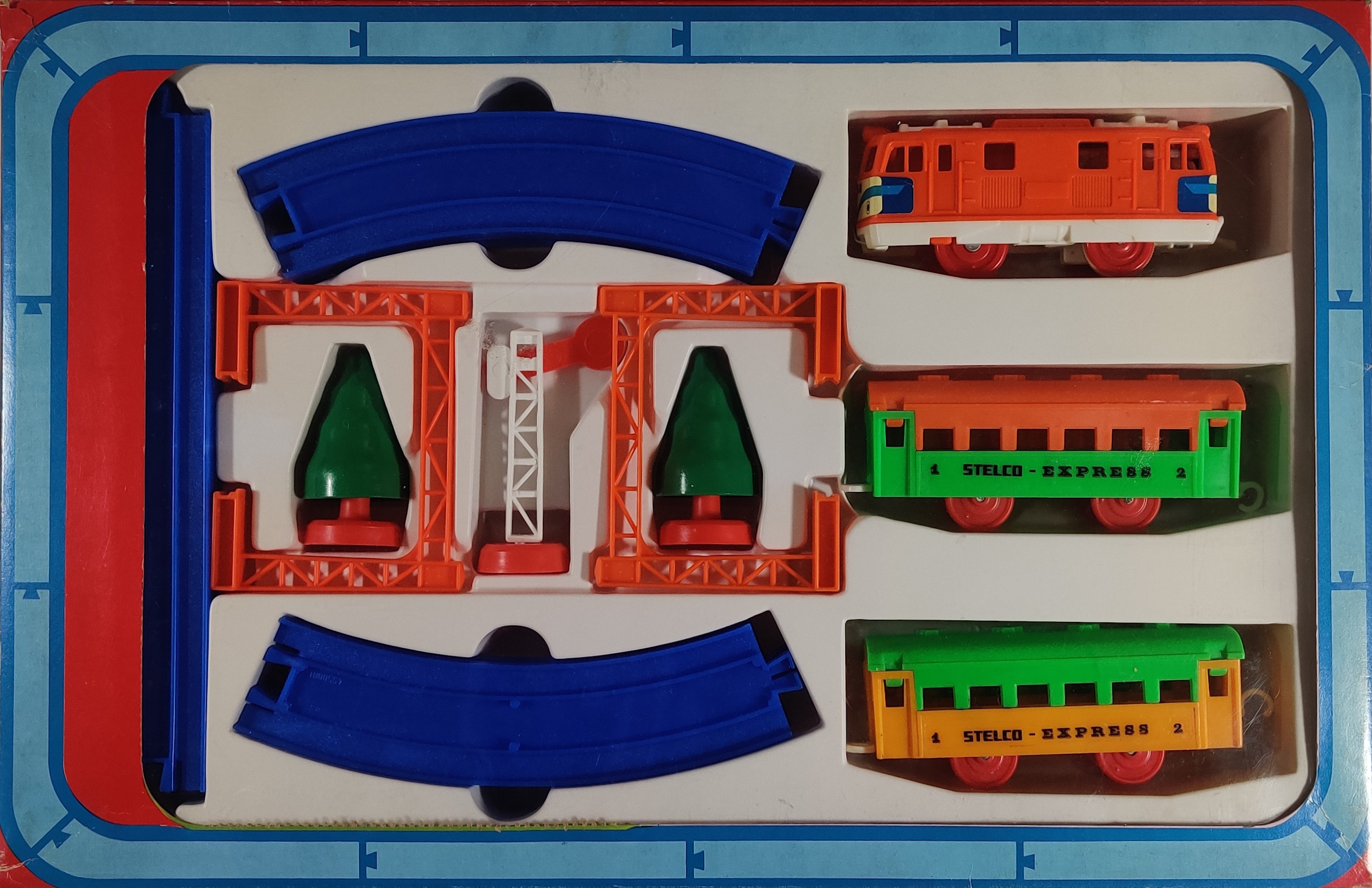
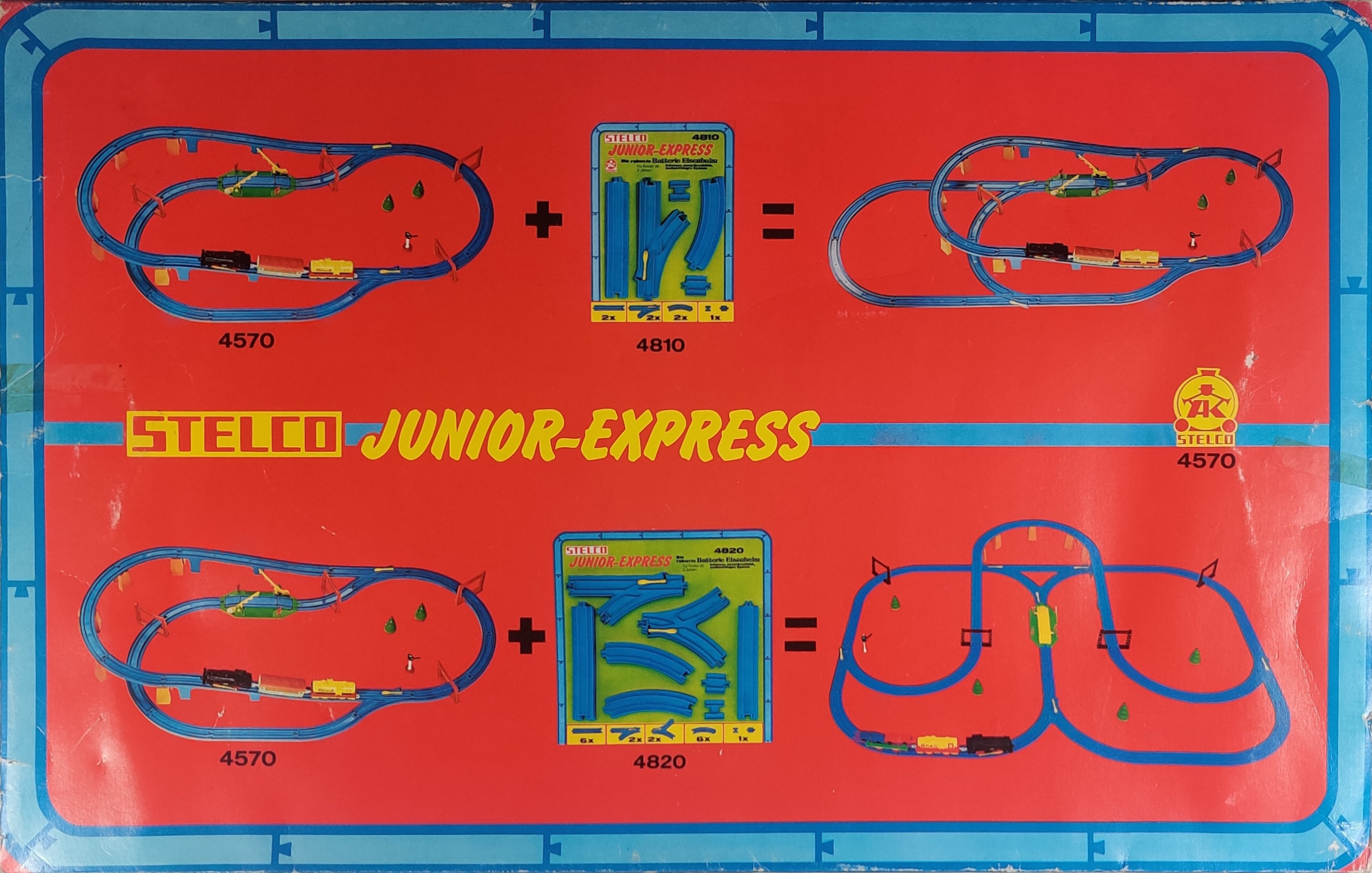
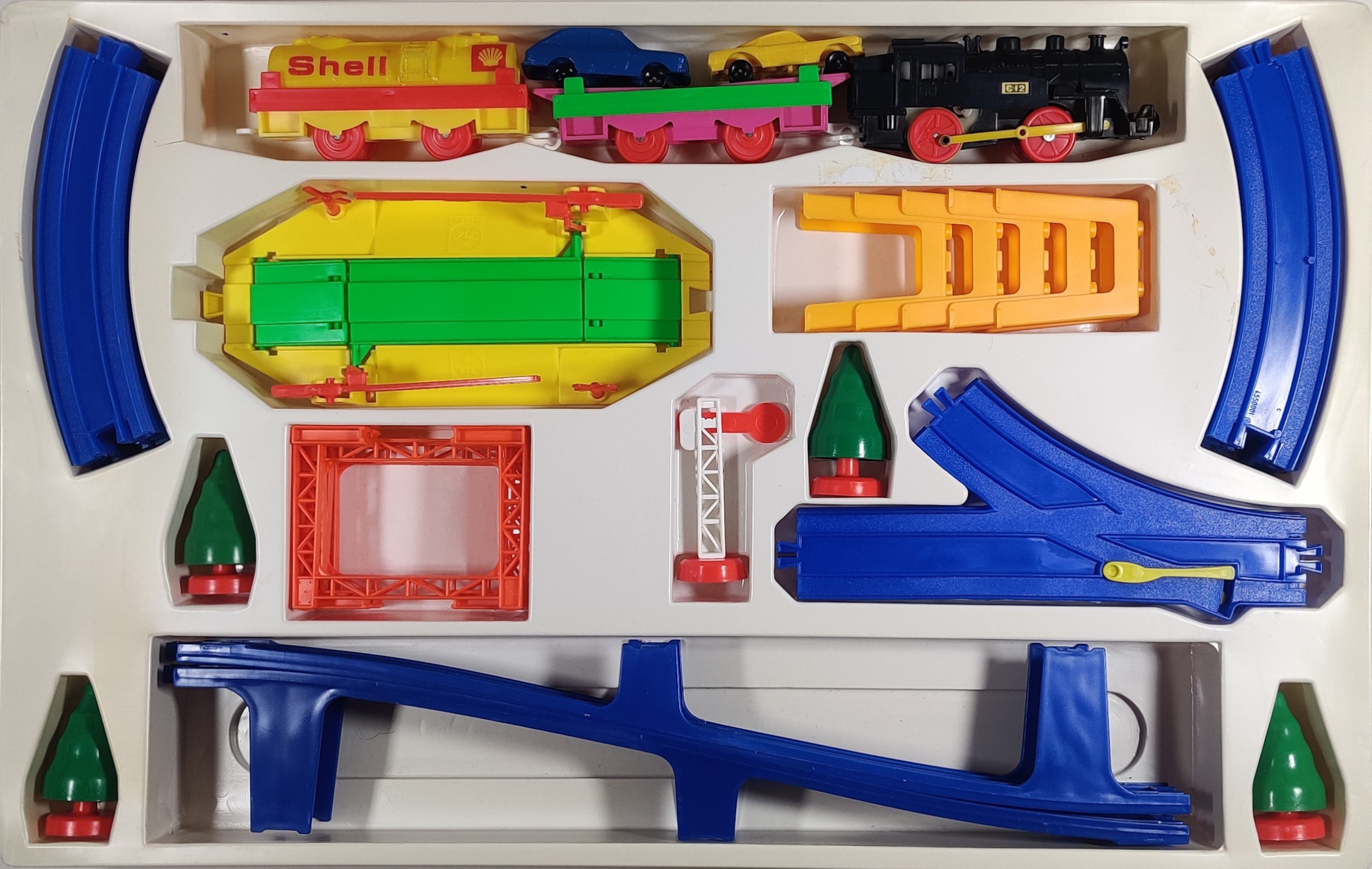
Stelco Junior Express was a West German toy train system based heavily on and using parts from Tomy's Plarail. Production began in the later 1970s and continued up into the early 1980s. Sets used locomotives produced by Tomy in Japan and Hong Kong with Stelco producing the rest of the rolling stock, track, and accessories. Track followed the Plarail standard and was a darker blue color. Most accessories were clearly based on the Plarail equivalents of the day and the rolling stock was a mix of original designs and adaptations from Plarail originals. Tomy later marketed the Tomy Express series of Plarail exports in Germany from 1989 into the early 1990s.
Most of the historical information about Stelco on this page comes from the FürthWiki. Their article on Stelco can be found here.
Stelco
Stelco first opened in 1935 in Fürth, Germany as Metallwarenfabrik Dr. Adolf Kürschner and produced metal toys. After moving locations both before and during World War II, the company began producing a variety of soft vinyl and plastic toys including many toy cars. In the later 1960s the company was passed down to Kürschner's son-in-law who renamed the company Spielwarenfabrik Dr. Adolf Kürschner - owner Stelter & Co. In the 1970s the company became known as A.K. Stelco and eventually just Stelco. Seemingly first to compliment Stelco's range of toy cars, Stelco became involved with Tomy in the mid 1970s. Tomy exported several of their Japanese parking garage toys for Stelco to market in West Germany with localized stickers and Stelco cars.
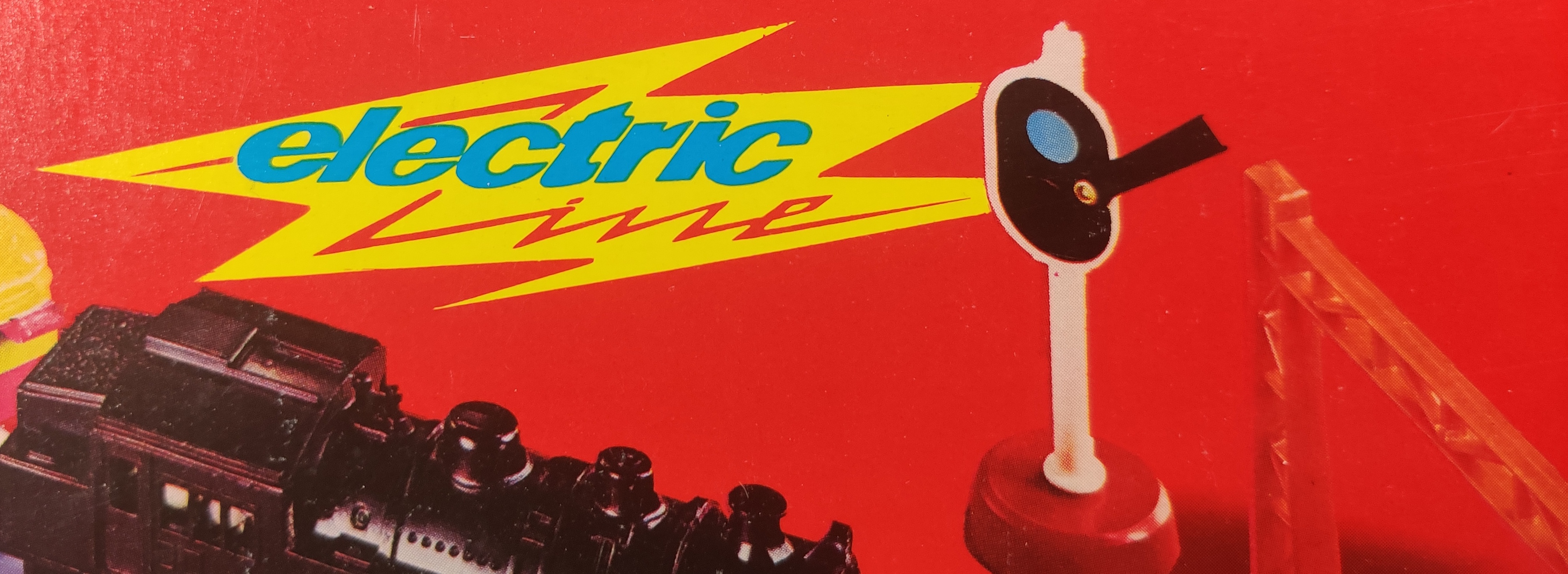
In 1976 a fire in the factory caused 5 million deutsche marks in damage. I believe it was after this point, perhaps late 1977 but maybe more likely 1978, that the Junior Express range was first released. I am not sure when exactly the first Tomy-Stelco deal occurred or if it was before or after the factory fire. By 1979 Stelco was bankrupt and in March 1979 Tomy bought out Stelco and began operating as Tomy Spielwaren GmbH. Although it does not seem that Tomy manufactured many toys in the factory after the early 1980s and European distribution was mostly through Tomy UK Ltd. by the mid 1980s, the Fürth office remained Tomy's German offices listed on European packaging and manuals at least into the early 1990s.
I do not know for sure, but it seems likely to me that either Tomy wanted to try exporting Plarail sets for Stelco to market locally as well, and Stelco decided that they would rather manufacture the rest of the components themselves than import rails and accessories and only imported the more complicated battery-powered locomotives, or that Stelco wanted to sell a train system as well as their other toys and were willing to make most of the components if Tomy could supply them engines (and a few original Plarail sets to adapt for toolings to use in their own factory). It does seem a little odd to me that Stelco would have embarked on this project seemingly after a large factory fire as they neared bankruptcy, especially producing so many of the components themselves with all new toolings when Tomy was already producing entire sets for export for Palitoy in Great Britain as well as under their own name in America around the same time. Perhaps there were other restrictions or complications on exporting or importing that made it easier for Stelco to only import locomotives instead of entire sets.
Many Stelco boxes show original Plarail components or a mix of Stelco and Plarail components. Presumably, these photographs included some of the example Plarail pieces that Tomy presumably sent over at some point on which the Stelco toolings were based.
Stelco locomotives
Locomotives in Stelco Junior Express sets were all produced by Tomy (in one way or another). It appears that the only two engines used in Junior Express were versions of the C-12 Steam Locomotive and EF58 Electric Locomotive.
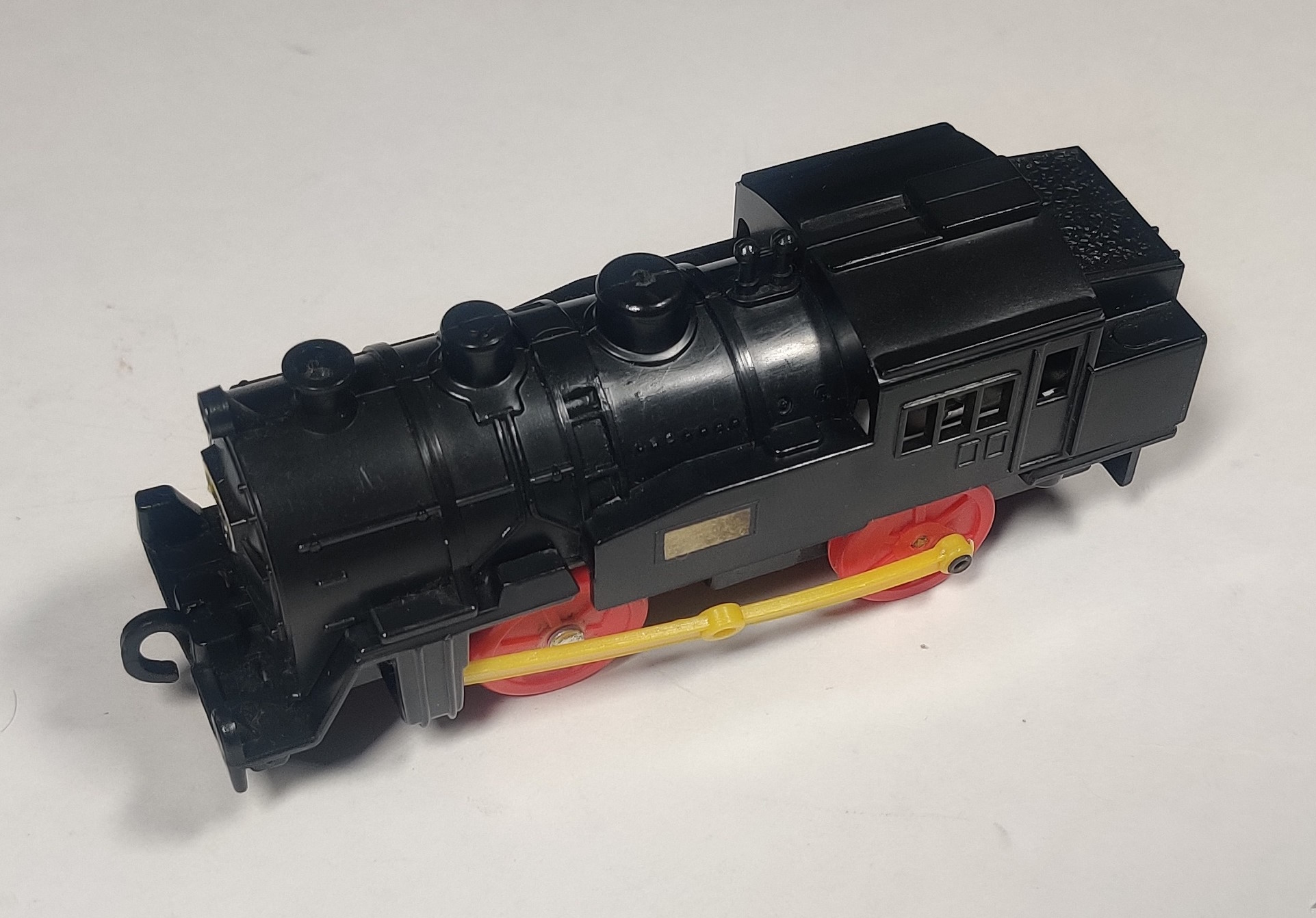
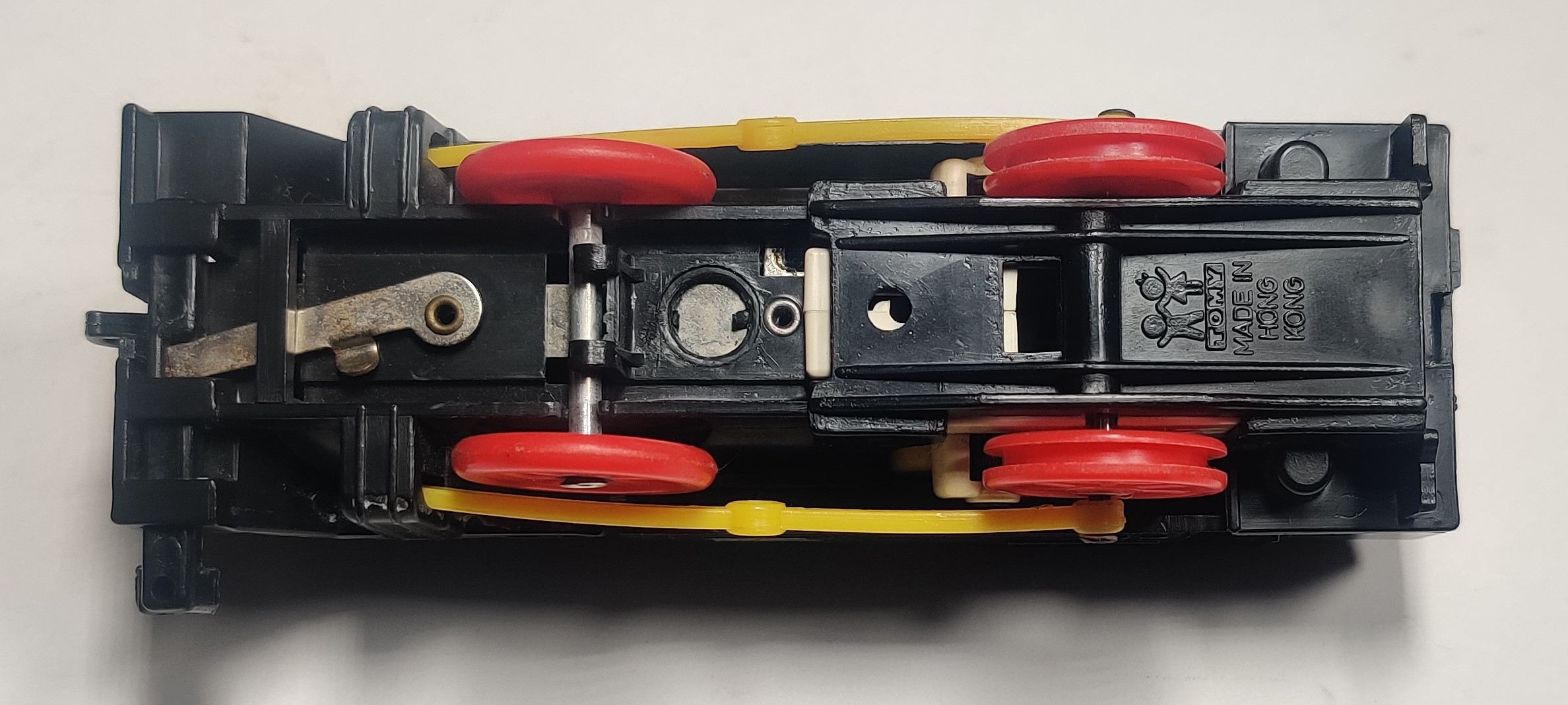
Early Stelco C-12s were produced in Hong Kong. These C12s use a plastic rim-drive gearbox and chassis tooling that seems to have been intended for a reversing Round-Trip C12, as the gearbox and chassis have all the necessary features to implement one, including the lack of activation tab catch and the cutout and supports for the reversing lever. This is explored in more detail on the Hong Kong C12 gearbox page. The example shown here is missing the side stickers, traction tires, and rear coupling (as well as some of the gearbox components), but these obviously would have originally been included.
I ended up using parts from a broken Round-Trip EF66 to convert this C12 into a reversing Round-Trip type.
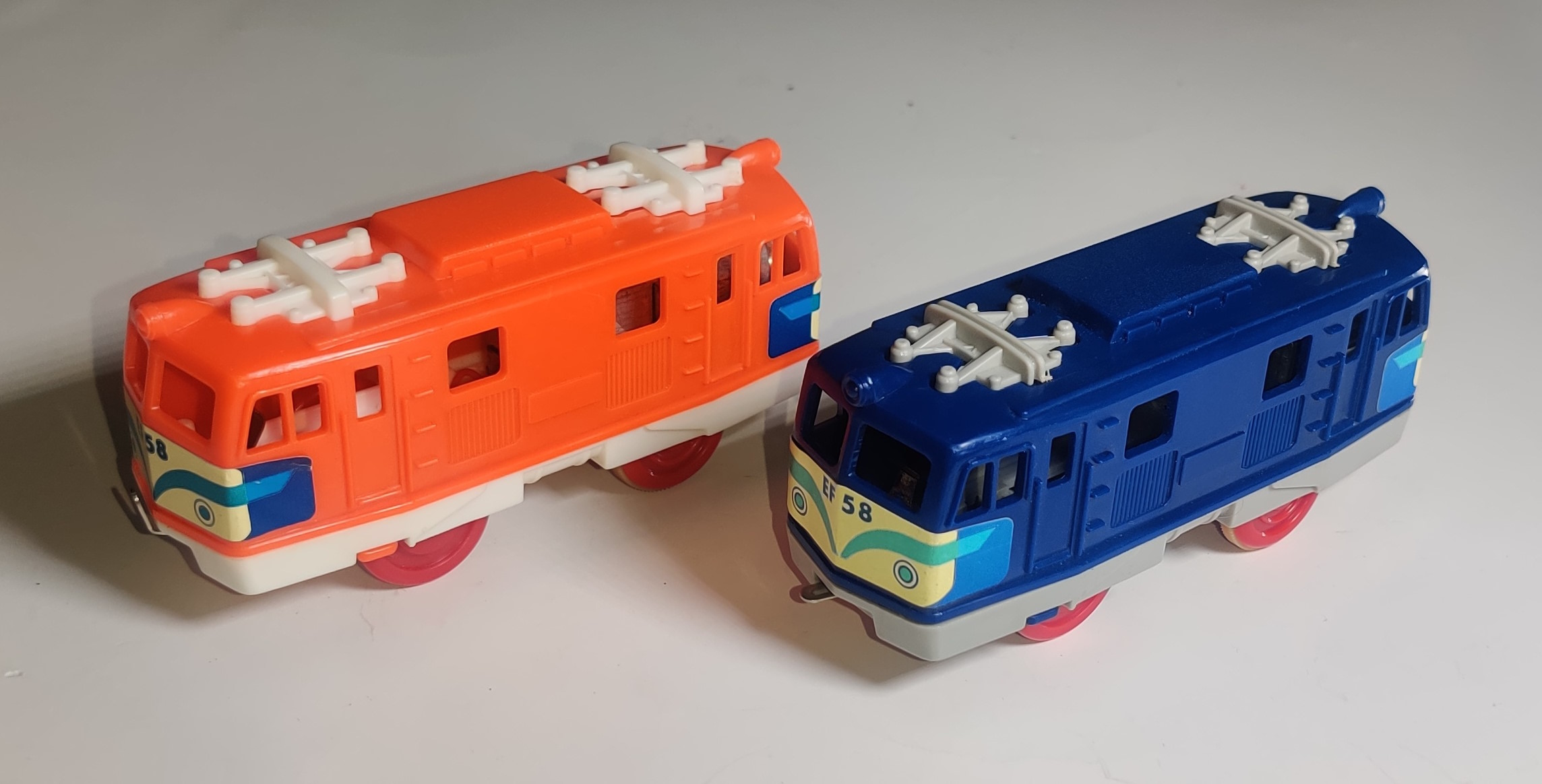
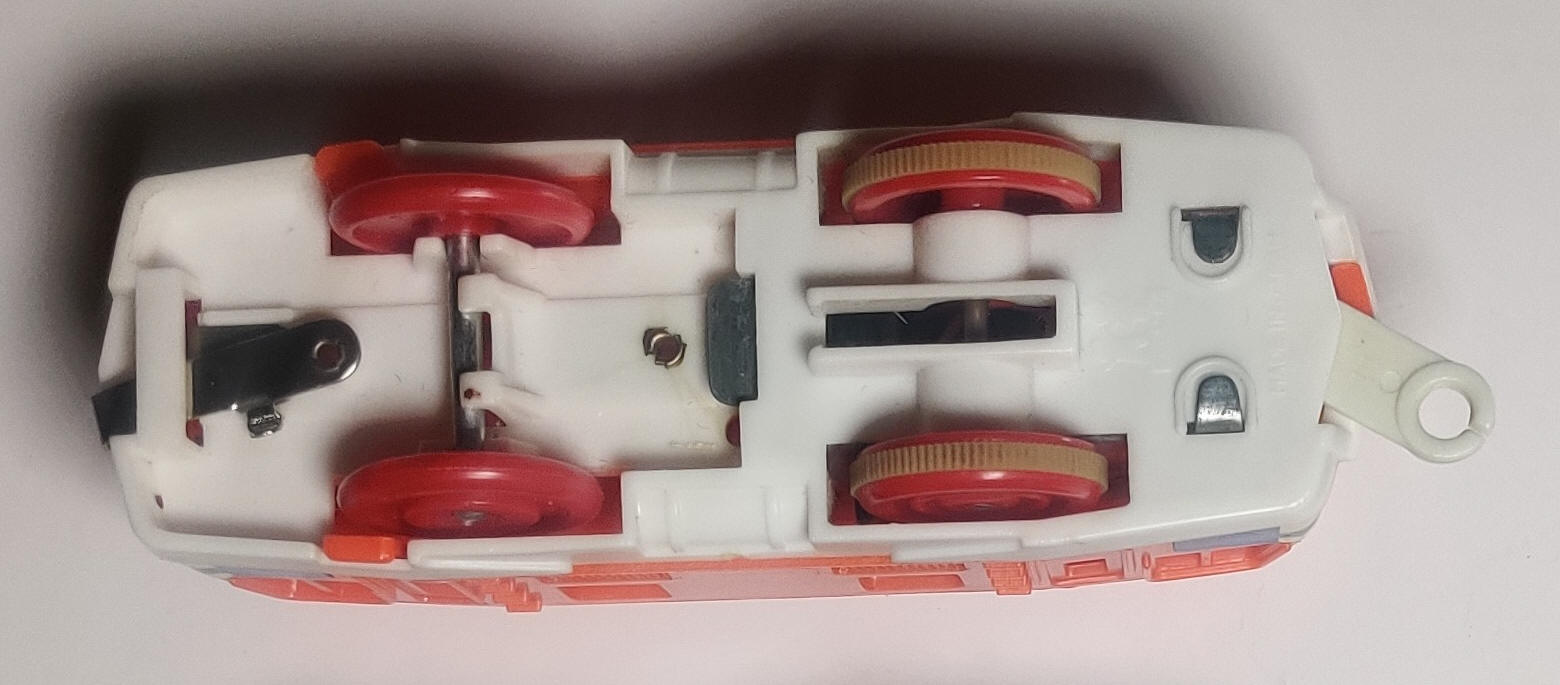
Circa 1979 an orange version of the EF58 was produced for Junior Express. This engine was included in some sets as well as individually and apparently with passenger cars. These locomotives were produced in Japan like the domestic version and have the early more fragile design of front axle support.
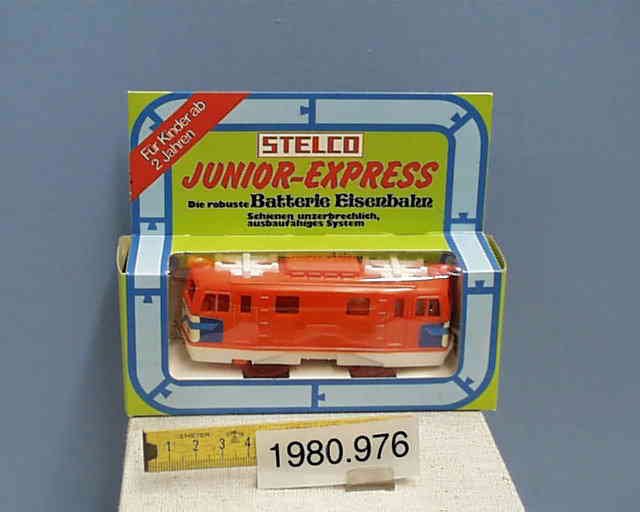
I do not own any of the individual release Stelco boxes, but I have found a few photos of them over the years. The internet forum I found this photo on seems to have gone offline, but it appears to potentially have been from an auction site at some point anyways, so I do not have an original or even second-generation source for this image. It seems to only exist online now because I posted it on Twitter a few years ago.
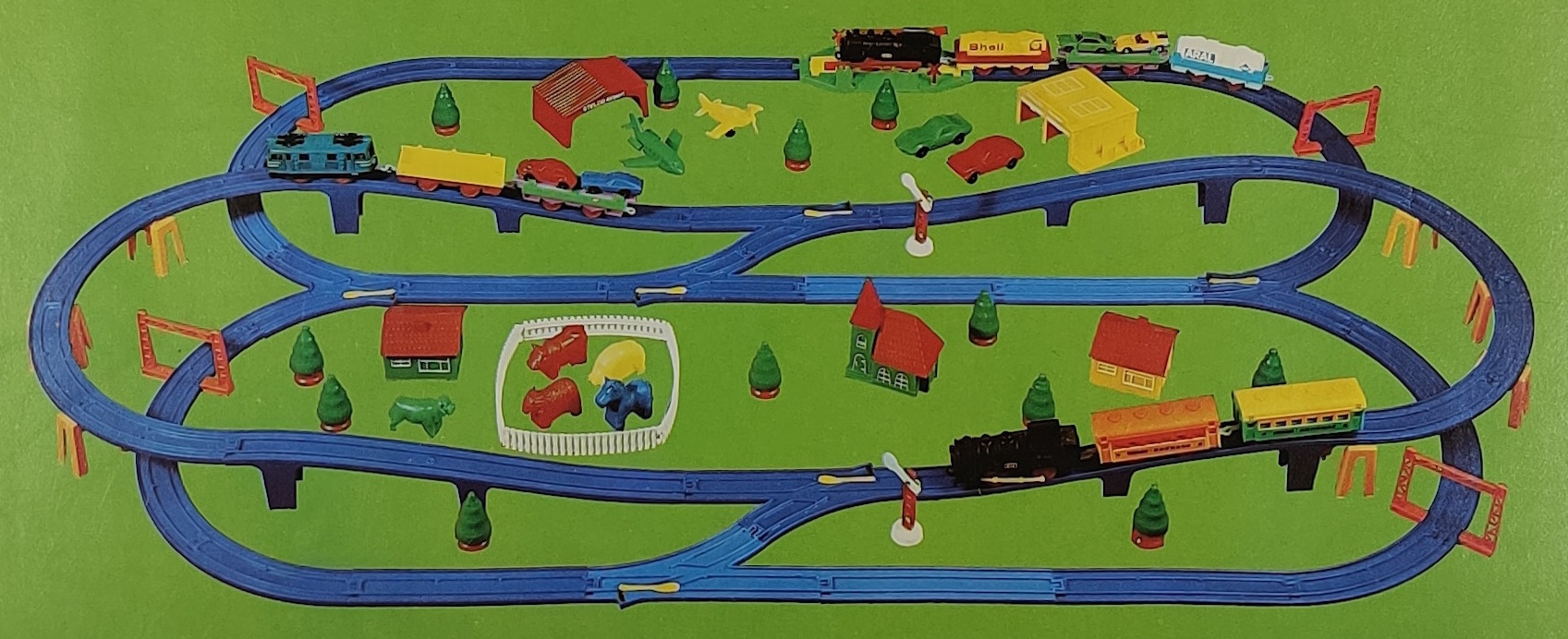
A version of the EF58 more similar to the Plarail one appears on some promotional layout photos, but this is probably just one of the regular Plarail pieces Stelco had on hand as Plarail track is intermixed into the layout and it does not appear a bluish or greenish EF58 was released in the Junior Express range.
The 1979-1980 Stelco catalogue, viewable here, also lists the C12 with well wagon and tanker as 4530 Steam Locomotive, 2 Freight Cars (Damf-Lok, 2 Guterwagen) and the EF58 with two coaches as 4531 Electric Locomotive, 2 Passenger Cars (E-Lok, 2 Personenwagen).
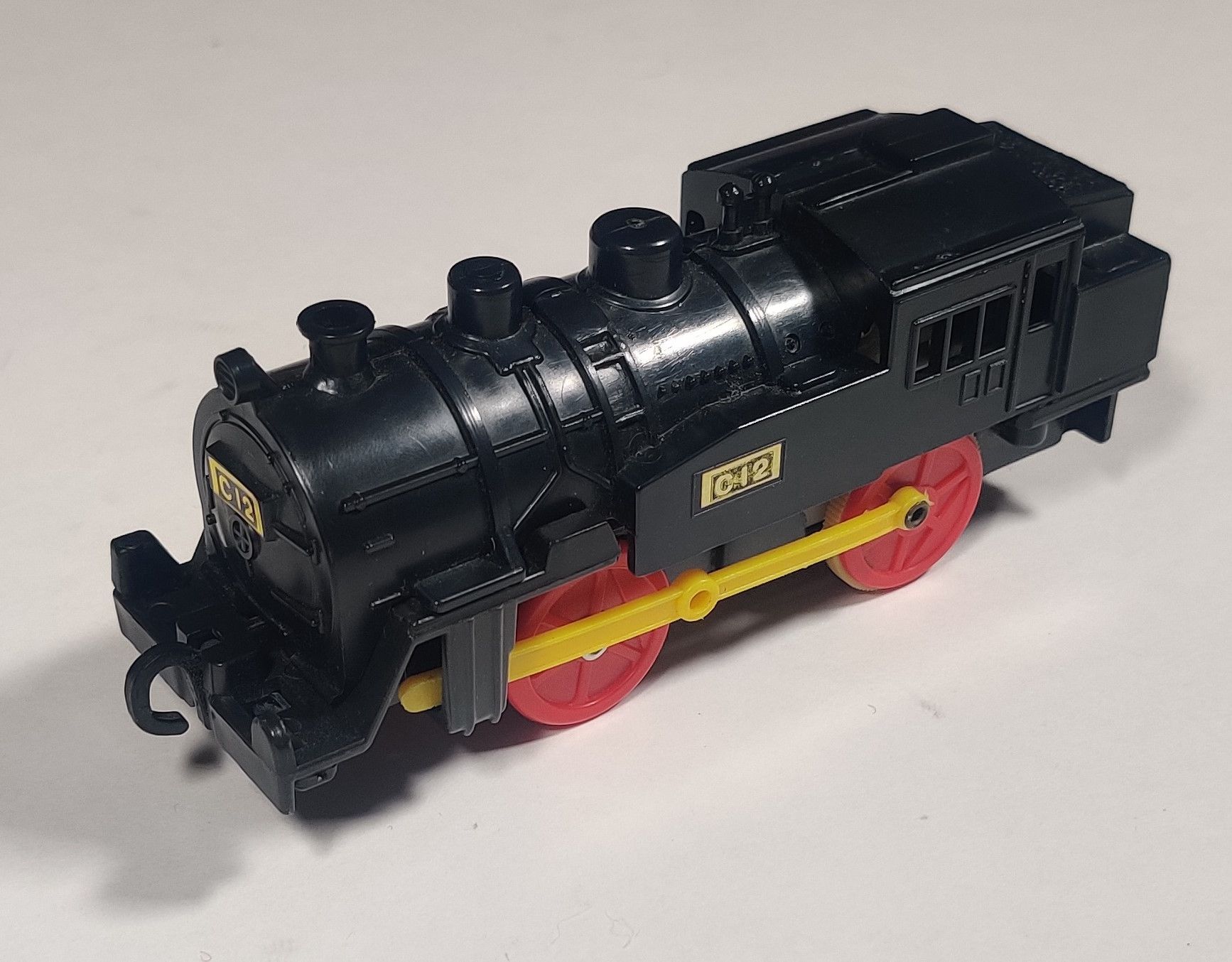
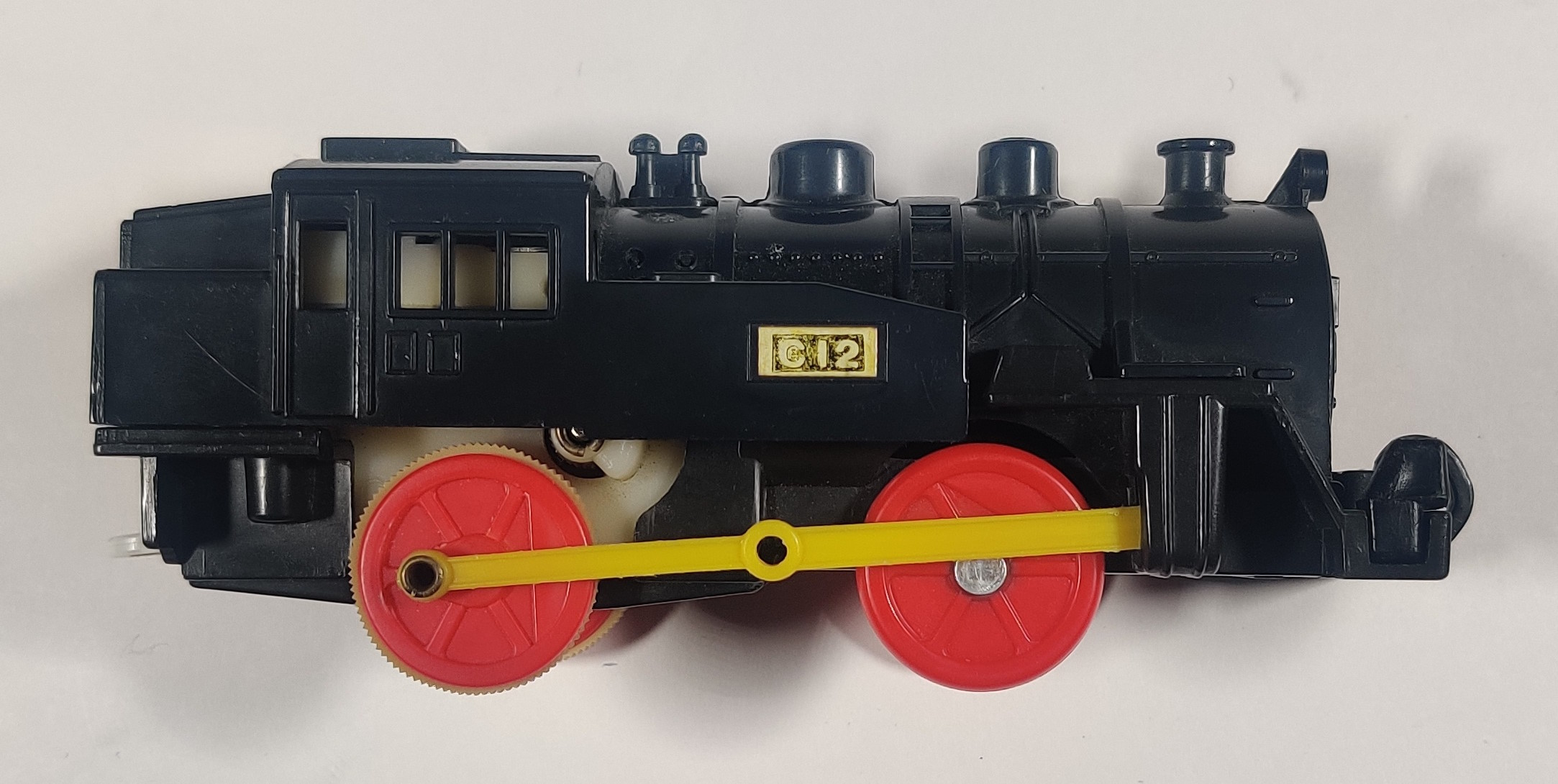
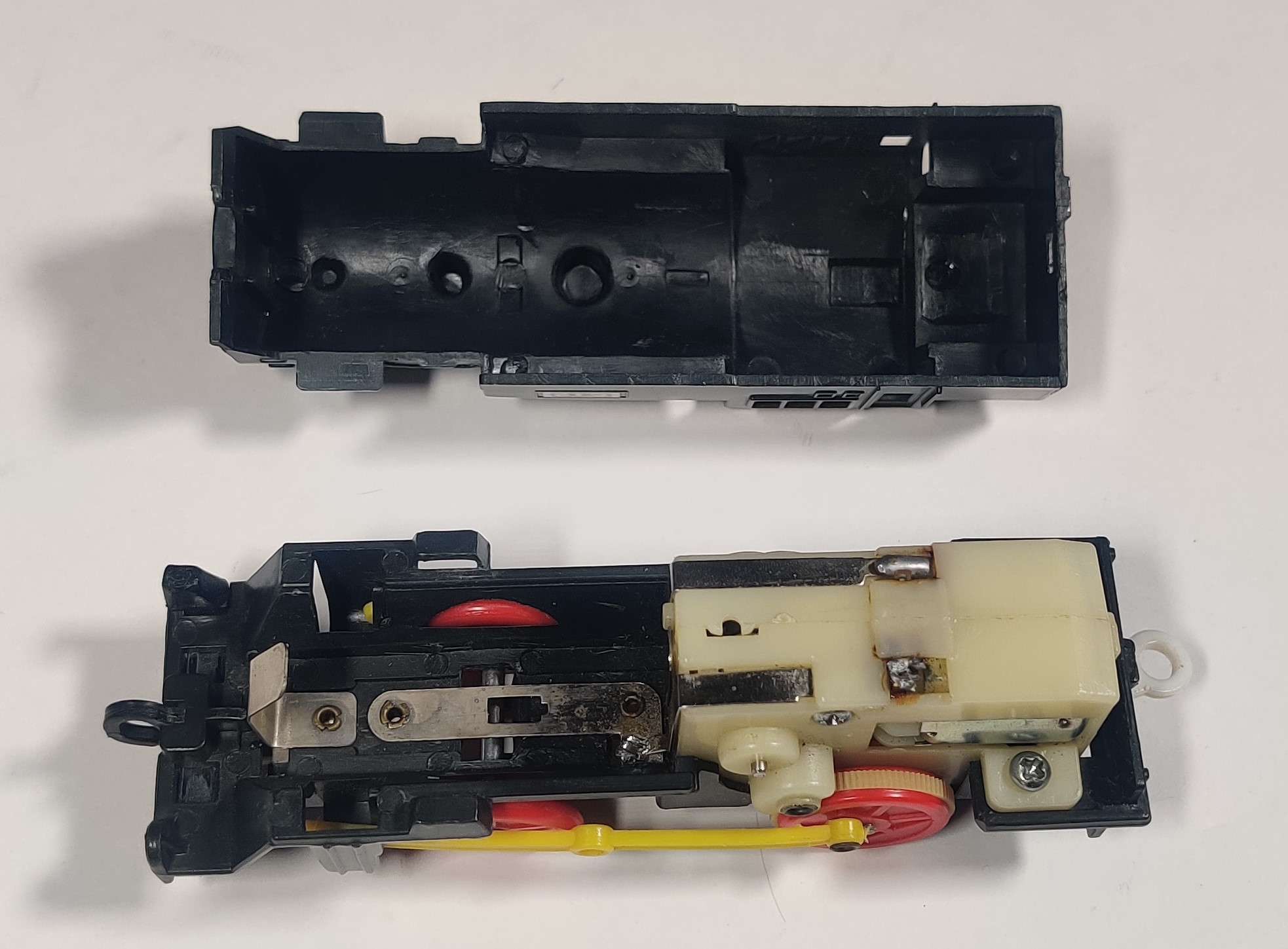
Also around 1979, the pneumatic whistle-powered "stop and go" station was adapted for some sets, and the C12 molding was changed to include the activation tab catch to work properly with the station. These C12s still use a reversing-capable gearbox but do not have the chassis cutout for the reversing lever. These C12s still use the older style of coupling rods with metal pins, presumably because none of the new toolings had been moved to Hong Kong.
After Tomy bought out Stelco in March 1979 it seems Junior Express continued to be produced for a short time. Instead of being produced in Hong Kong, it was seemingly decided to produce C12s locally in Germany with a new tooling. This "Stelco" C12 was only produced after Tomy had bought them out and taken over operation and uses a direct-drive gearbox with an angled motor, with some other strange changes like a yellow power switch lamp and raised C12 text instead of stickers. This version of the Stelco C12 can be seen in this blog post from the chairman of the Plarail Museum about a late 1979 Junior Express Stop + Go set.
Stelco rolling stock
Like everything other than the engines, rolling stock in Stelco sets was all produced in West Germany by Stelco.
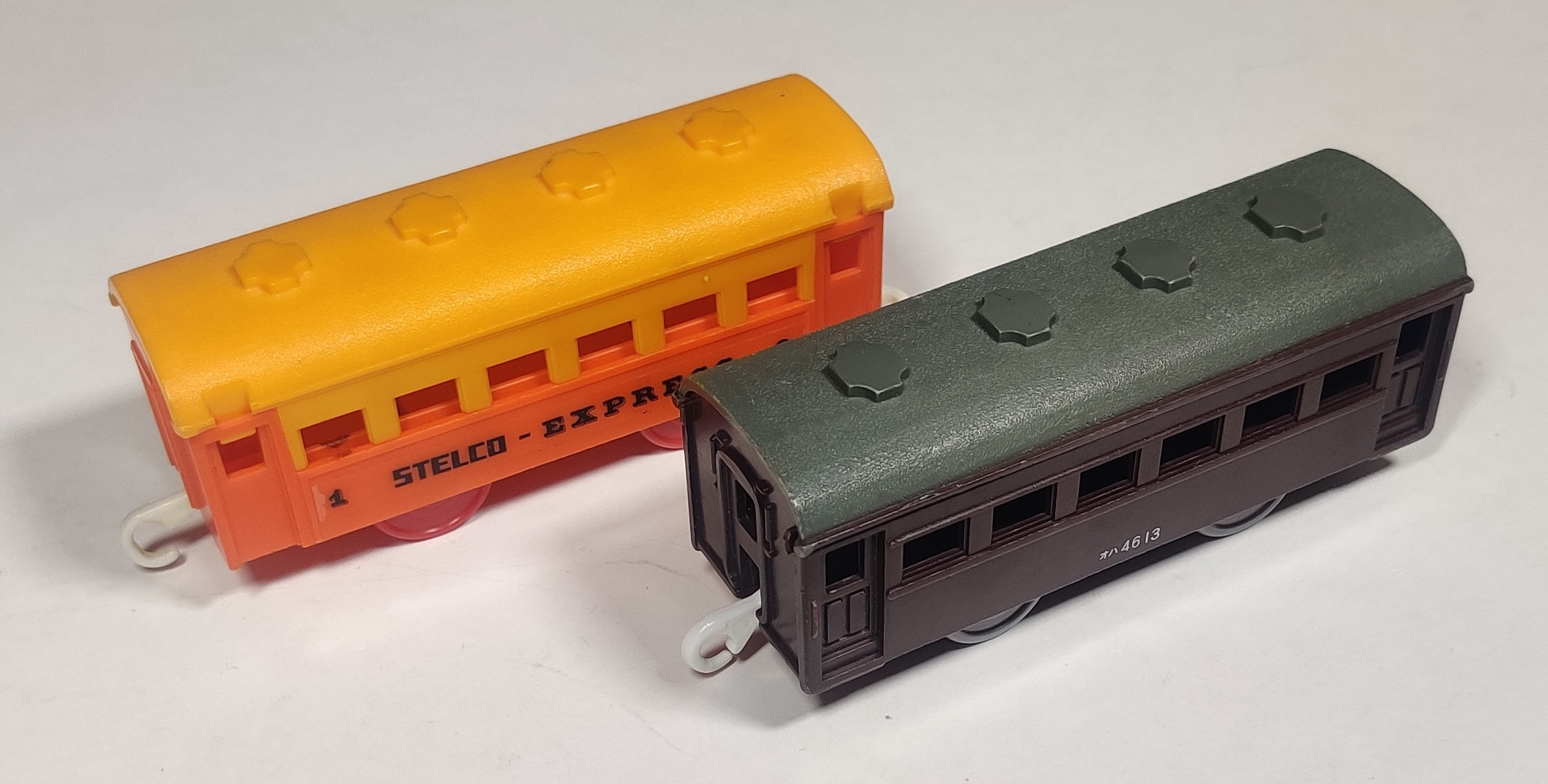
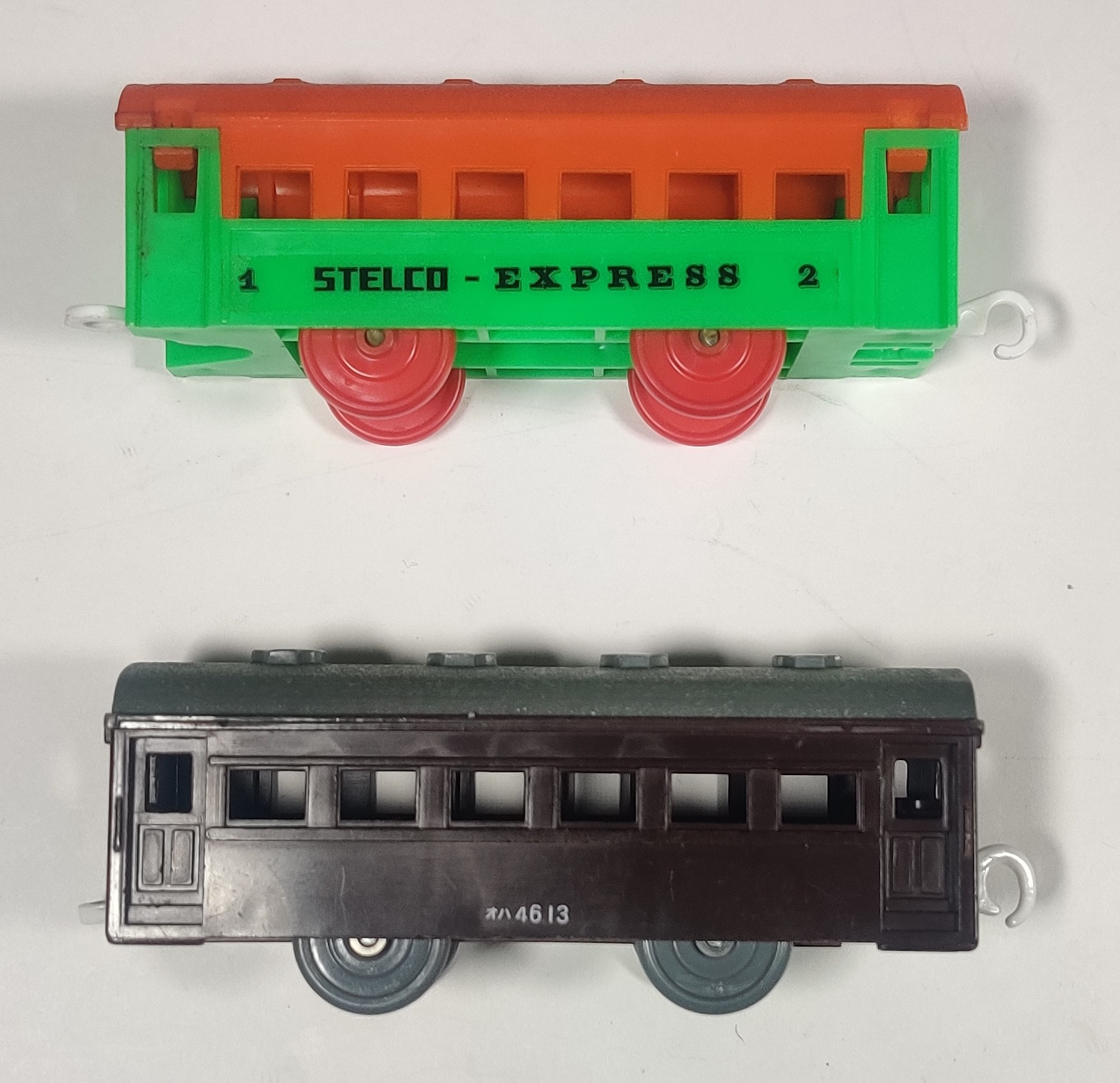
The Stelco passenger cars are based on the design of 1970s Plarail 43-series passenger cars but adapted for Stelco production. They have similar textured roofs and share many other details.
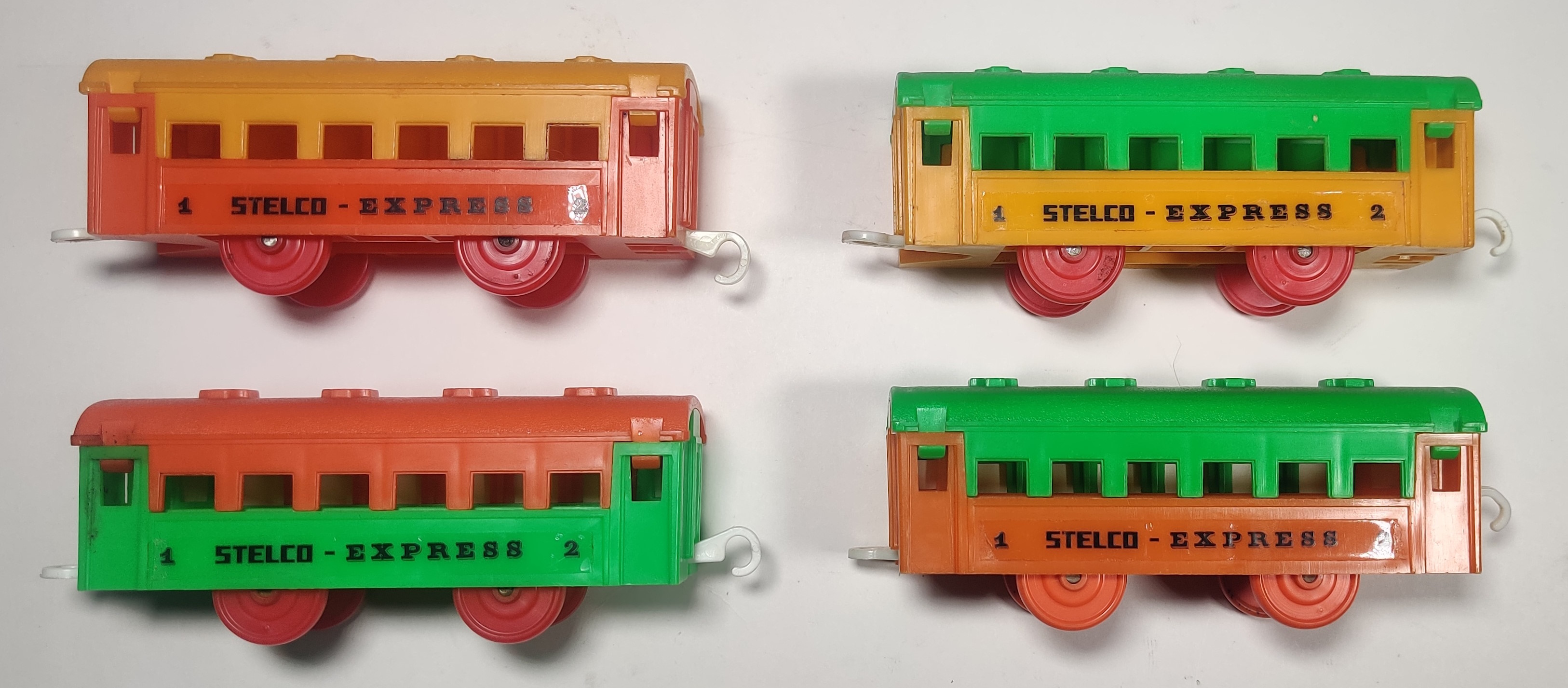
These passenger cars come in a variety of color combinations. A color-swapped version of the upper left car appears in the 1979-1980 Stelco catalog, and other similar color combinations from the three colors that appear to have been used may exist. The deeper orange carriage with green roof has orange wheels instead of the red ones used on other cars.
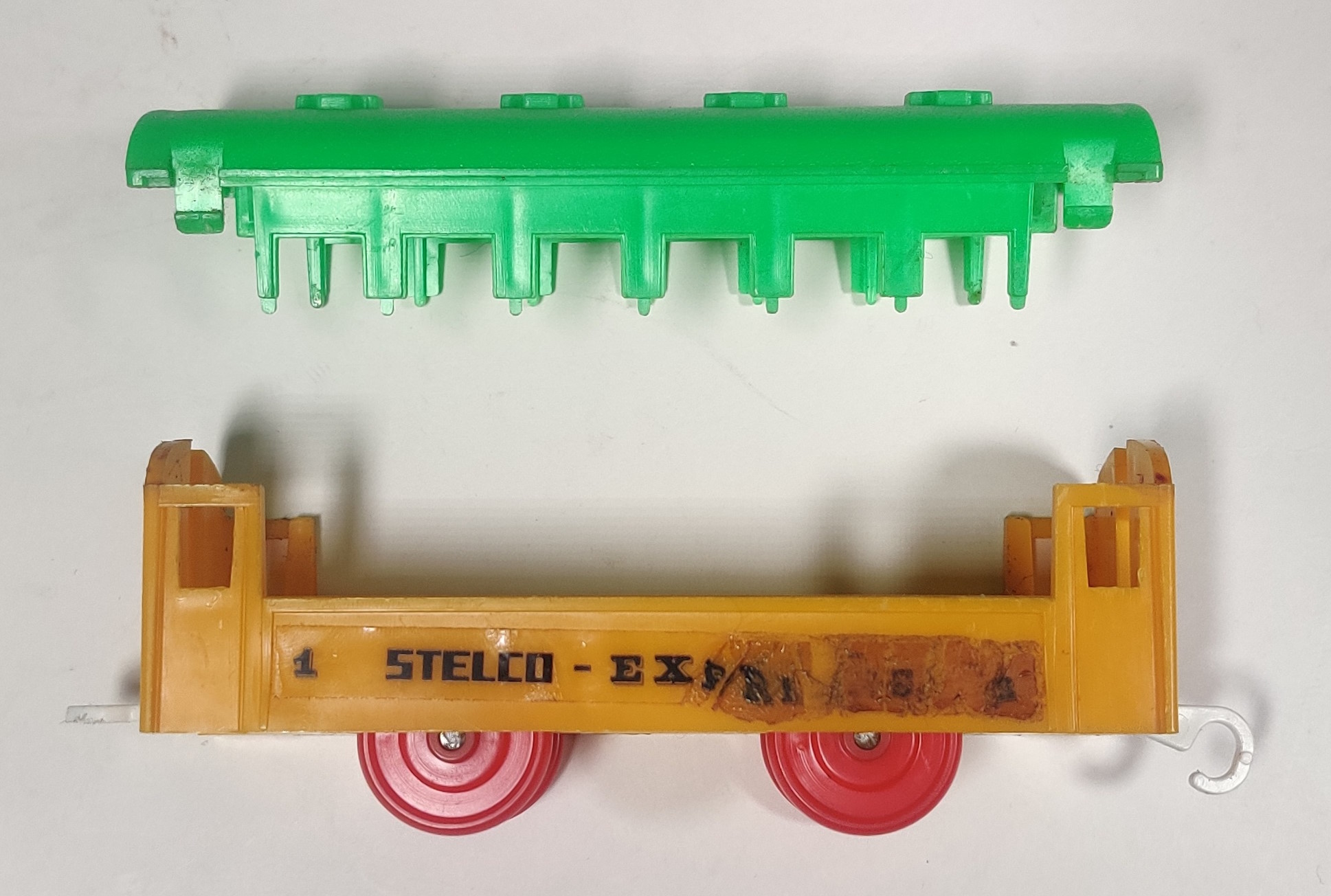
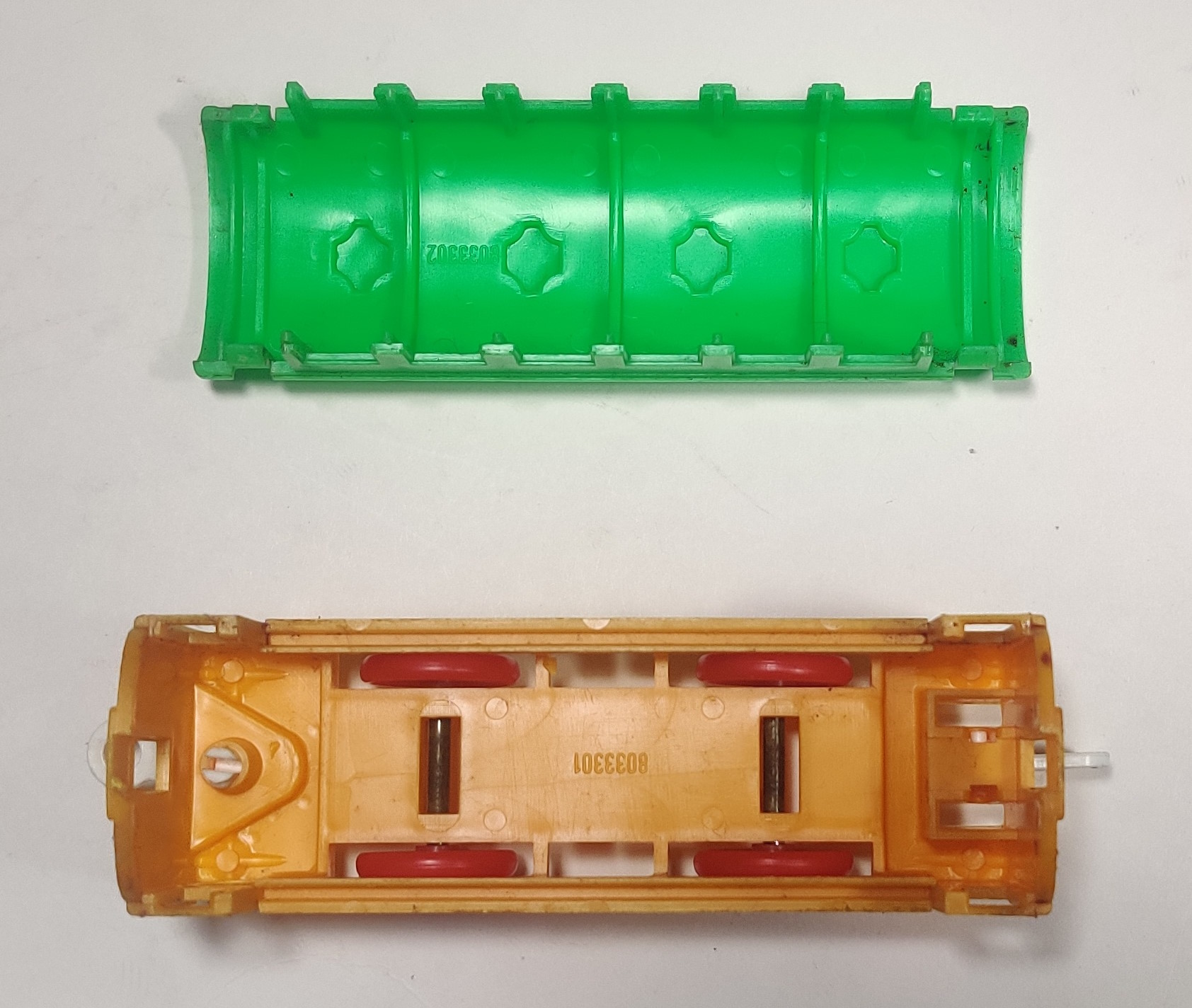
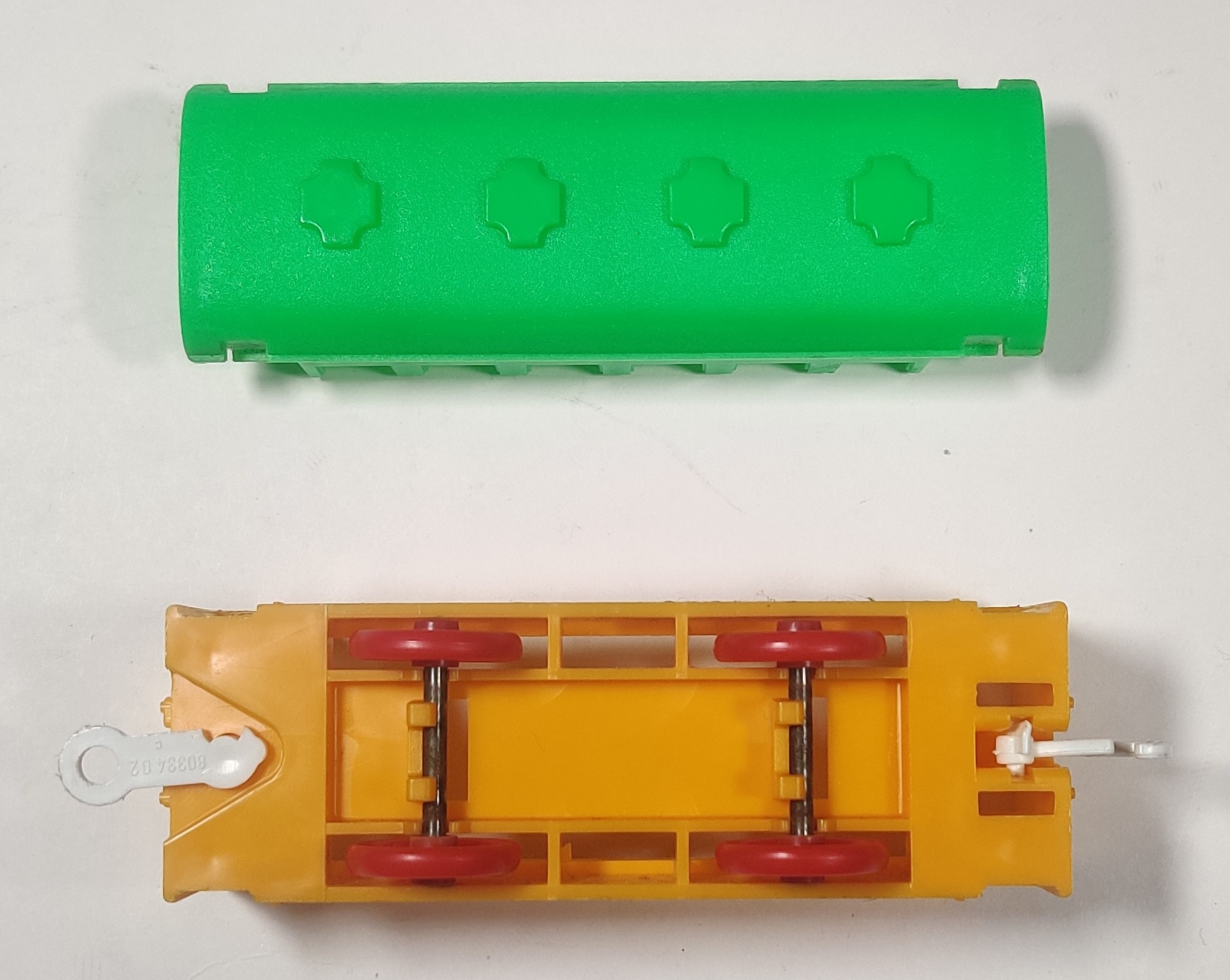
Instead of having a one-piece body shell that screws into the chassis, the roof and window frames clip into the chassis which includes the sides and doors of the carriage. The chassis and roof molds both include number codes.
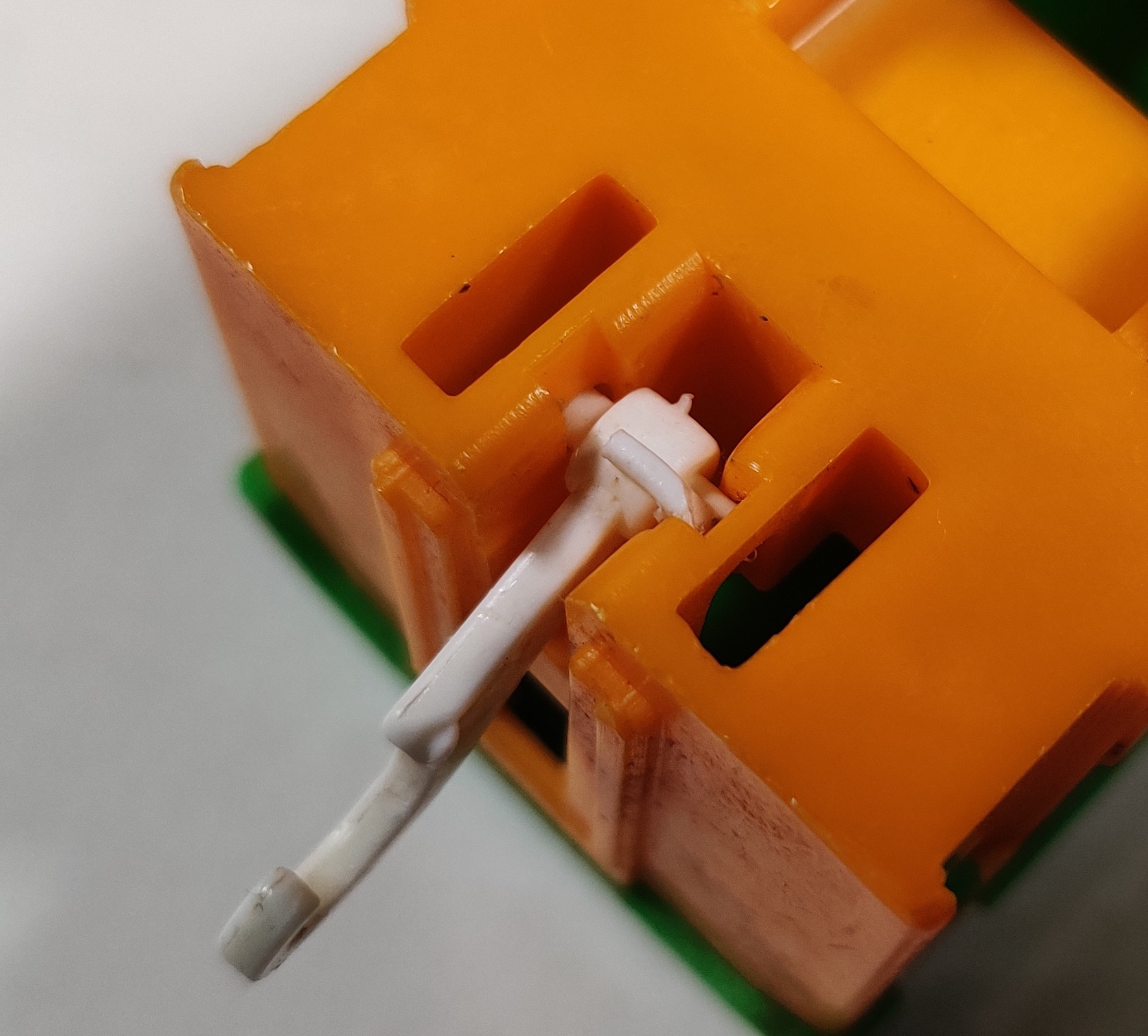
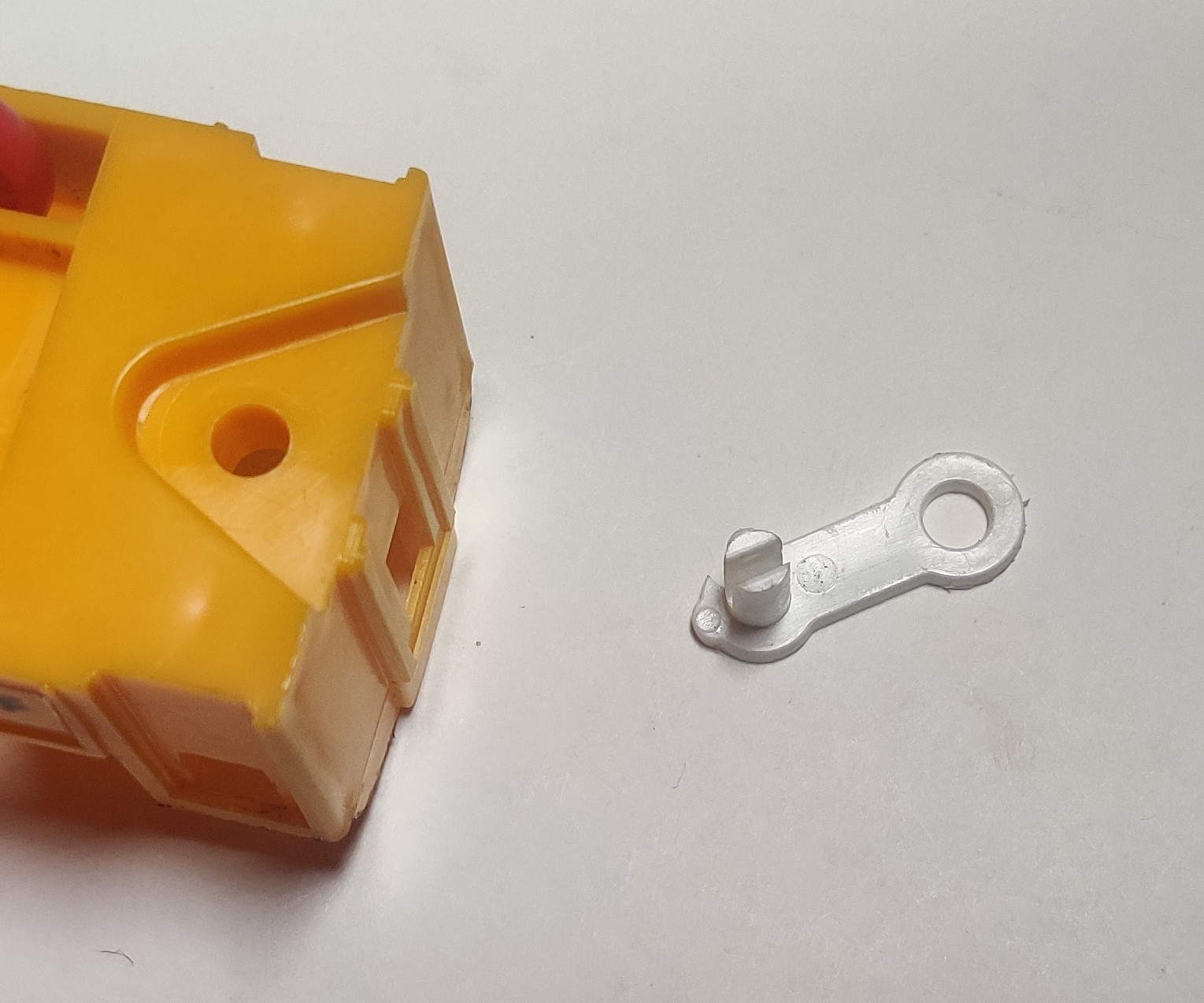
The coupling system is similar to the older 1970s design but with some changes with how they are connected to the chassis. The front coupling has a protrusion that restricts its movement up and down and the rear coupling clips into place instead of being anchored around a peg in the molding.
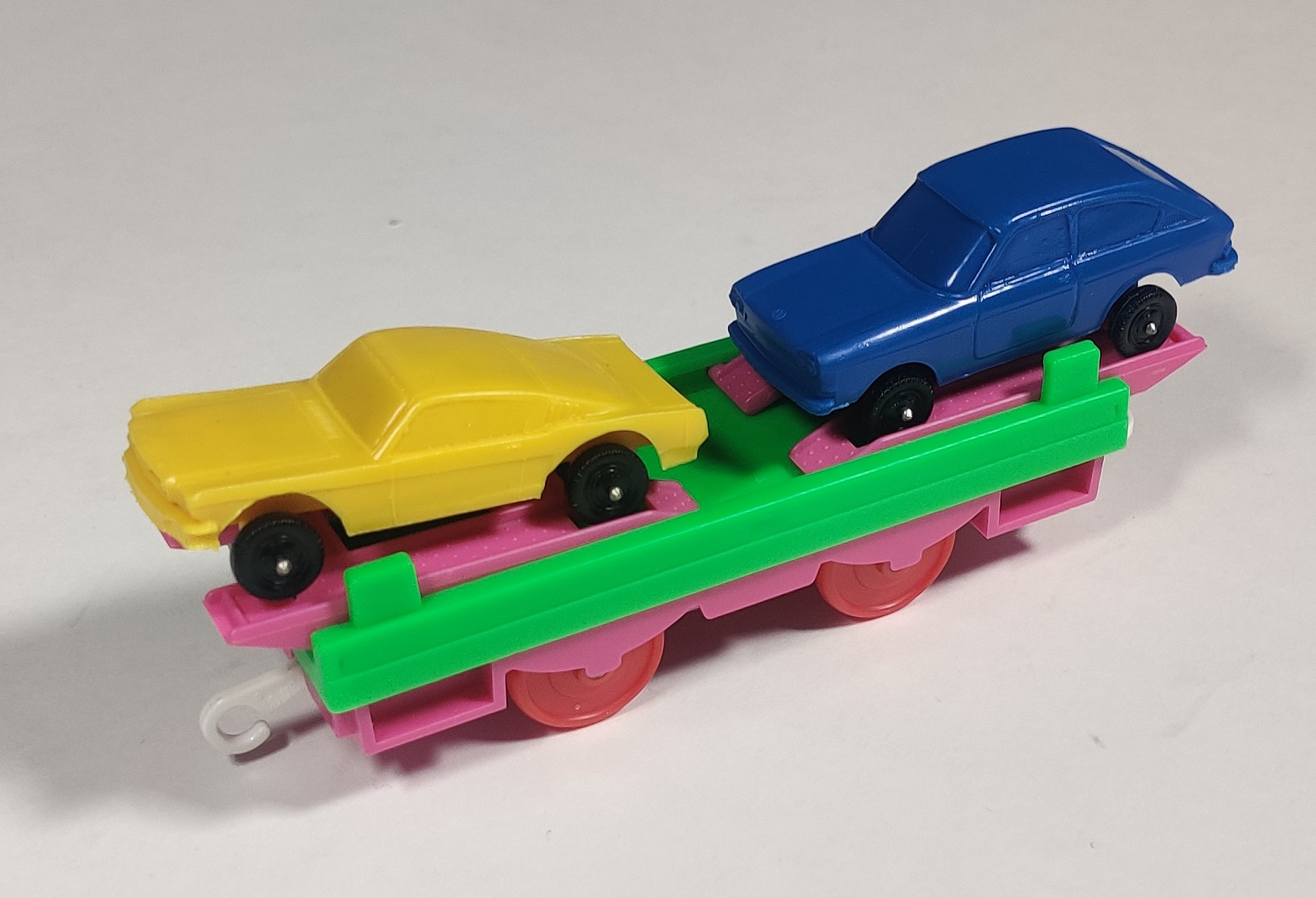
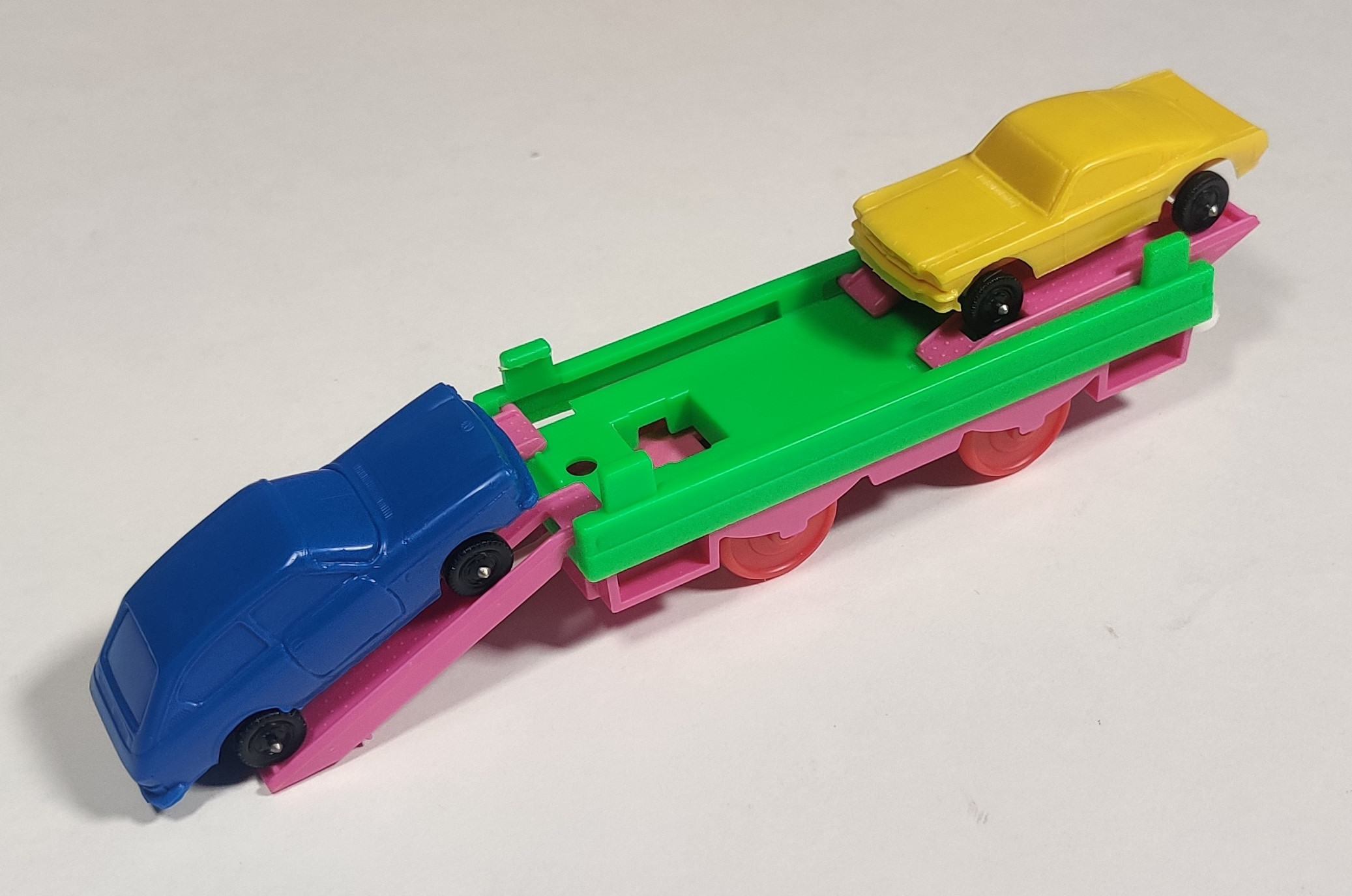
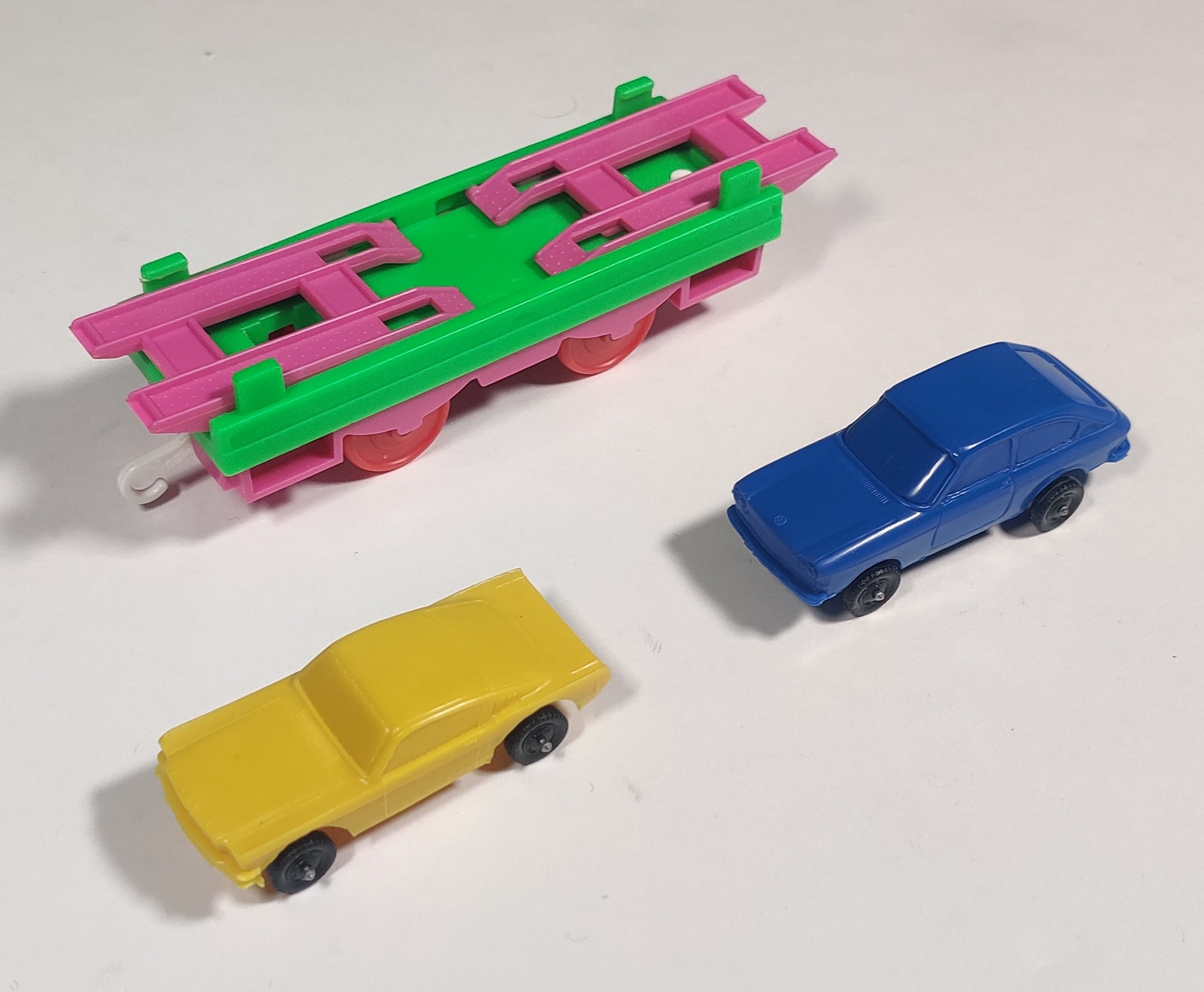
One of the coolest Junior Express pieces is this auto carrier which can carry two of Stelco's soft vinyl cars. The operating ramps slide out to allow cars to drive up. Although Plarail had produced a few auto carriers before this point, the design of this car is completely original to Stelco. A yellow and red version is shown on some boxes, and I have also seen a version with purple ramps and the white and blue chassis shown on the Aral tanker below.
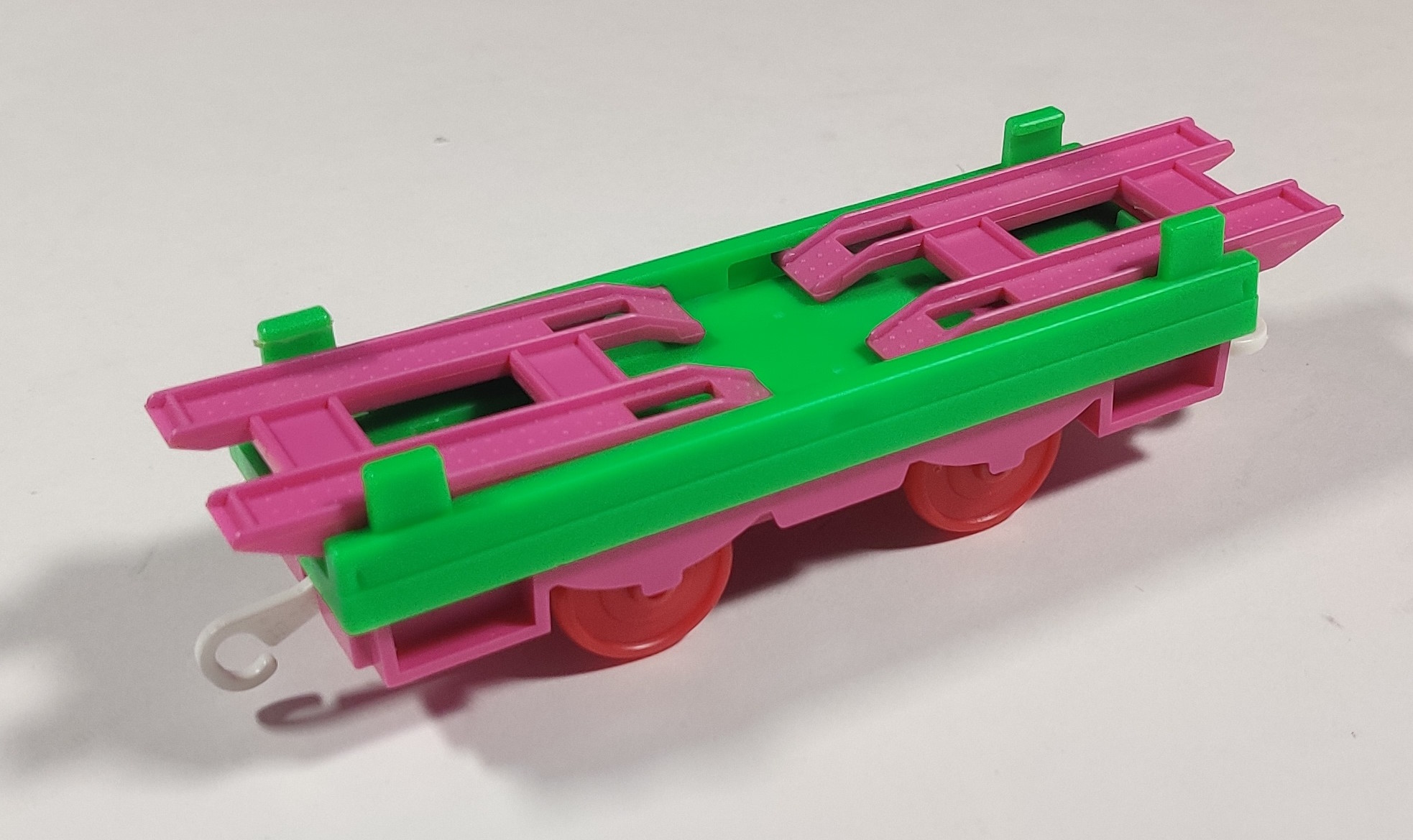
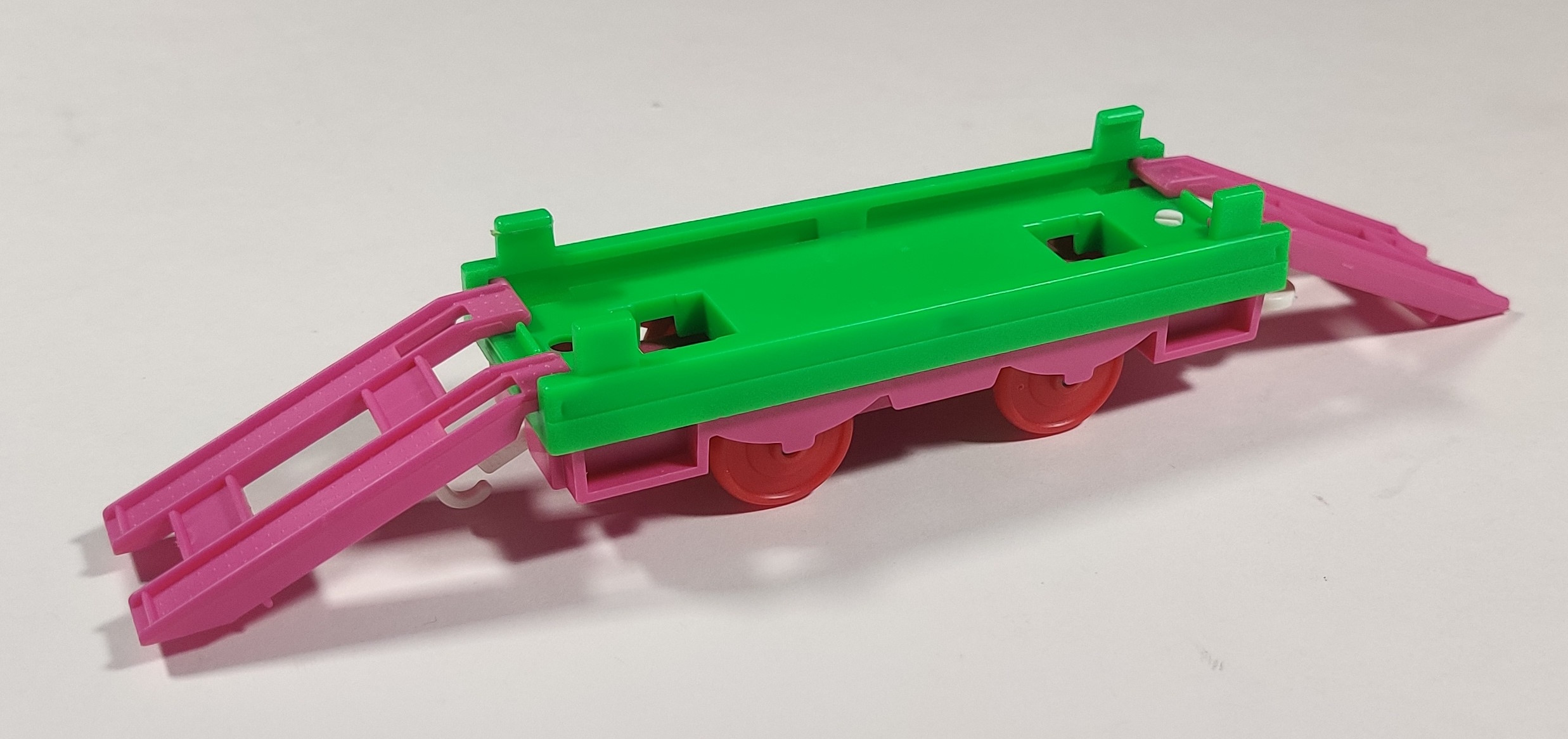
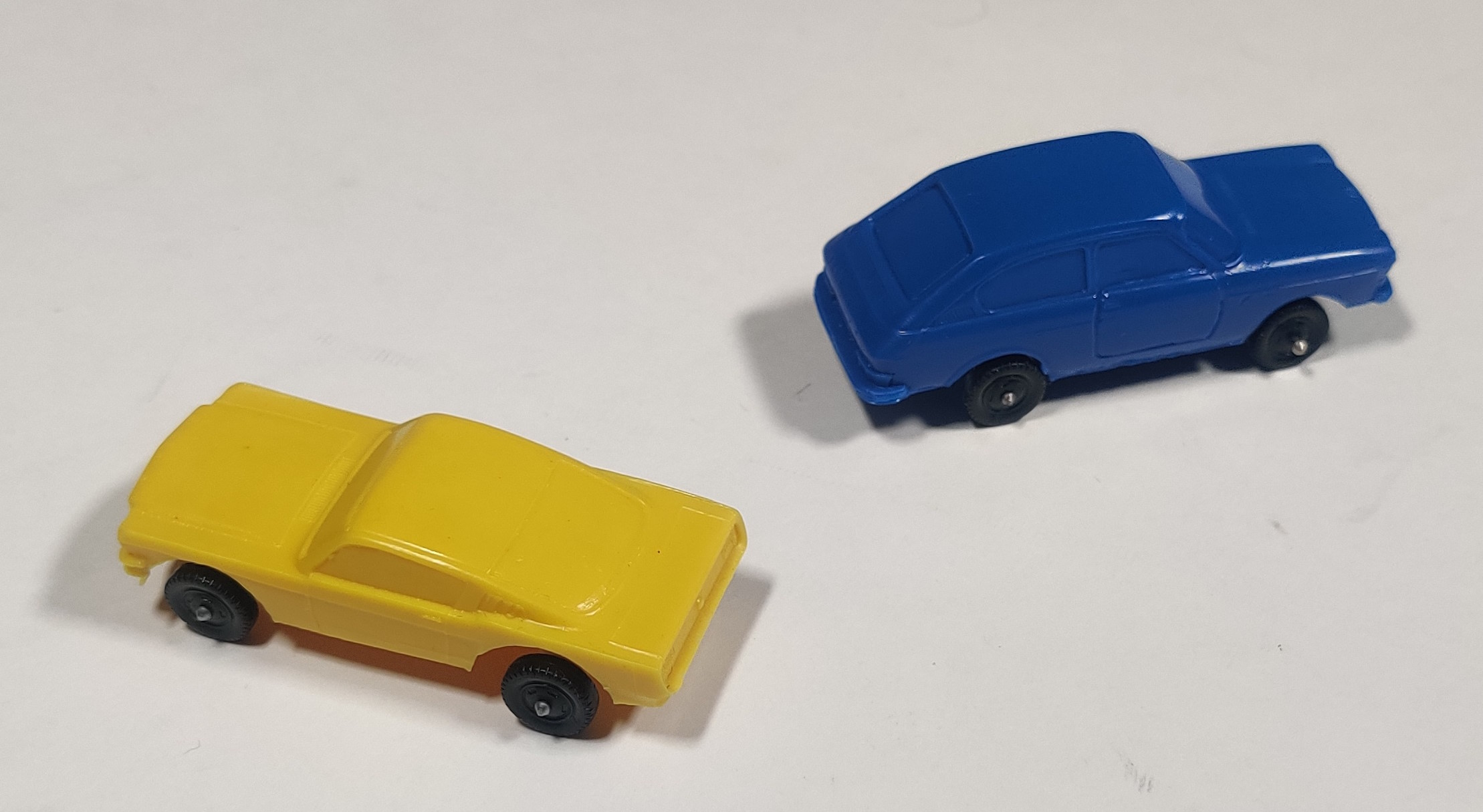
The ramps on the auto carrier overhang the couplings and may be part of the reason the electrical catenaries have been widened. The cars are nicely molded from a single shot of soft vinyl with metal axles and were produced separately for other Stelco toys.
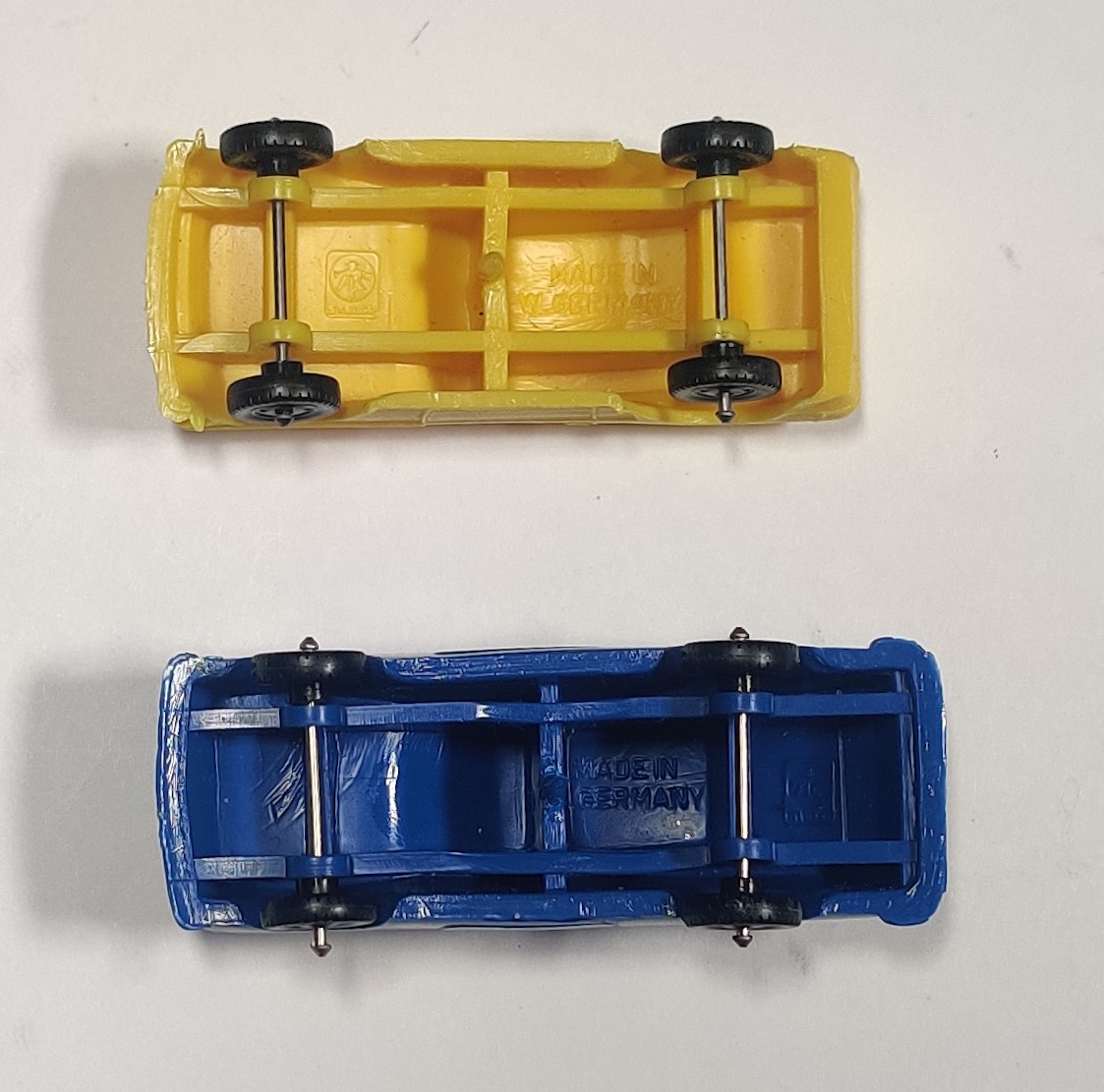
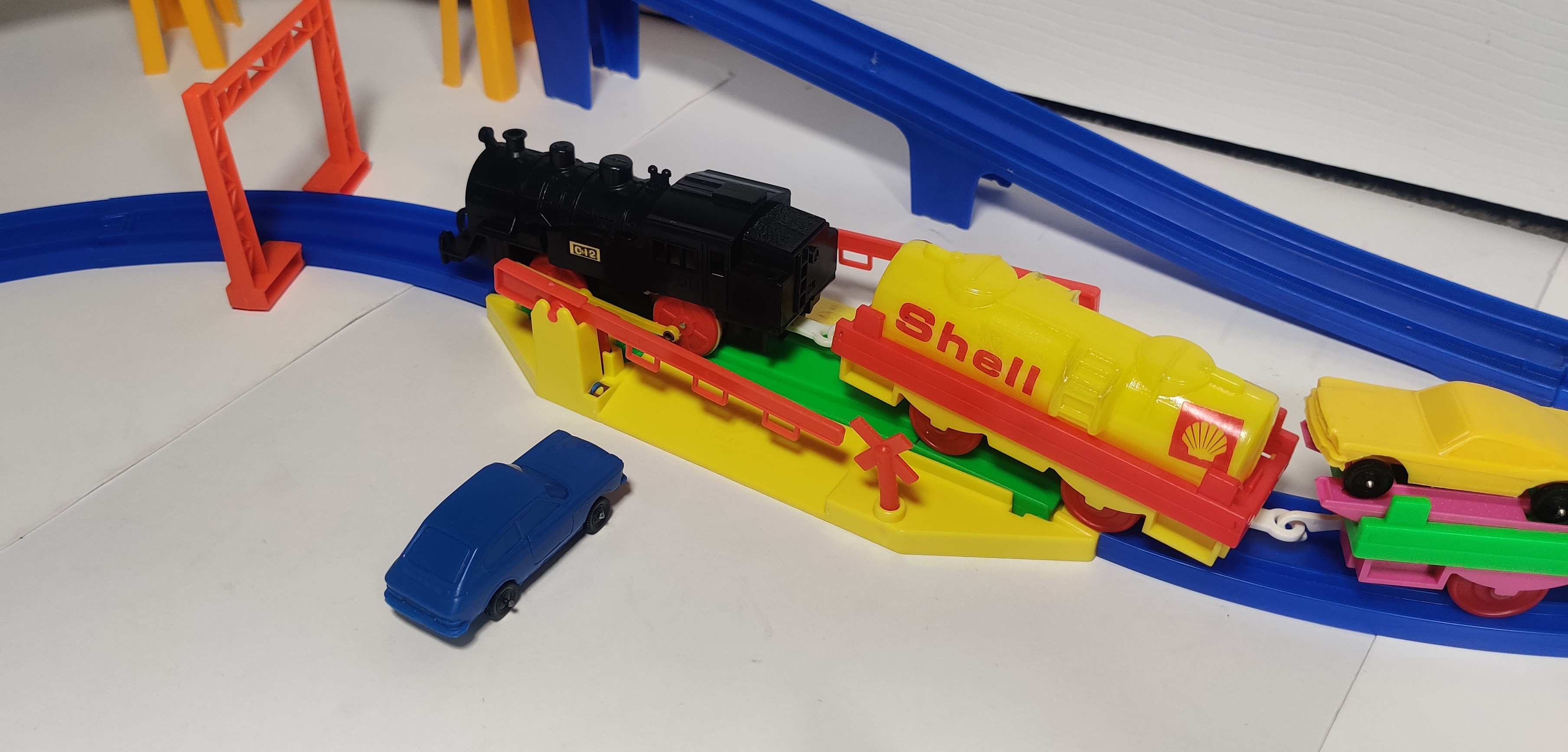
The cars are marked with the Stelco logo and made in W. Germany on the bottom. The toy cars work nicely in sets with railroad crossings.
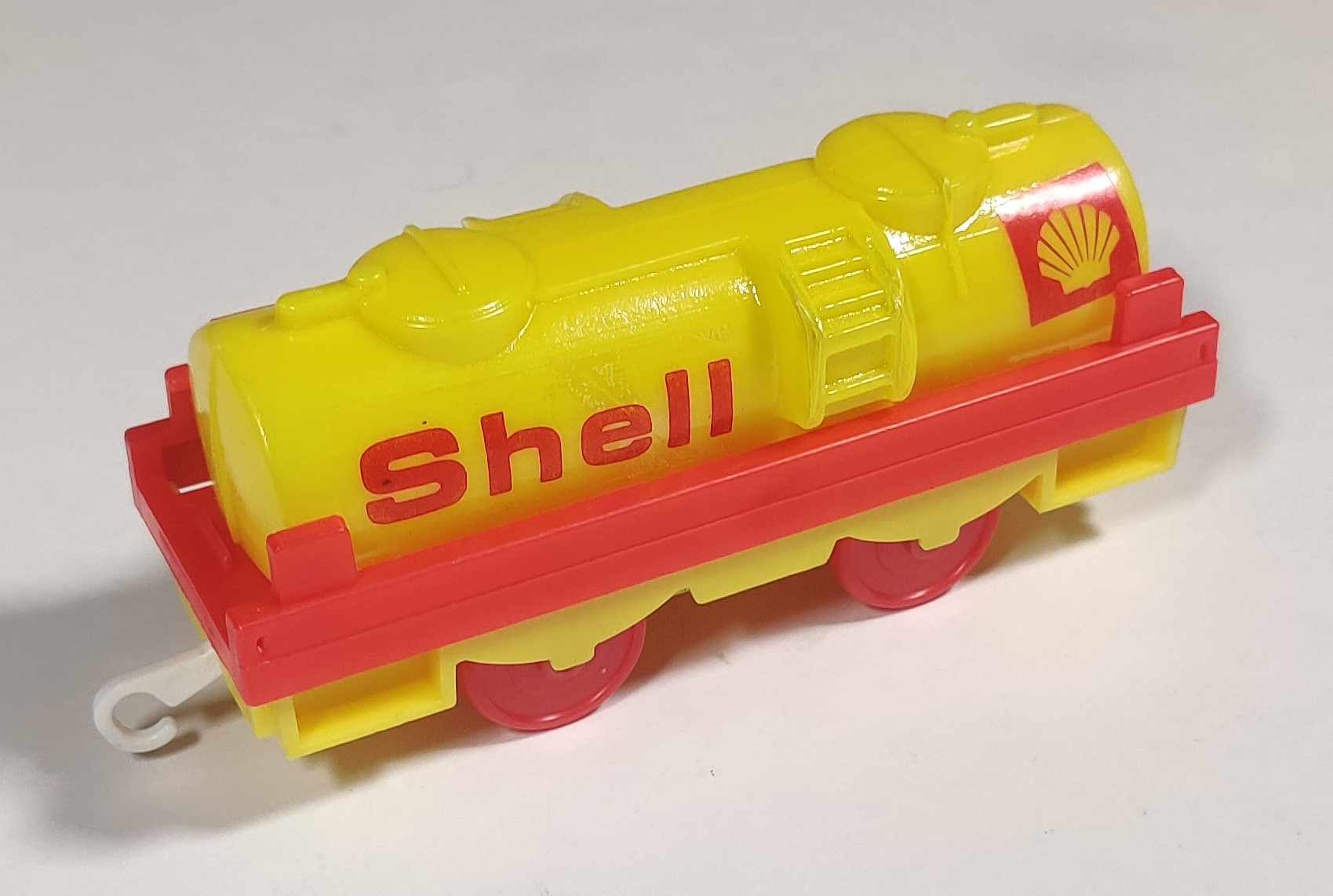
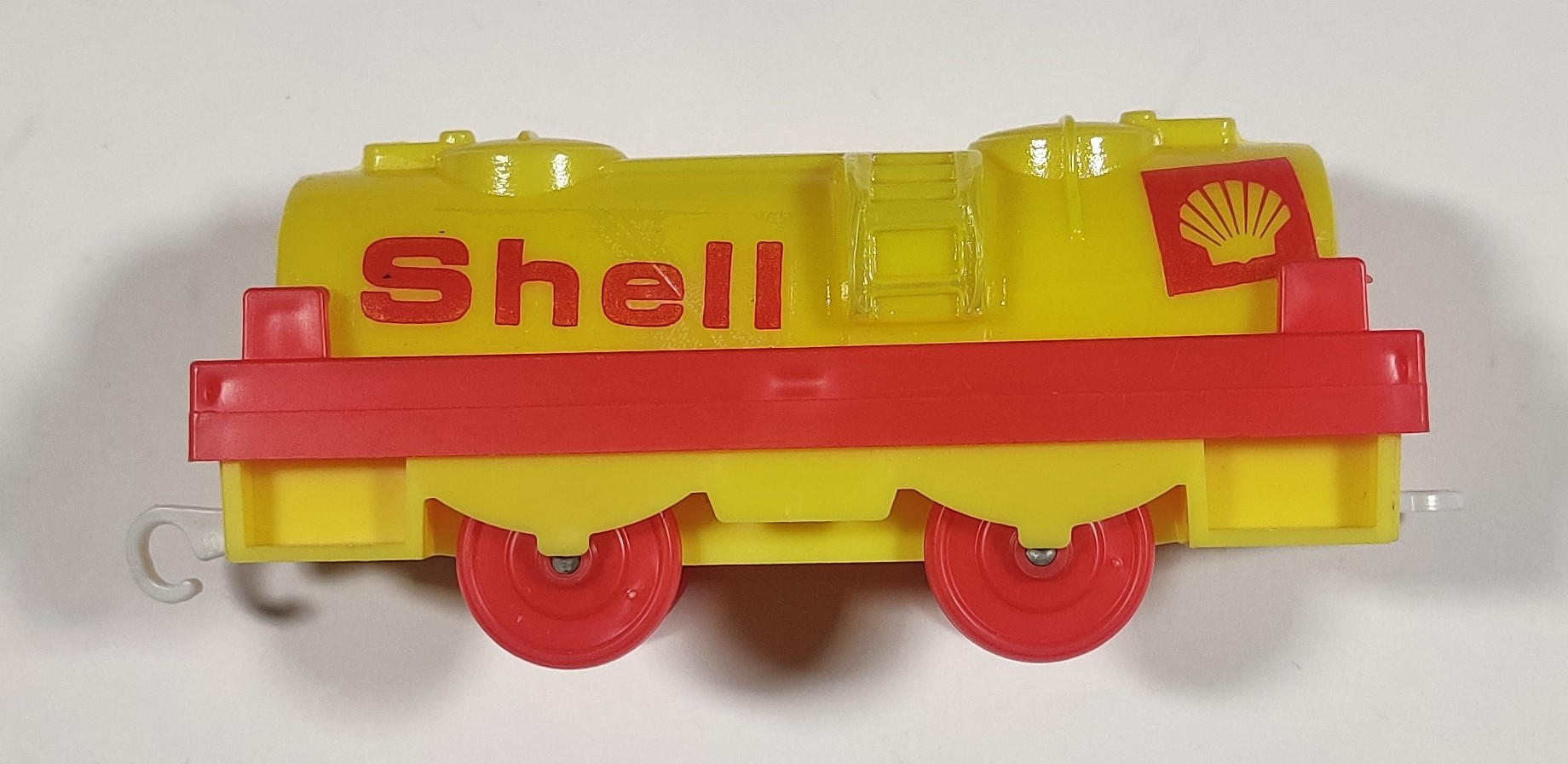
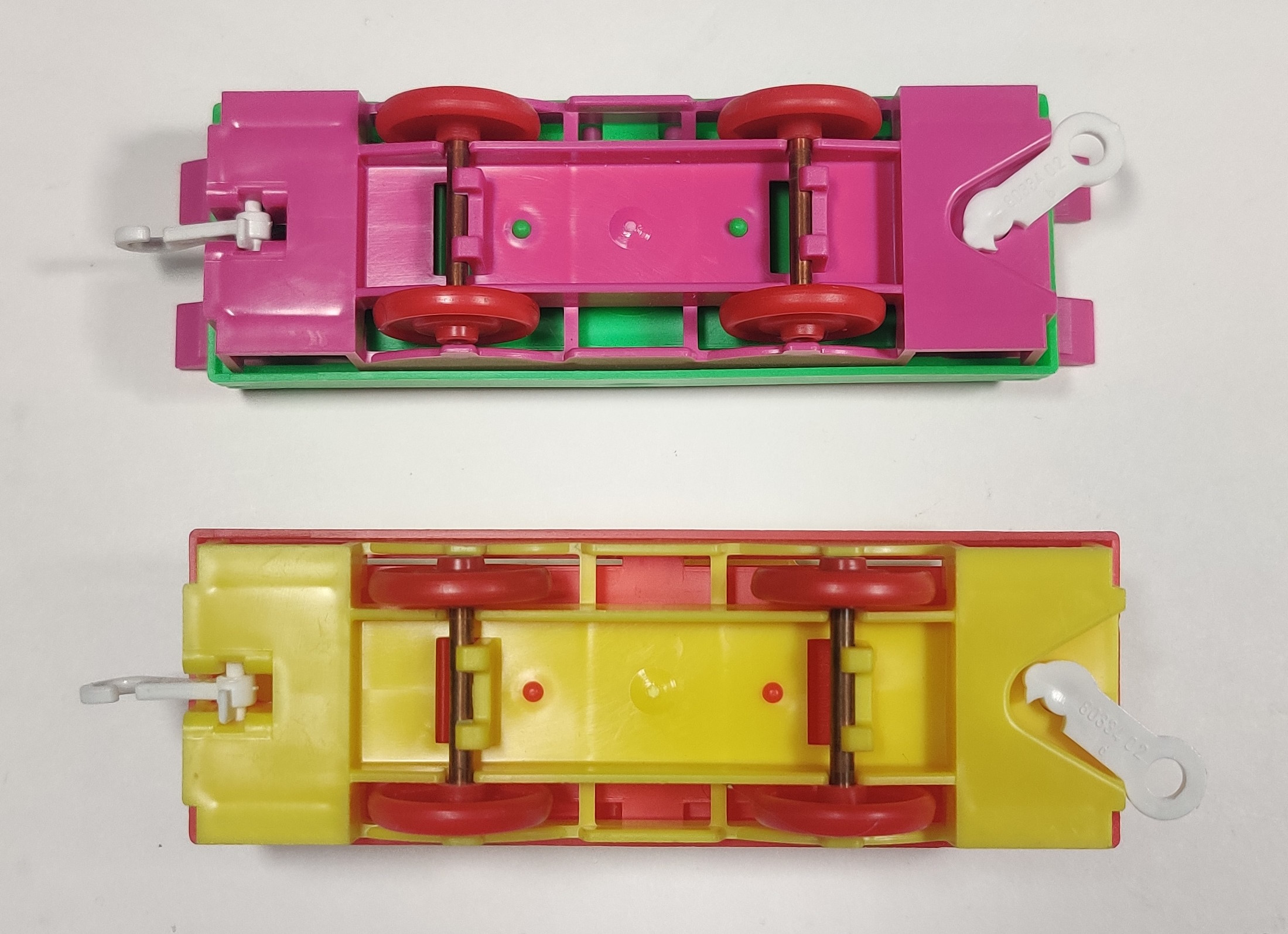
Using the same chassis tooling as the auto carrier is this tanker car. Stelco may have had an agreement with Shell to use their name and logo as it also appears on some of their parking garages and other transportation toys (some of which were also manufactured by Tomy).
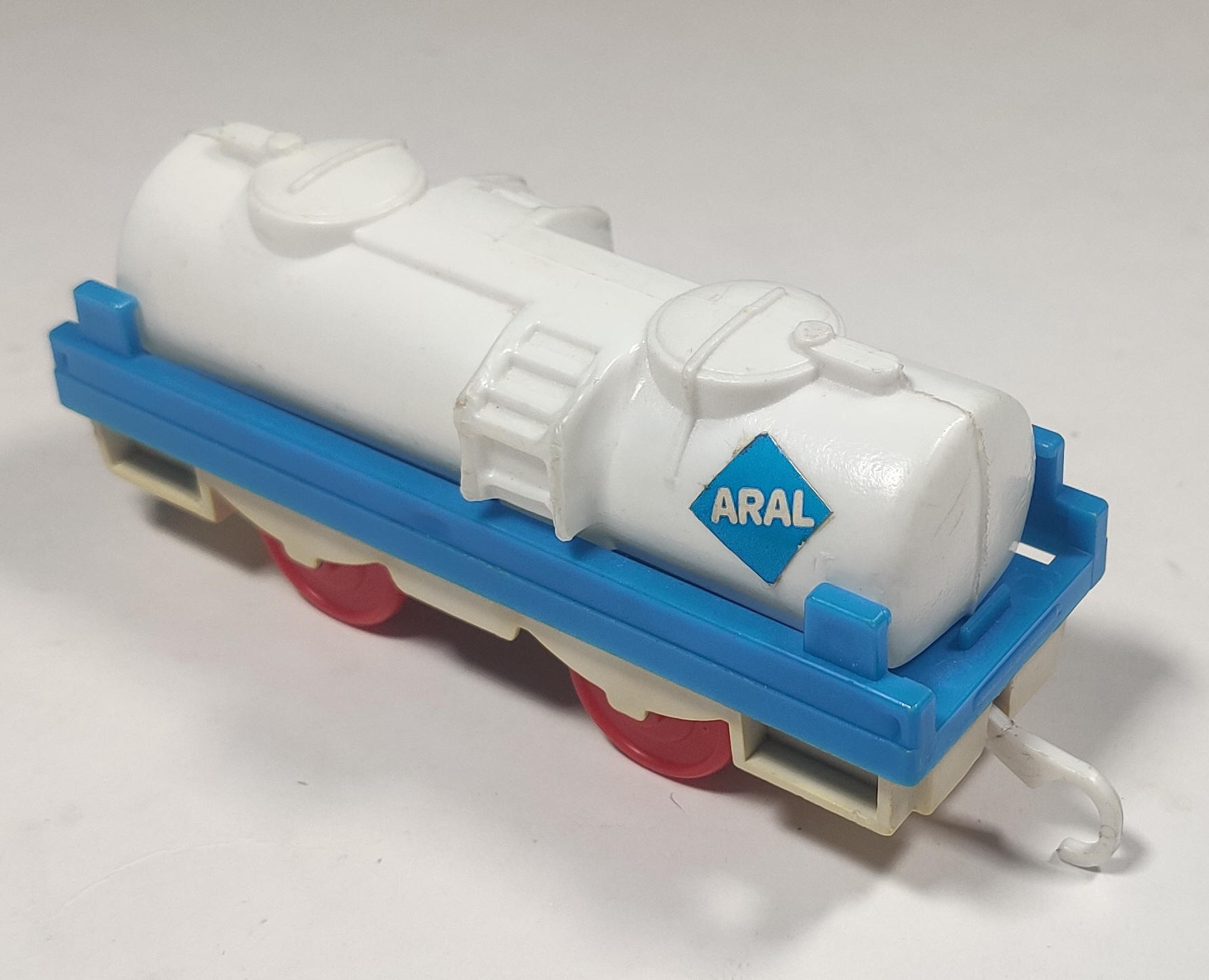
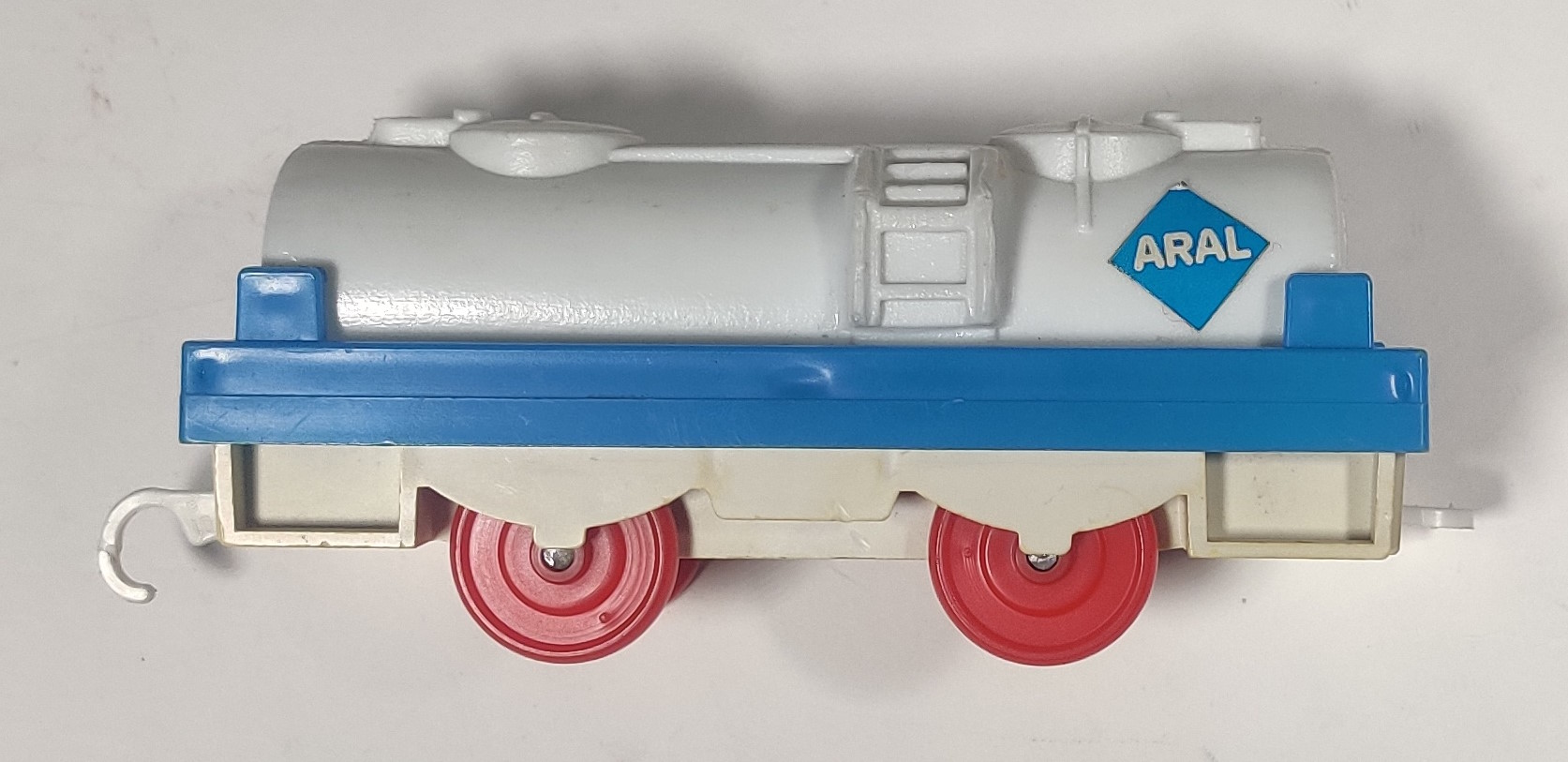
There is also an Aral tanker, a German oil company. It is nice that these tankers follow the color schemes of the companies they represent. I have seen a (later?) variant of this tanker with a larger rectangular ARAL sticker on the bigger open portion of the tanker side to the left of the molded ladders.
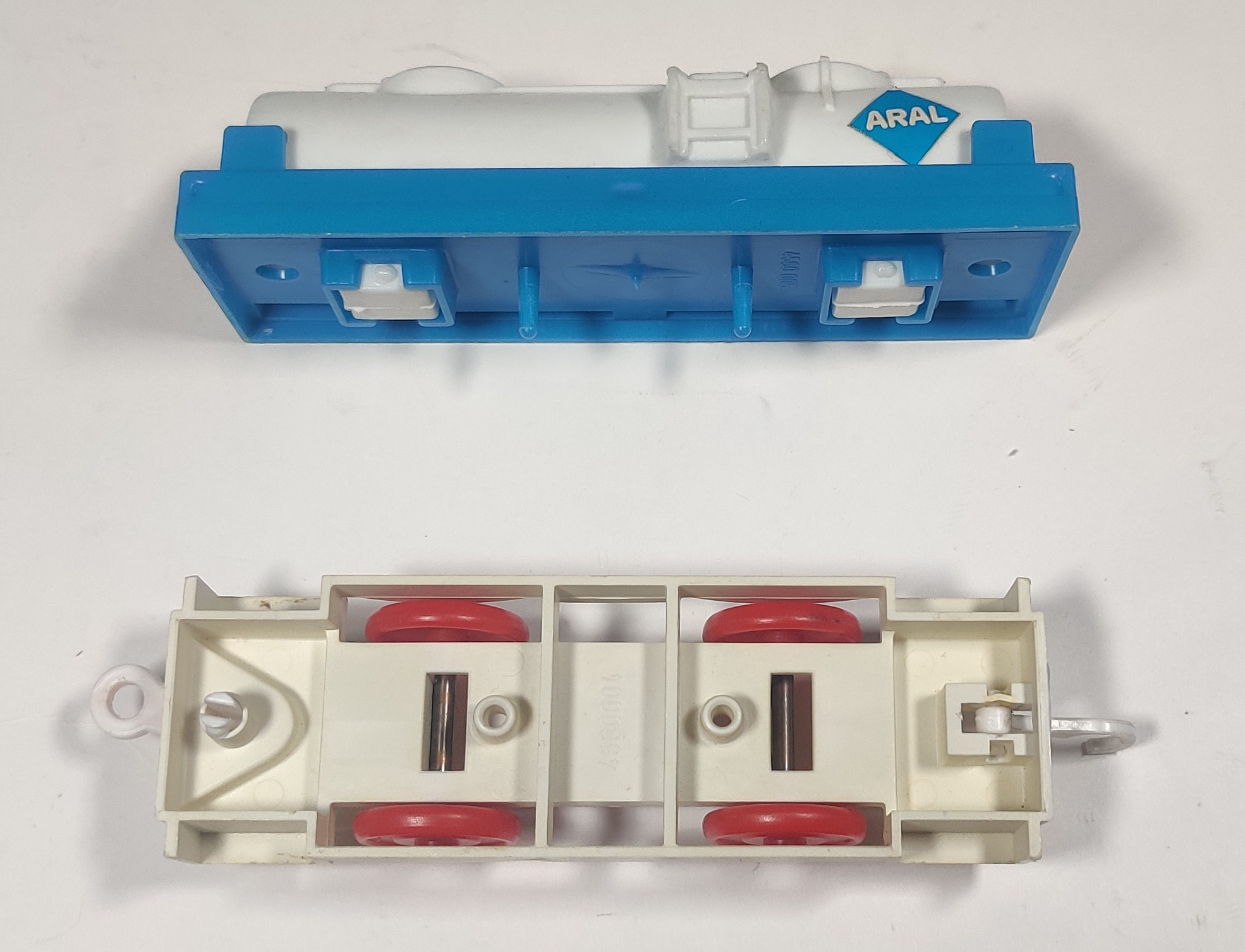
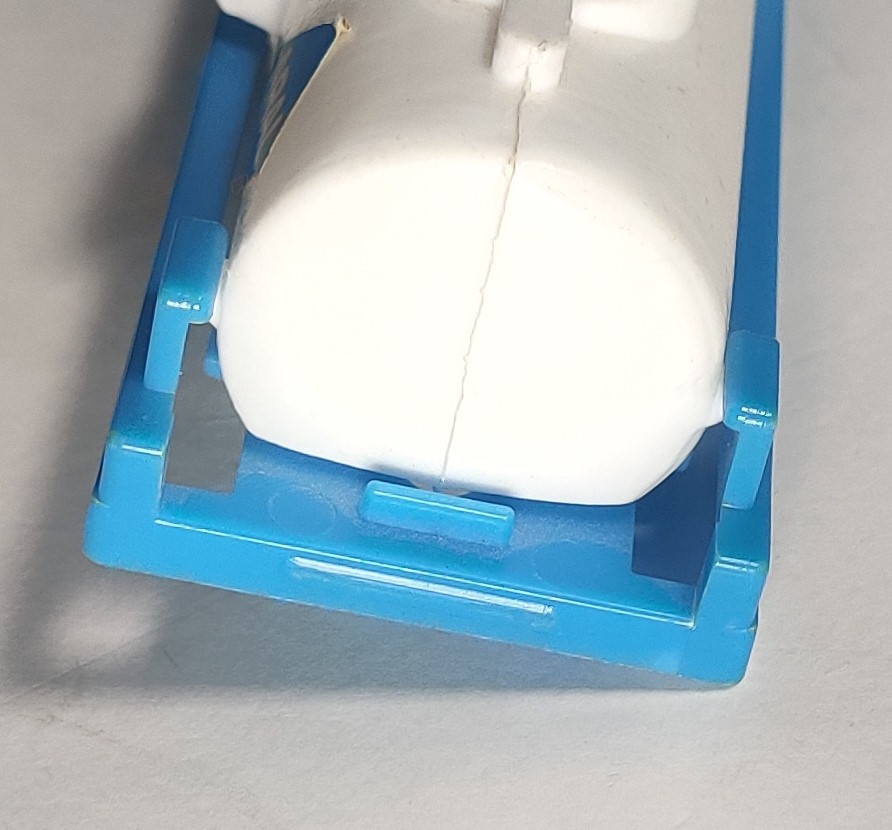
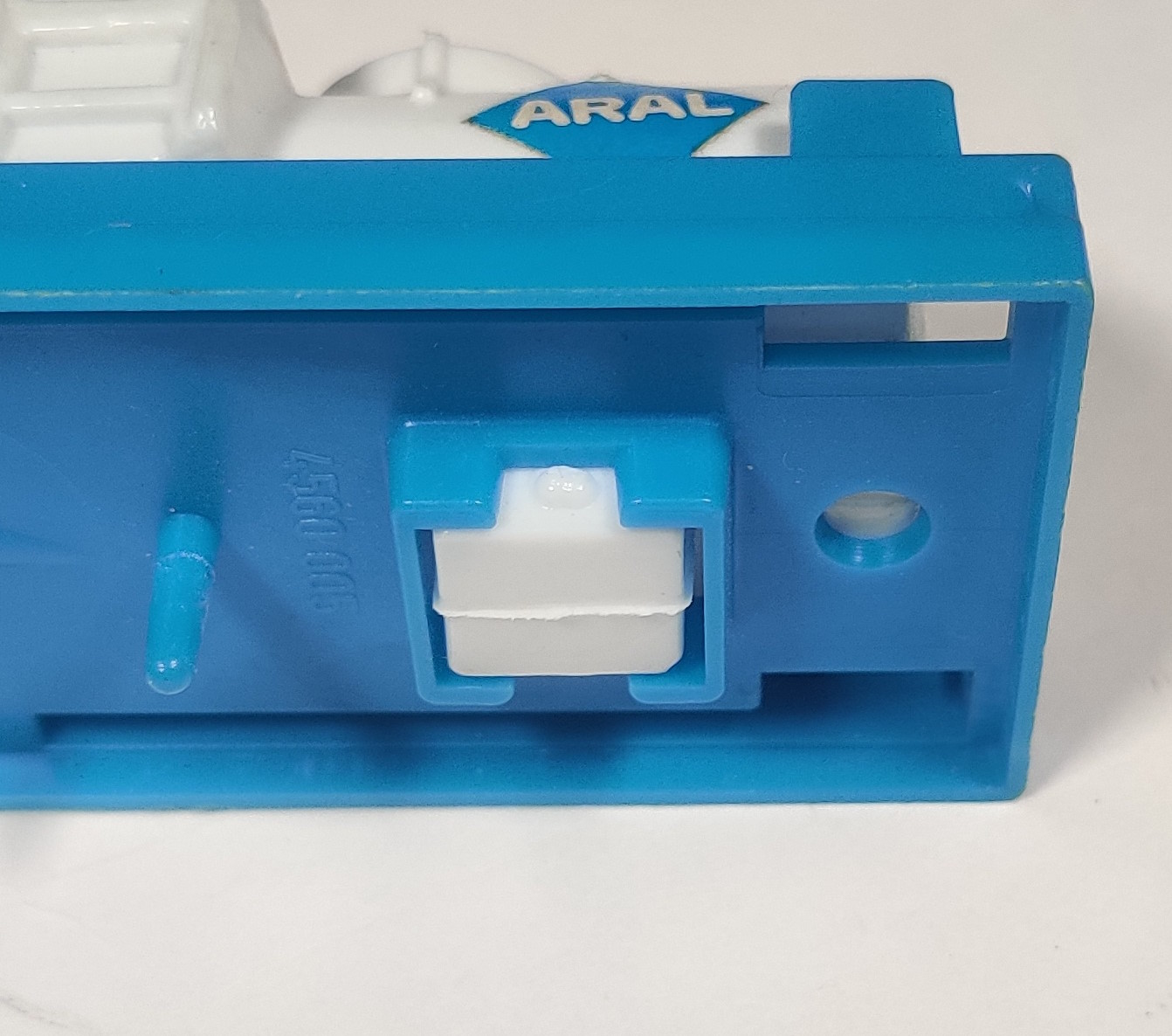
The tank component is clipped into the separately-molded "rim" at both ends as well as below the deck. The chassis friction-fits over the molding of the chassis.
There is also an open wagon which uses the same chassis as the tanker and auto carrier, but I do not currently own one. An example of the open wagon can be seen in the blog post referenced above.
Stelco track
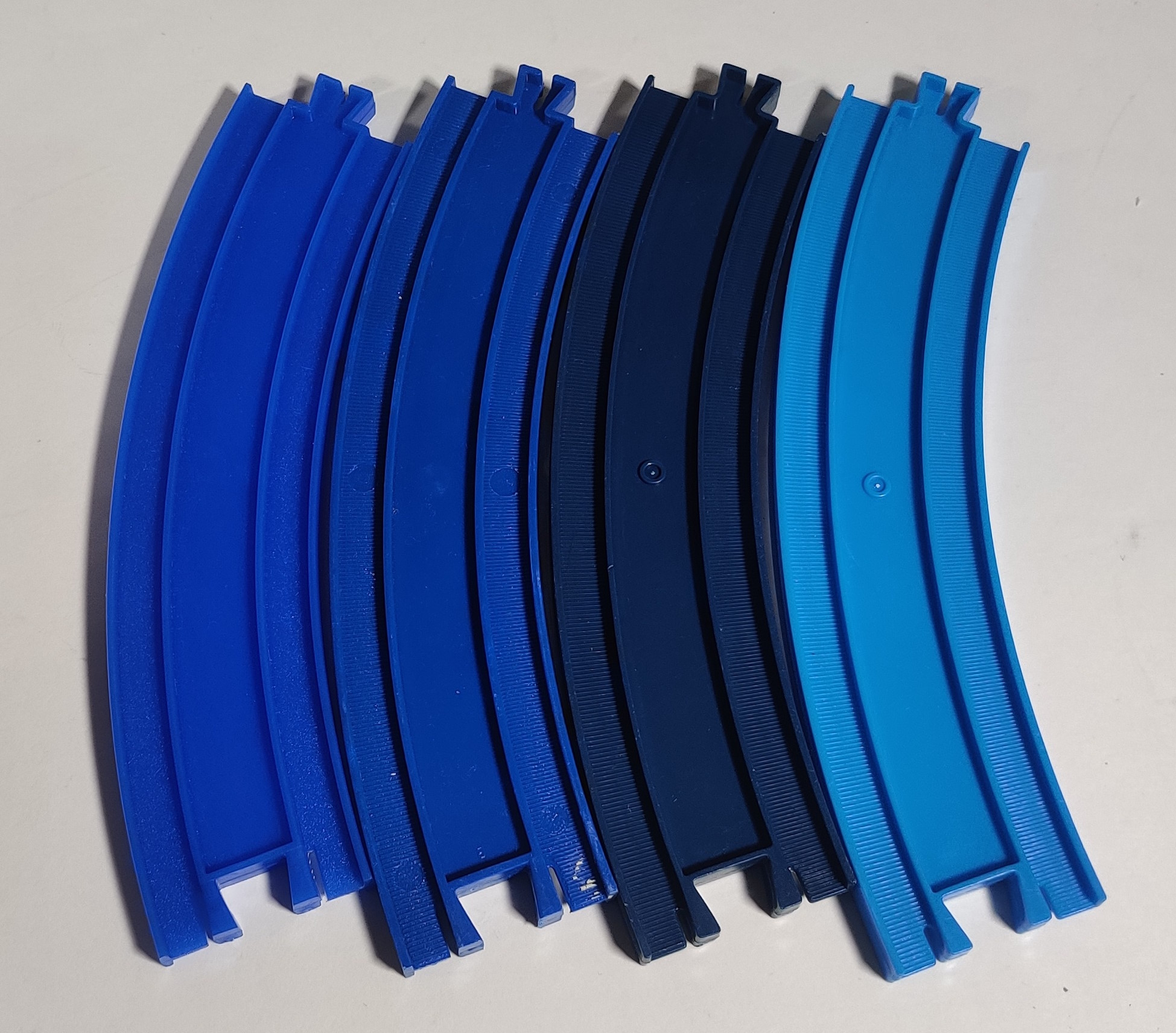
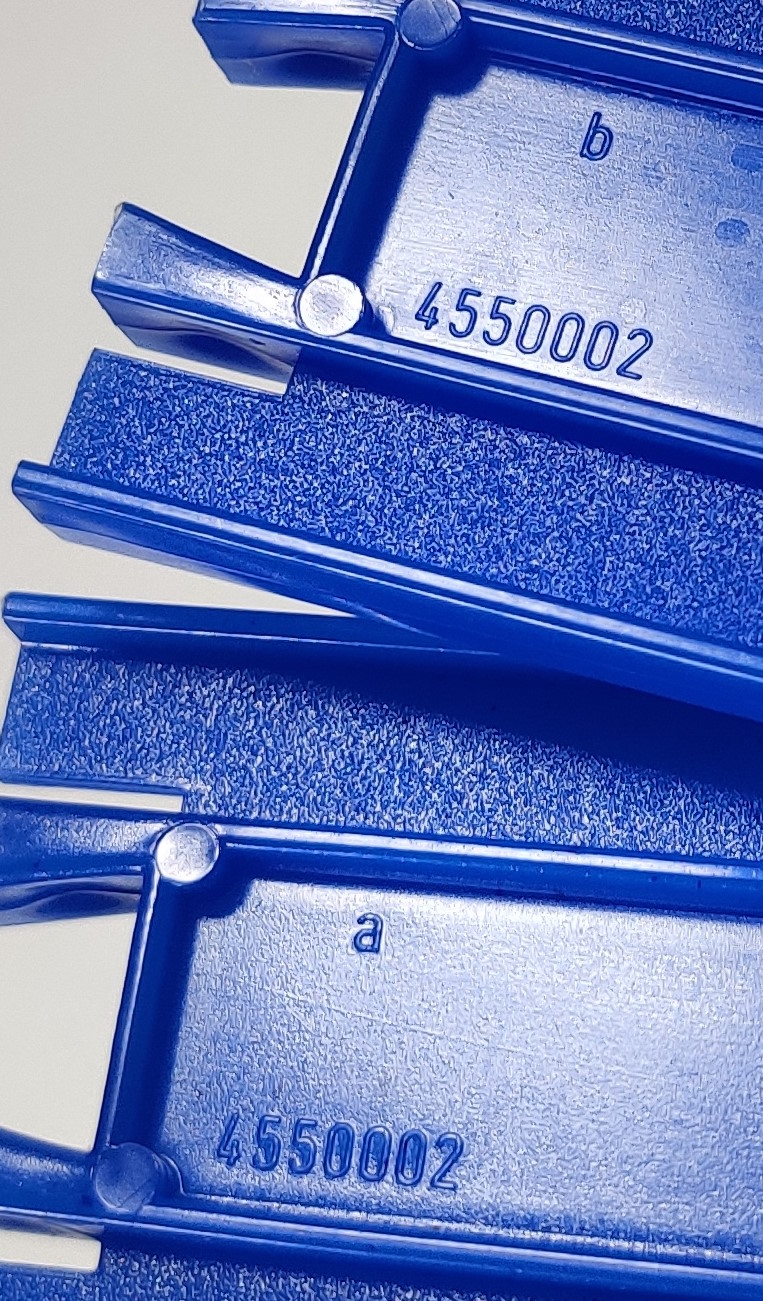
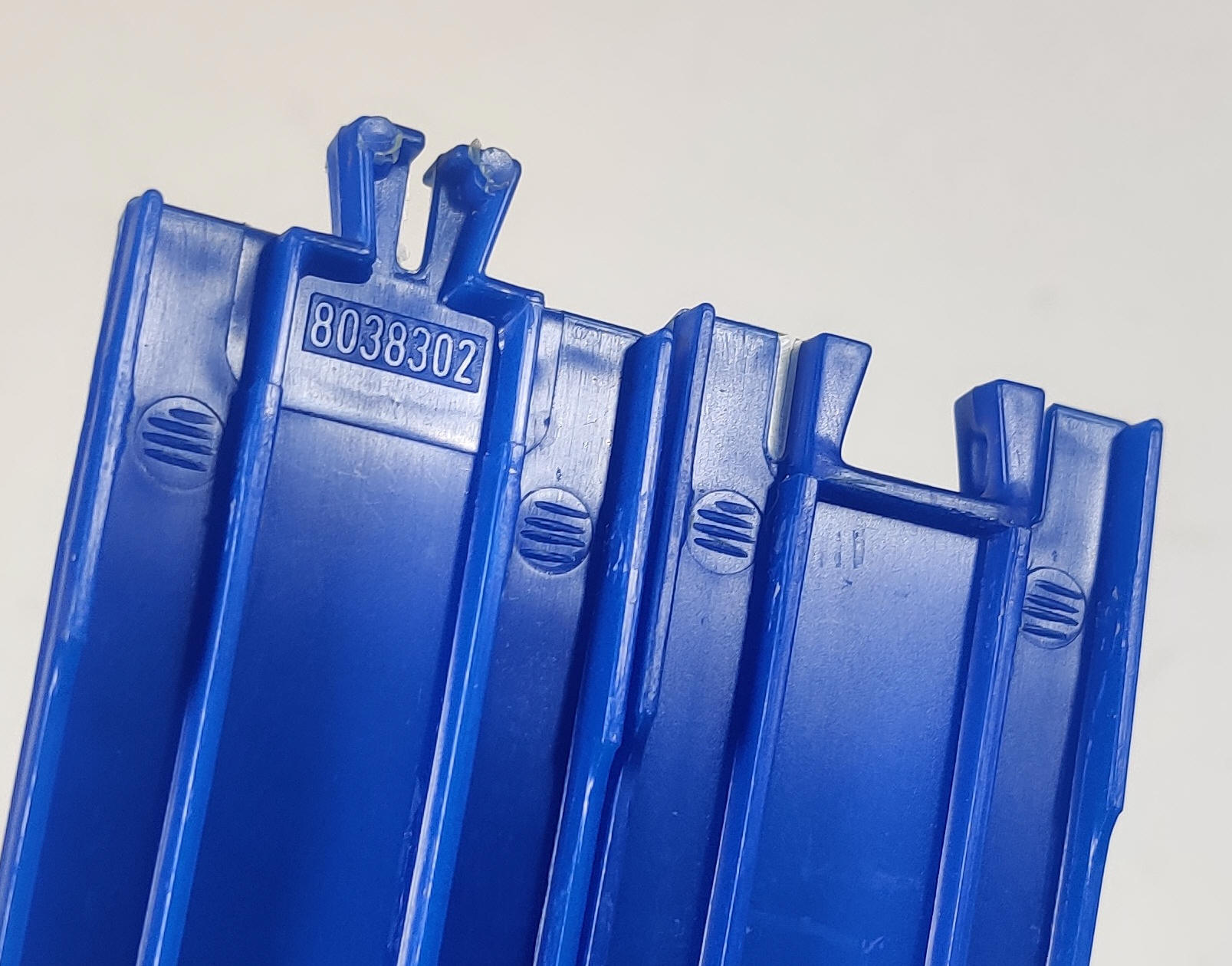
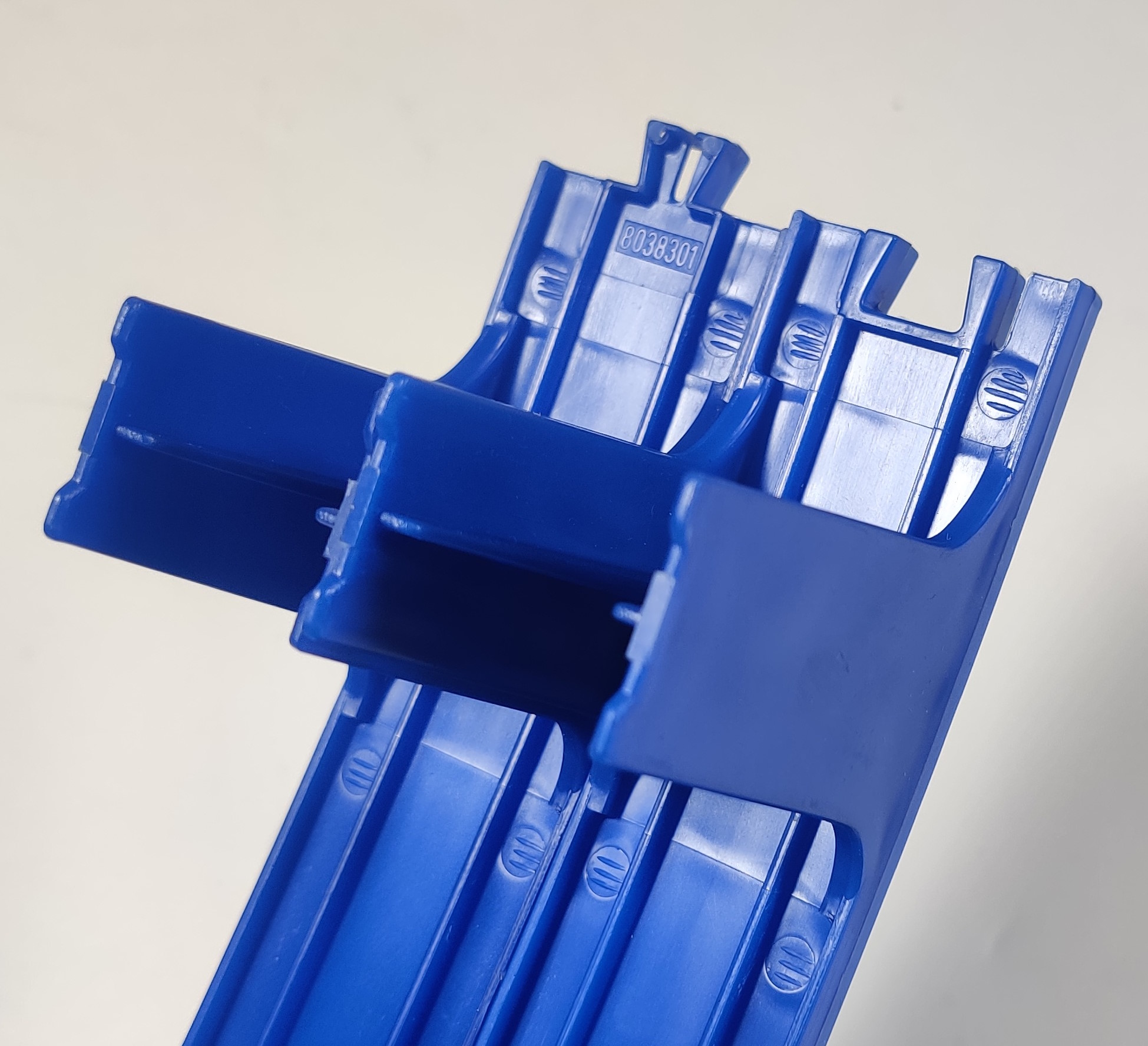
All Junior Express track was produced by Stelco in West Germany based on the Plarail standard. The rails are marked with molding slot letters as well as seemingly a product code. Rails are roughtop as Plarail would have been at the time and are a lighter blue than the Mickey Mouse Plarail or Tomy Express/Tomy Train dark blue rails but are darker than normal Plarail rails.
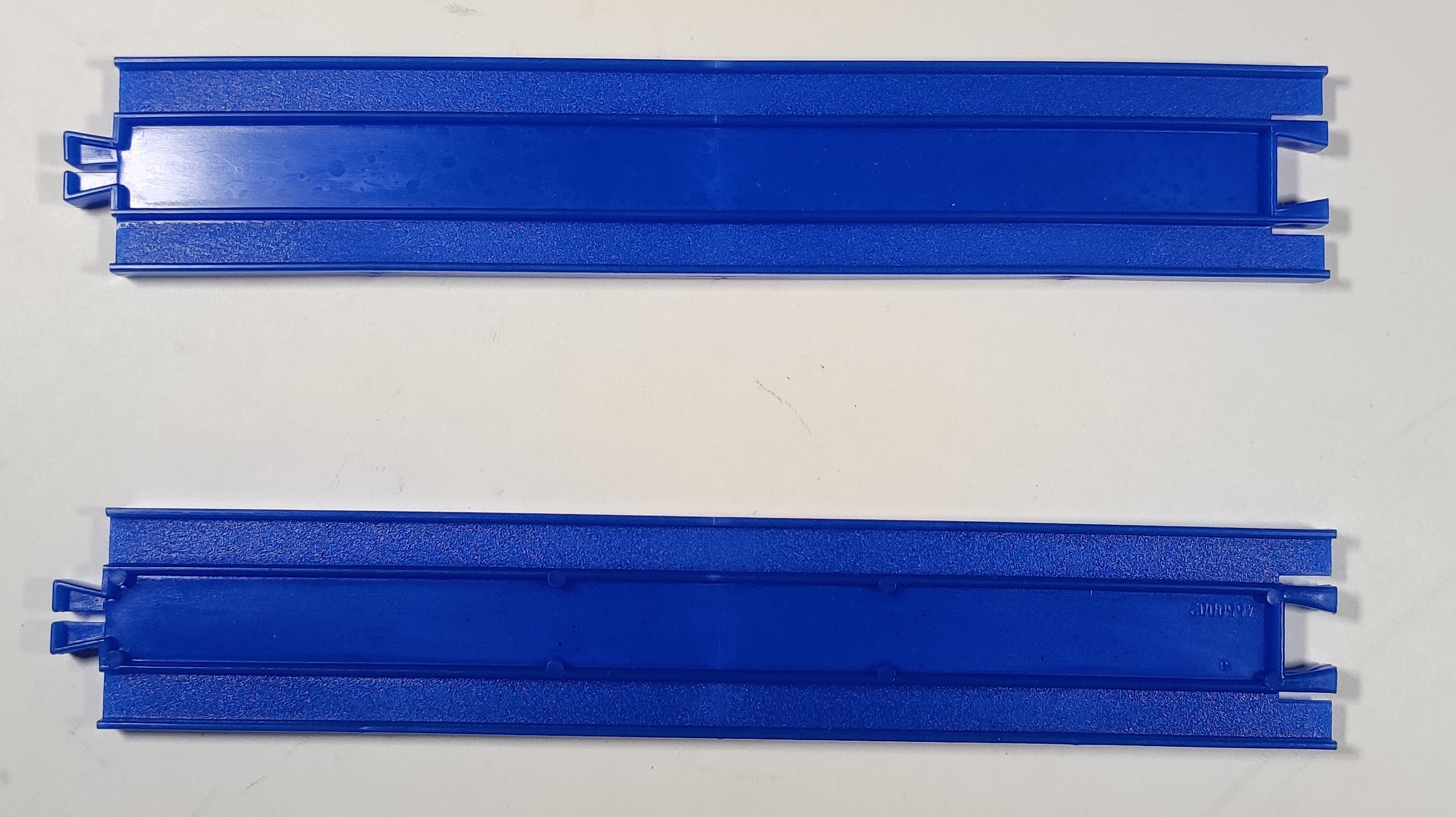
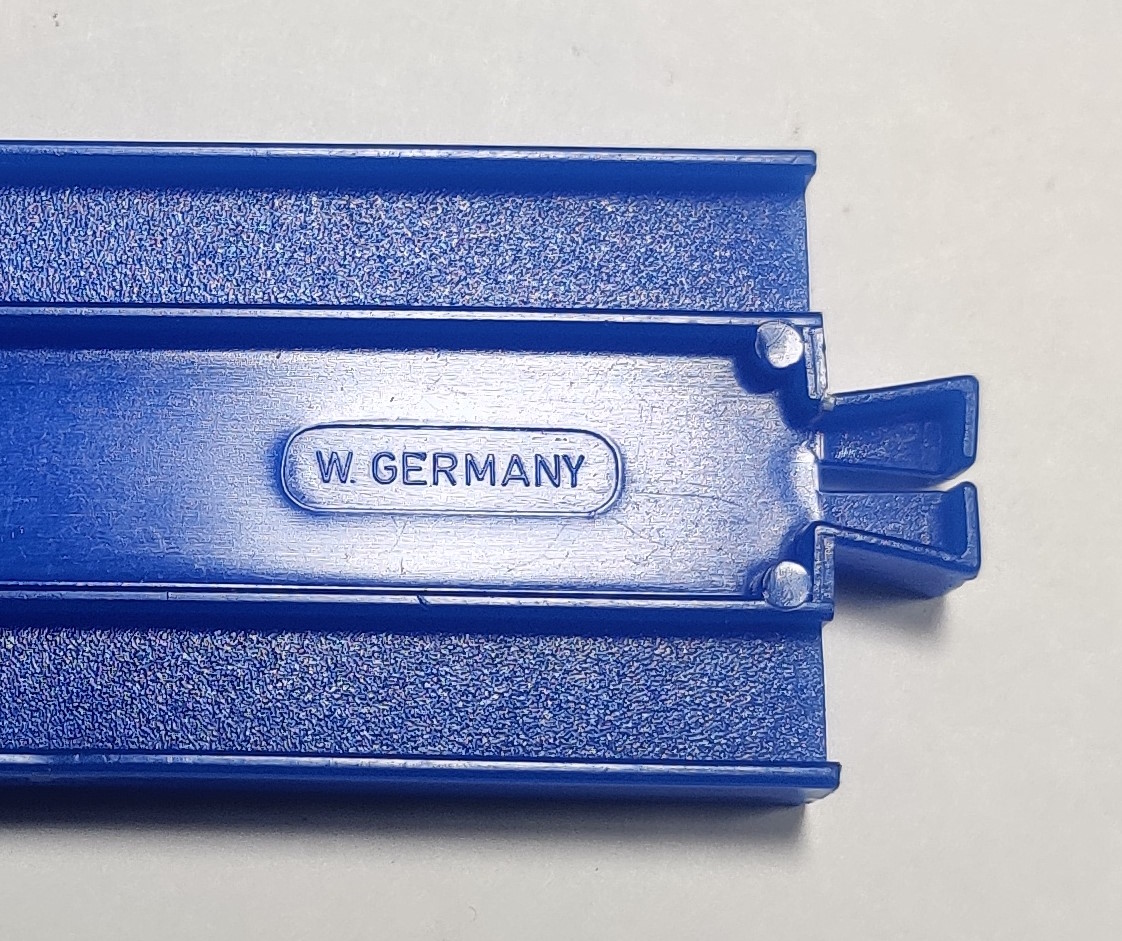
Some later straight rails seem to be the only track marked with the country of manufacture. It does not appear that the half straight rail was ever adapted for Stelco.
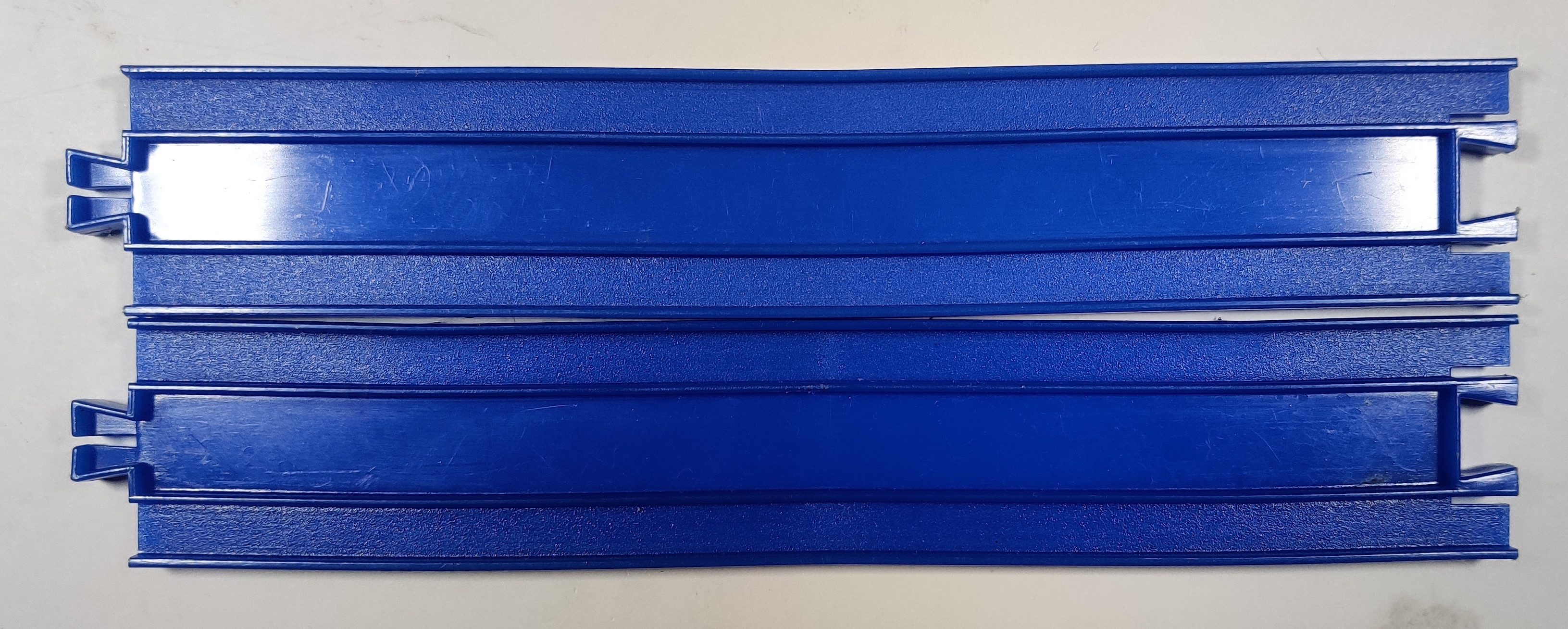
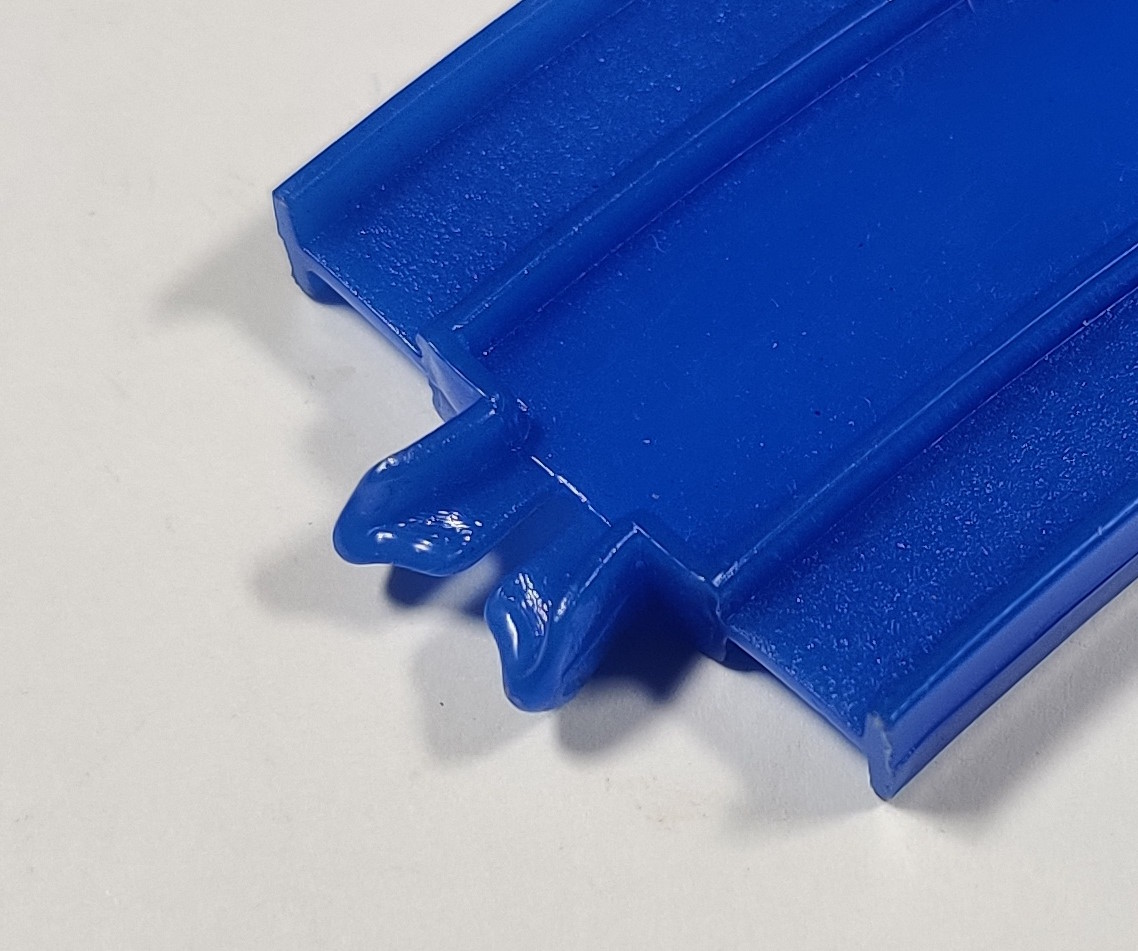
The soft plastic used on these rails does seem to shrink or expand with time, but this is also the case with original Plarail and other older plastic track. It could also be the case that the process Stelco used to make these tracks was always slightly more lax than Tomy's, as I have found some Stelco track and accessories which do not seem to have been molded quite correctly.
Track was primarily sold in sets and track packs that came with the parts secured to a cardboard backing. The 1979-1980 catalogue lists, and some boxes corroborate, these track and accessory packs:
4810 Switch Pack

The 4810 Switch Pack (Weichenpackung) contained two straight rails, two curve rails, one of each style of point rail, and one of each type of joint rail.
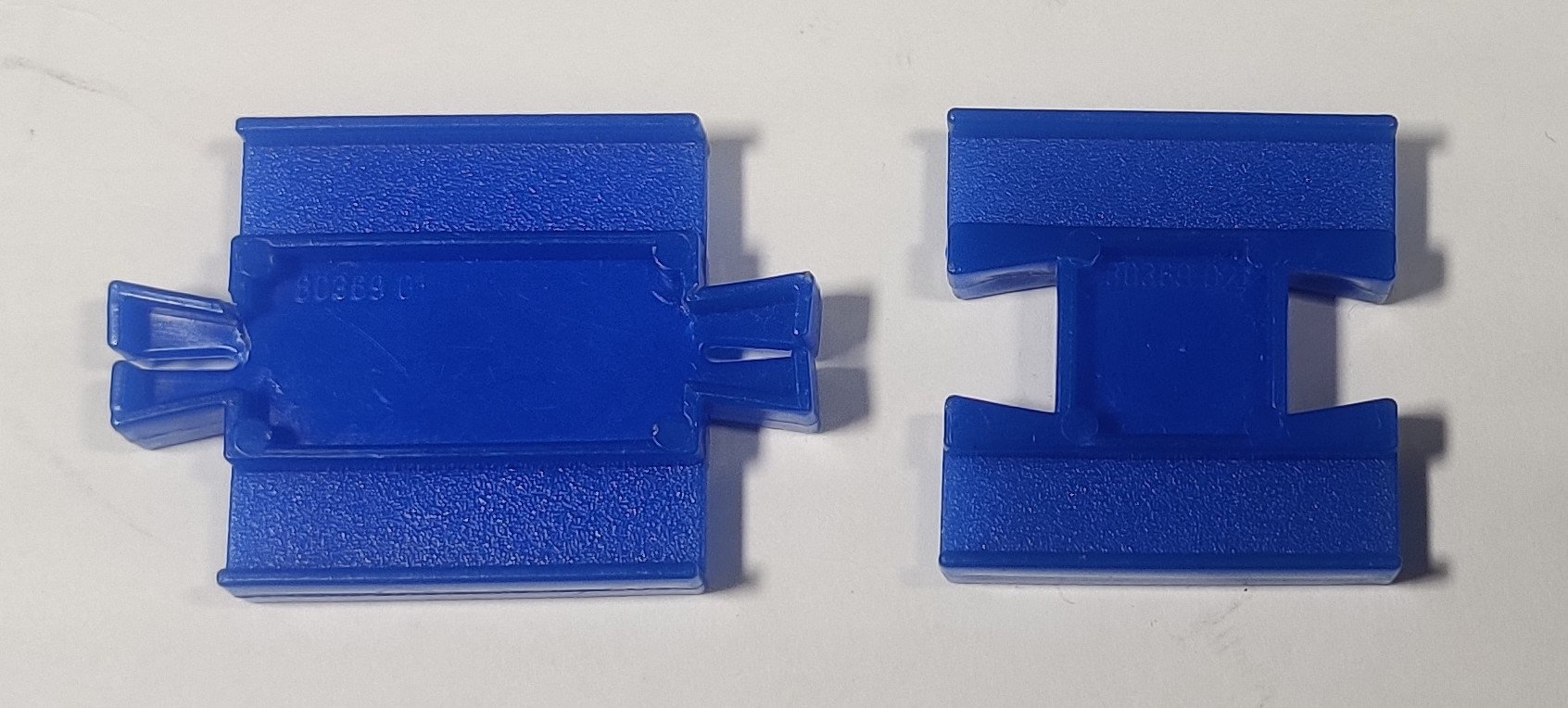
Joint rails were seemingly only included in the two switch track packs, and not in any sets.
4812 Barrier Pack
The 4812 Barrier Pack (Schrankenpackung) includes one of the Junior Express railroad crossings as well as three straight rails.
4814 Bridge Pack
The 4814 Bridge Pack (Bruckenpackung) includes everything you need to add an elevated portion to an existing set including a pair of ascending tracks, two straight rails, and six bridge girders.
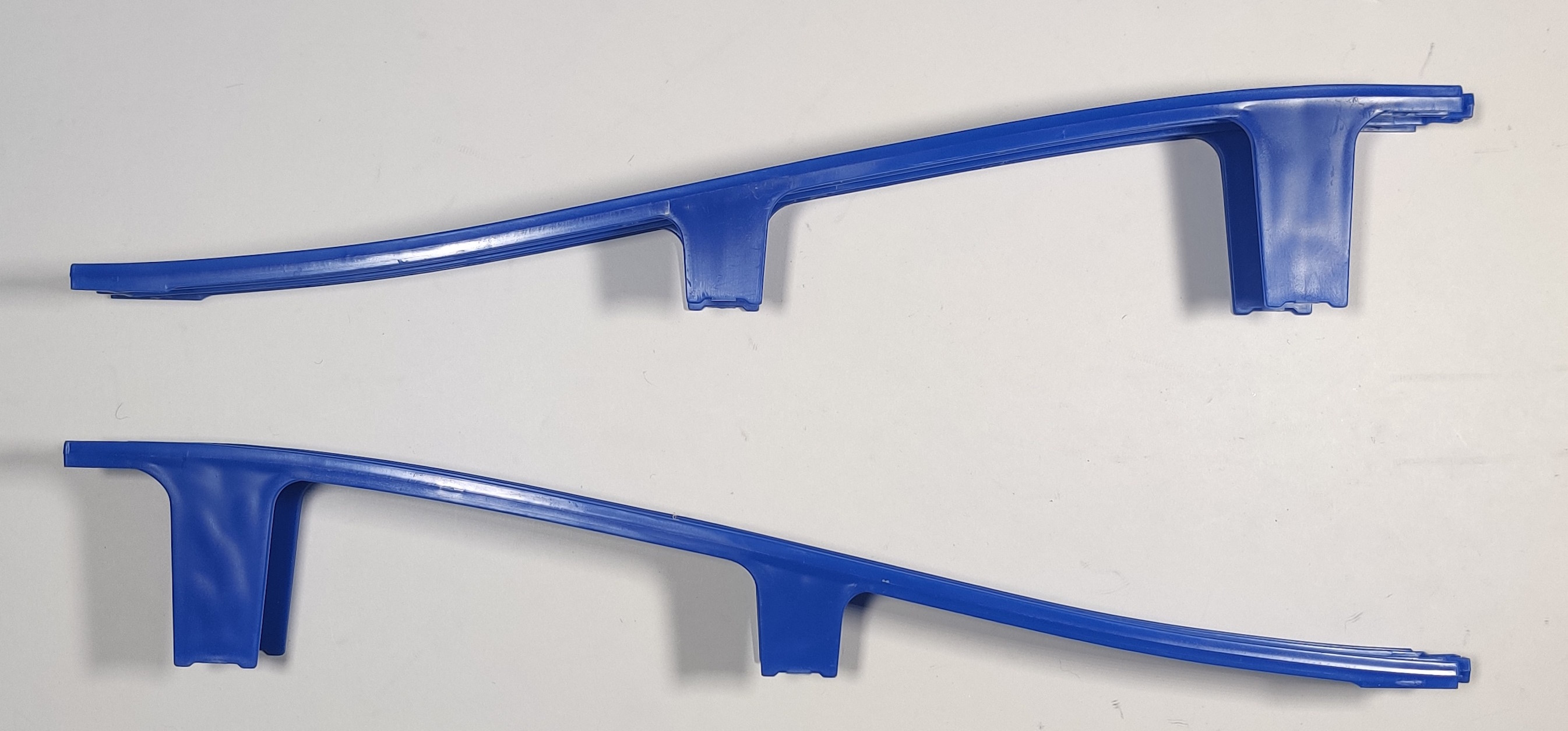
Stelco ascending tracks are based on the Plarail Bridge Rail and have integrated supports and thus a designated "up" and "down" due to the handedness of the rail joints.
4820 Switch Double Pack
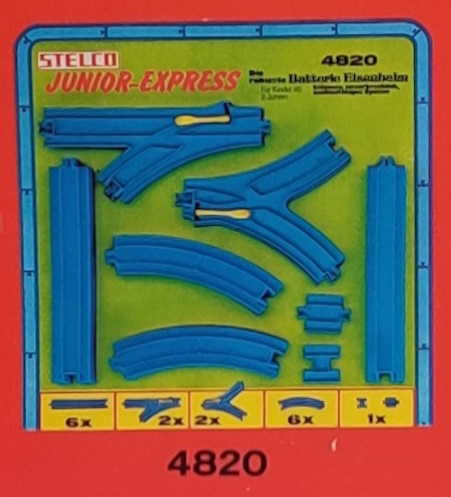
The Switch Double Pack (Weichendoppelpackung) is the largest Junior Express track pack, containing six straight rails, six curved rails, two turnouts, two figure-eight point rails, and one of each joint rail.
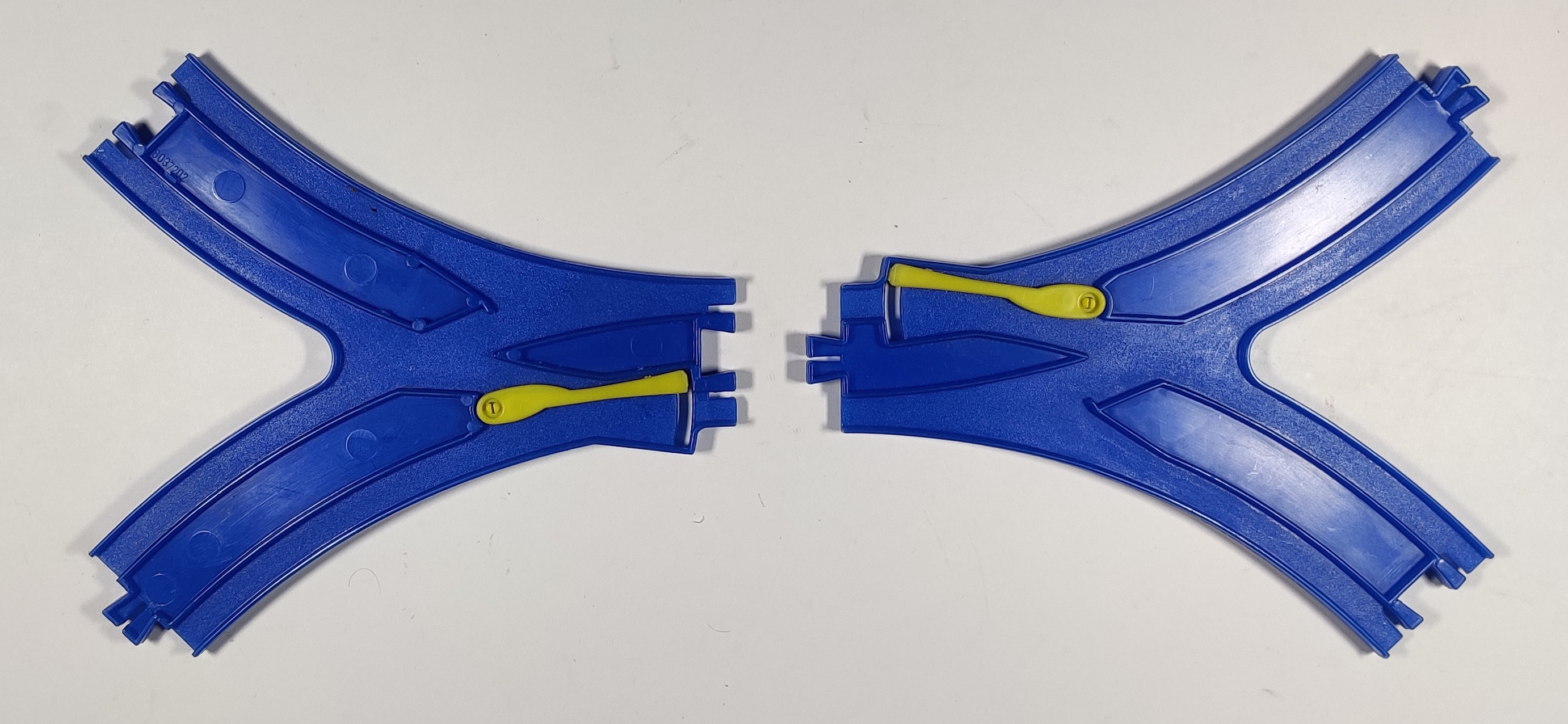
The Stelco version of the figure eight point rail was seemingly only available in this track pack.
Stelco track was also used in some of their own vinyl toys, in particular at least 1726 Vinyl Train and 1740 Vinyl Railway Layout which both included a circle of track, a three-piece vinyl train, and an array of accessories (the 1740 set has some animals, a fence, trees and even two small buildings while the smaller set only has trees and a signal).
Stelco accessories
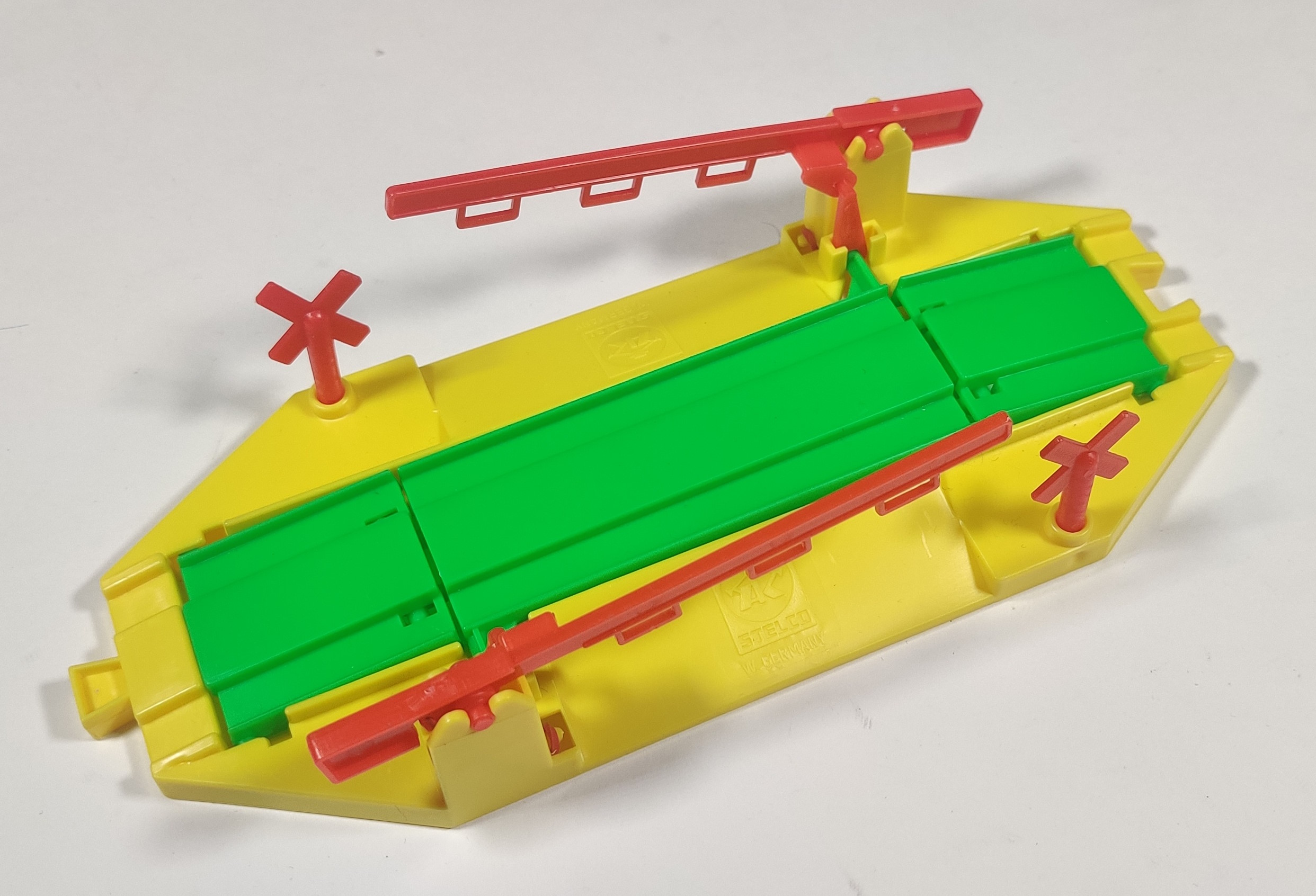
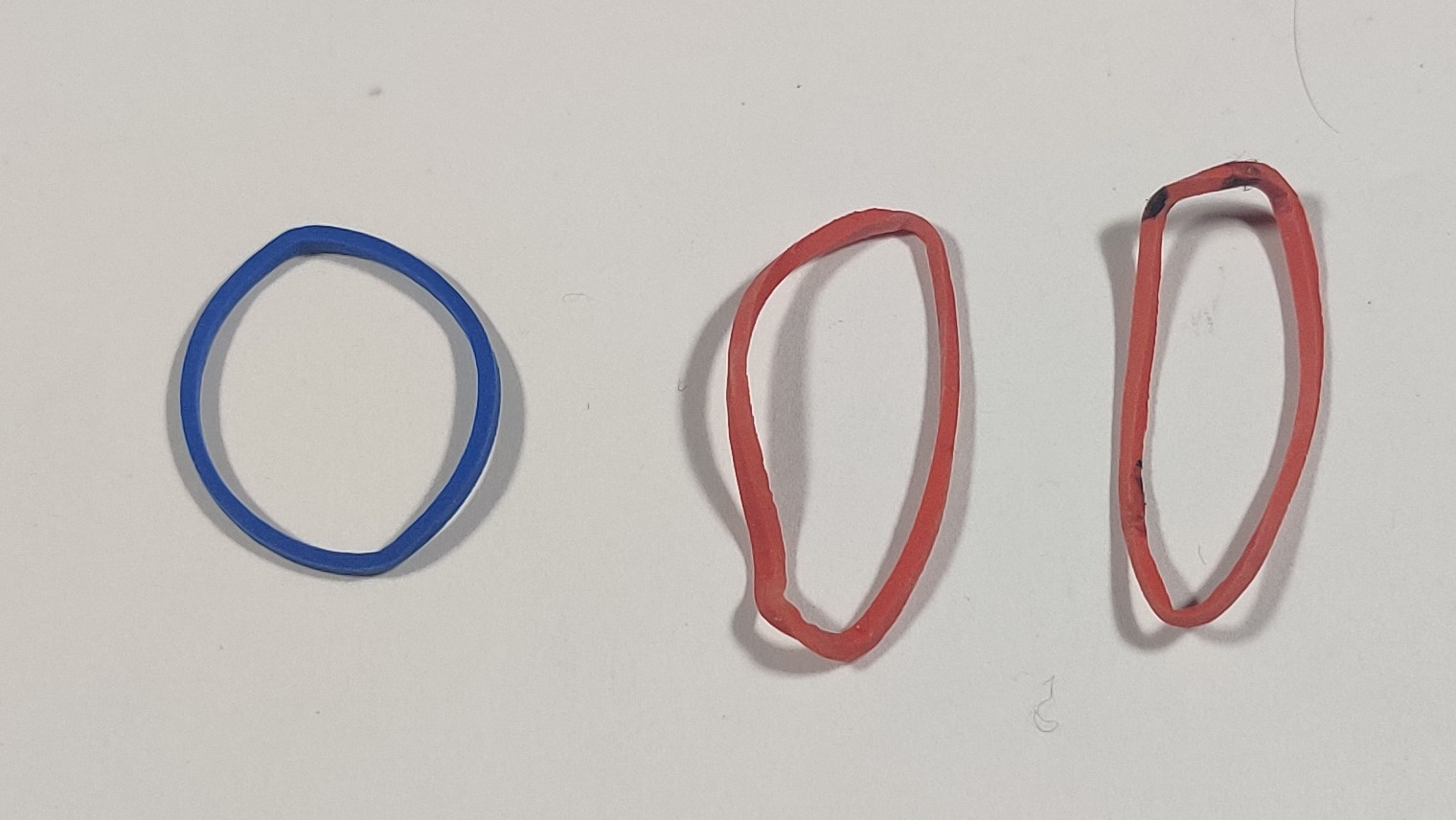
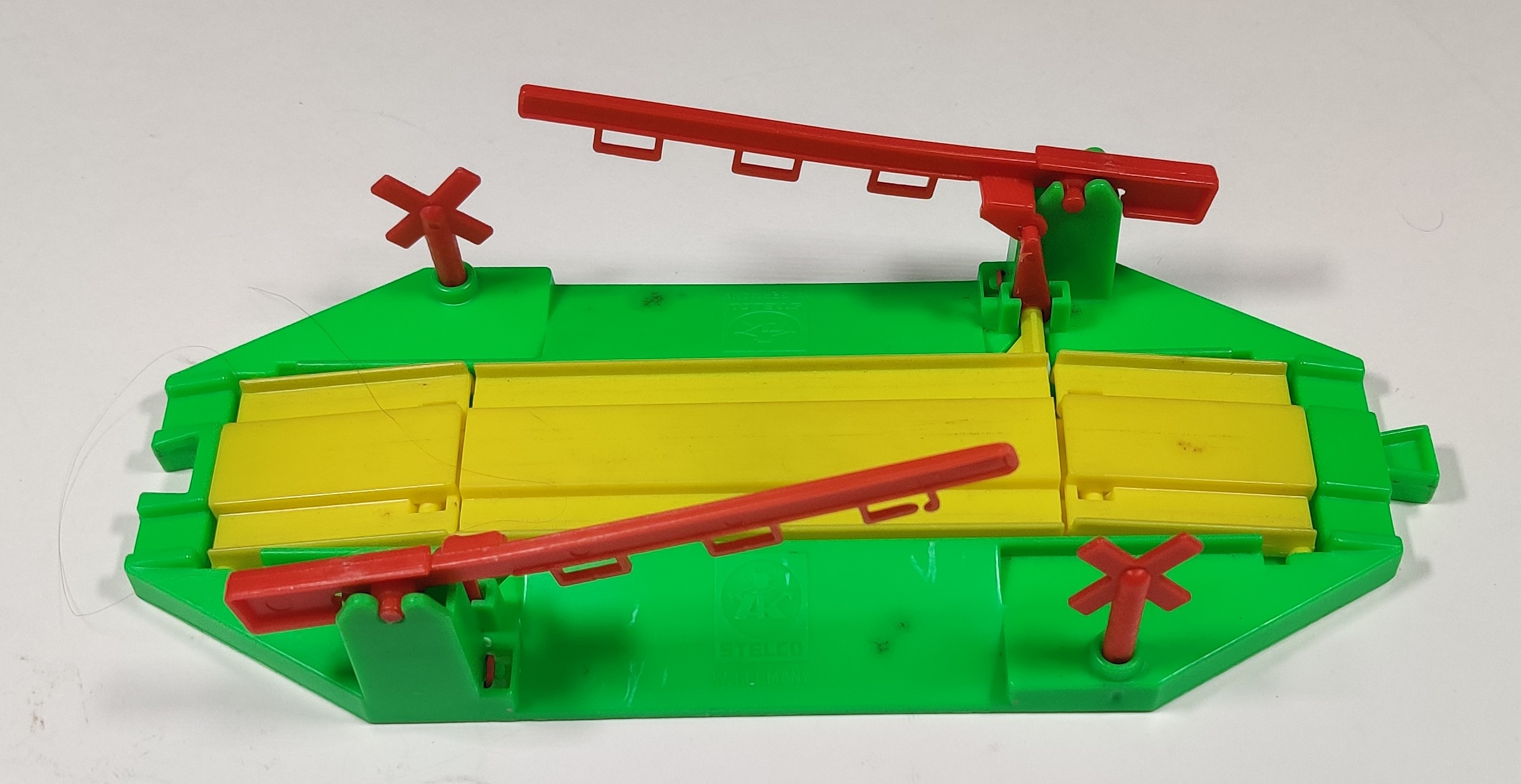
The railroad crossing is similar in design to the 1970s Plarail railroad crossing but is produced by Stelco and uses a rubber band system to return the boom arms to the upward position. The rubber bands are stretching out with time but are easy enough to replace. The railroad crossing signs are separately fitted. The "reverse" color of the crossing with green base and yellow track which is somewhat closer to the original Plarail version was also produced.
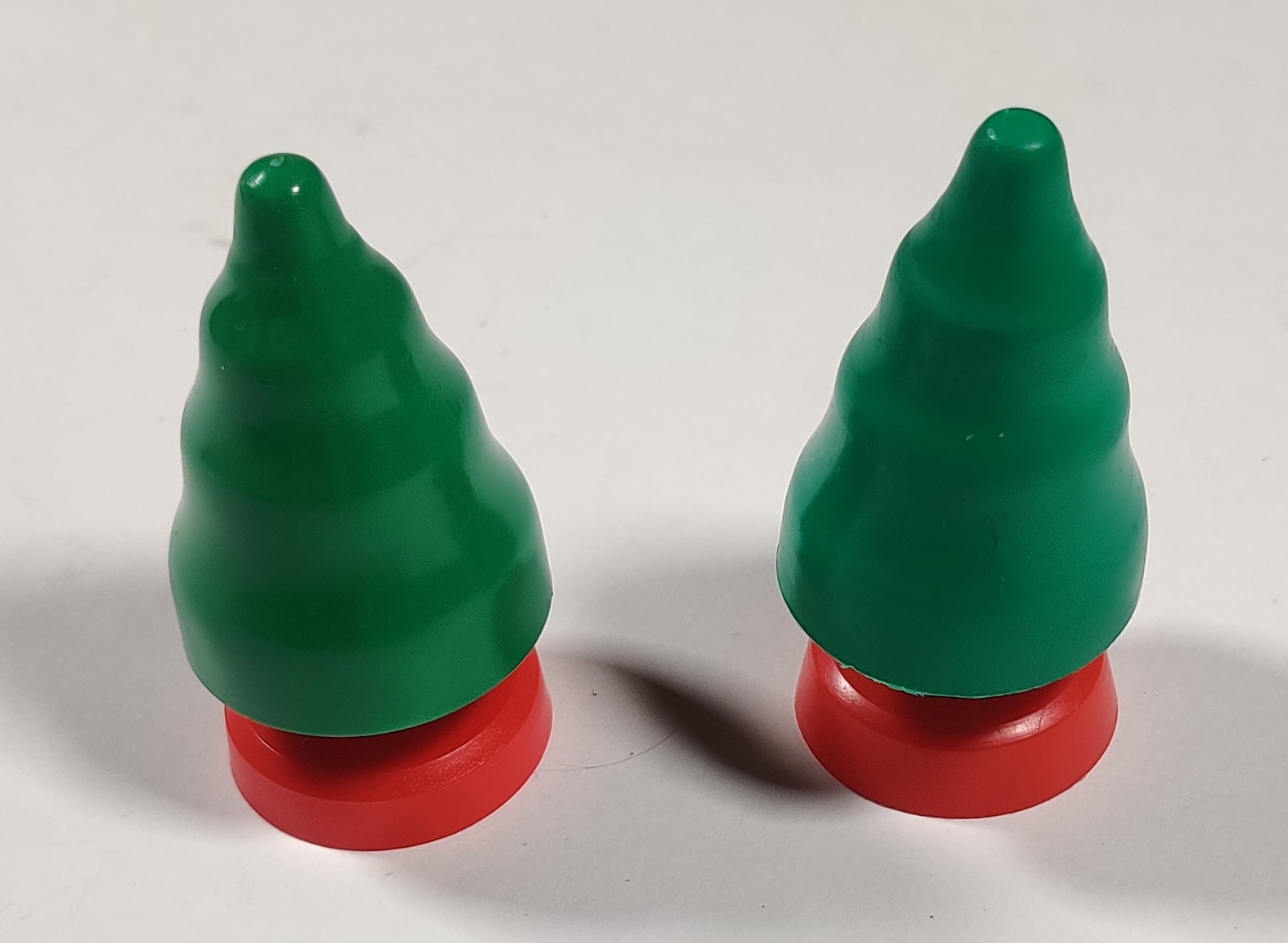
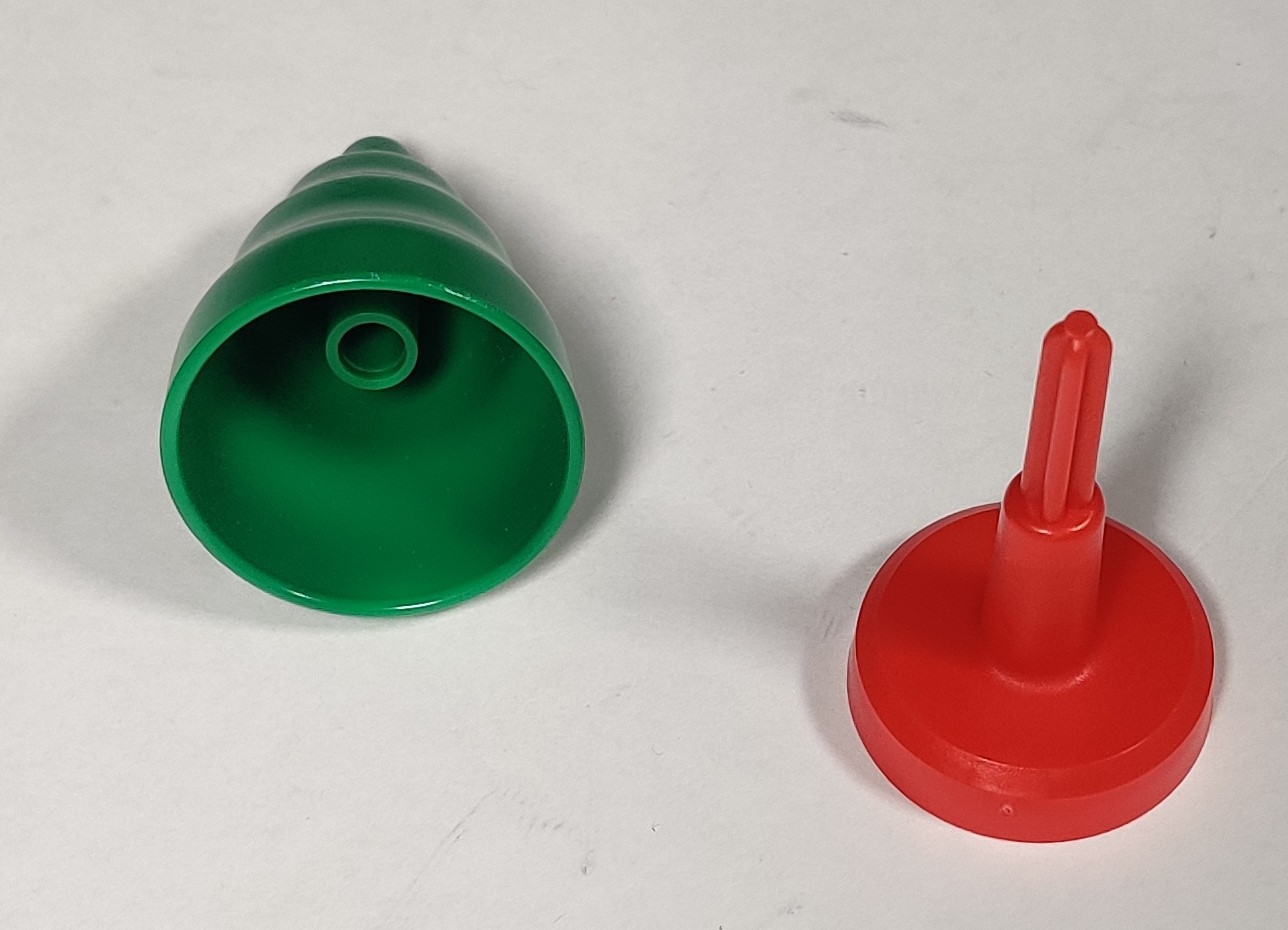
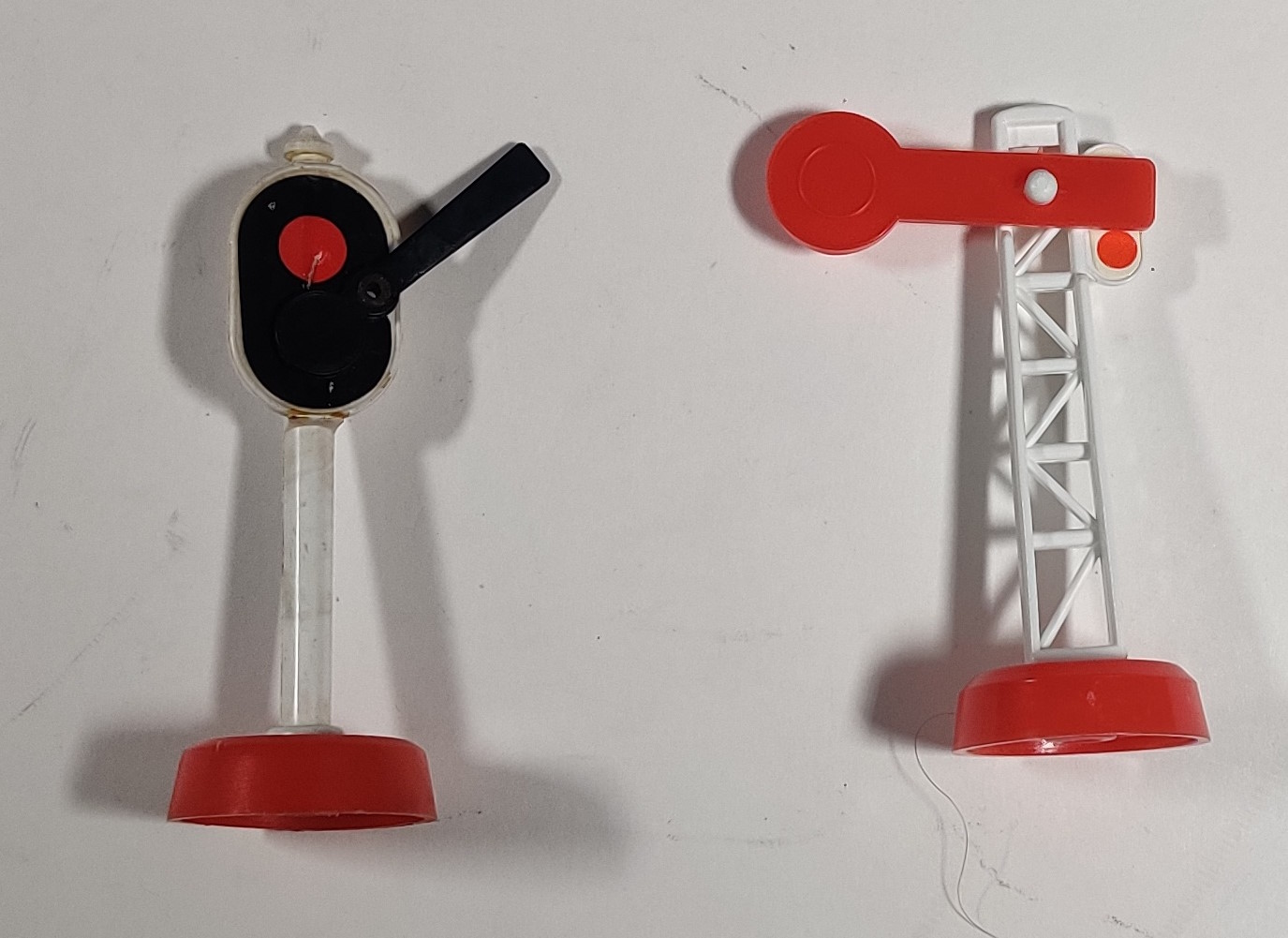
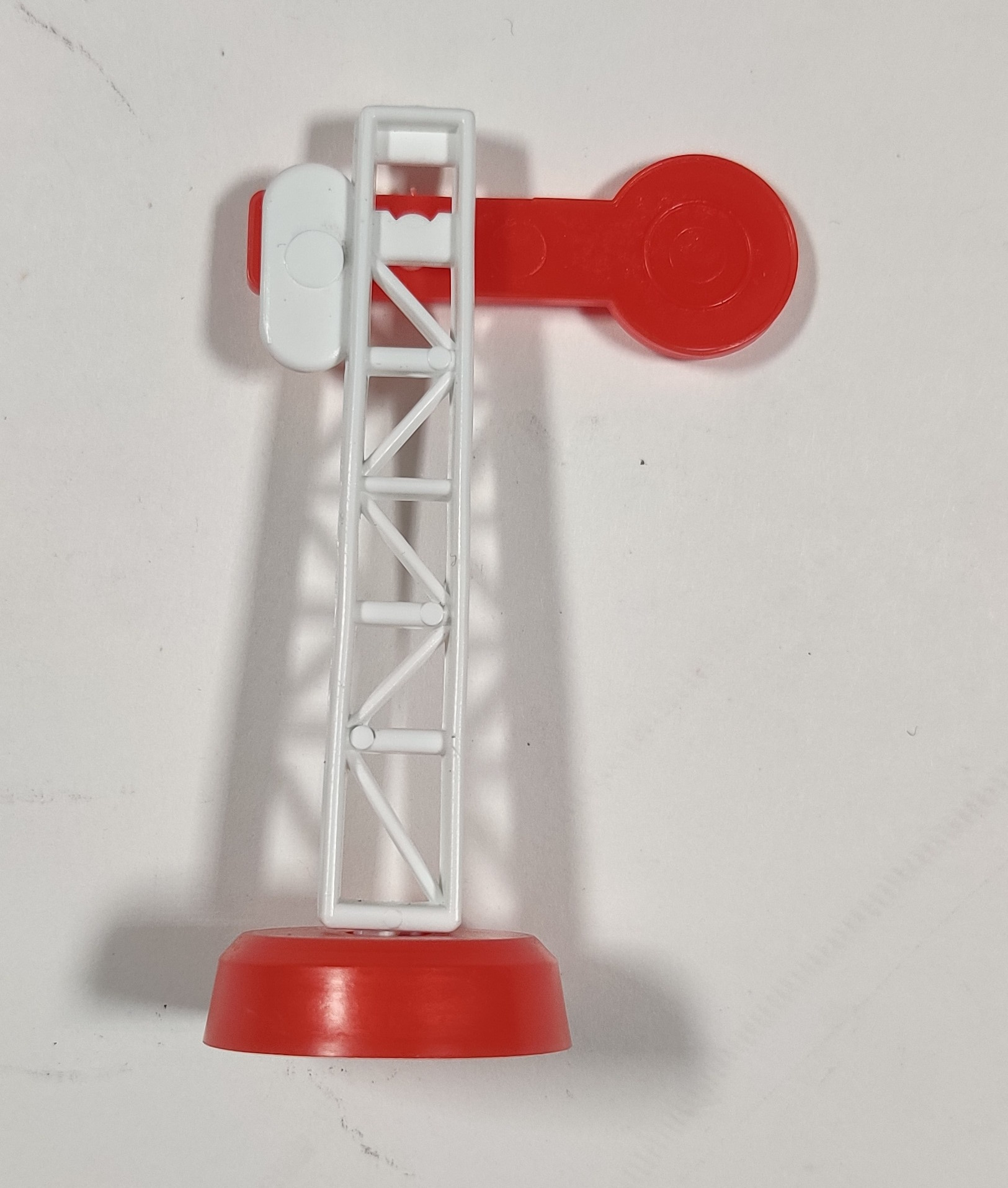
The standing tree, signal, and catenaries are all Stelco-made local specifications based on the Plarail originals. Standing trees do not have a separate white stem and instead have the trunks molded directly into the red bases. Signals are a completely local design and are rather cool looking in my opinion.
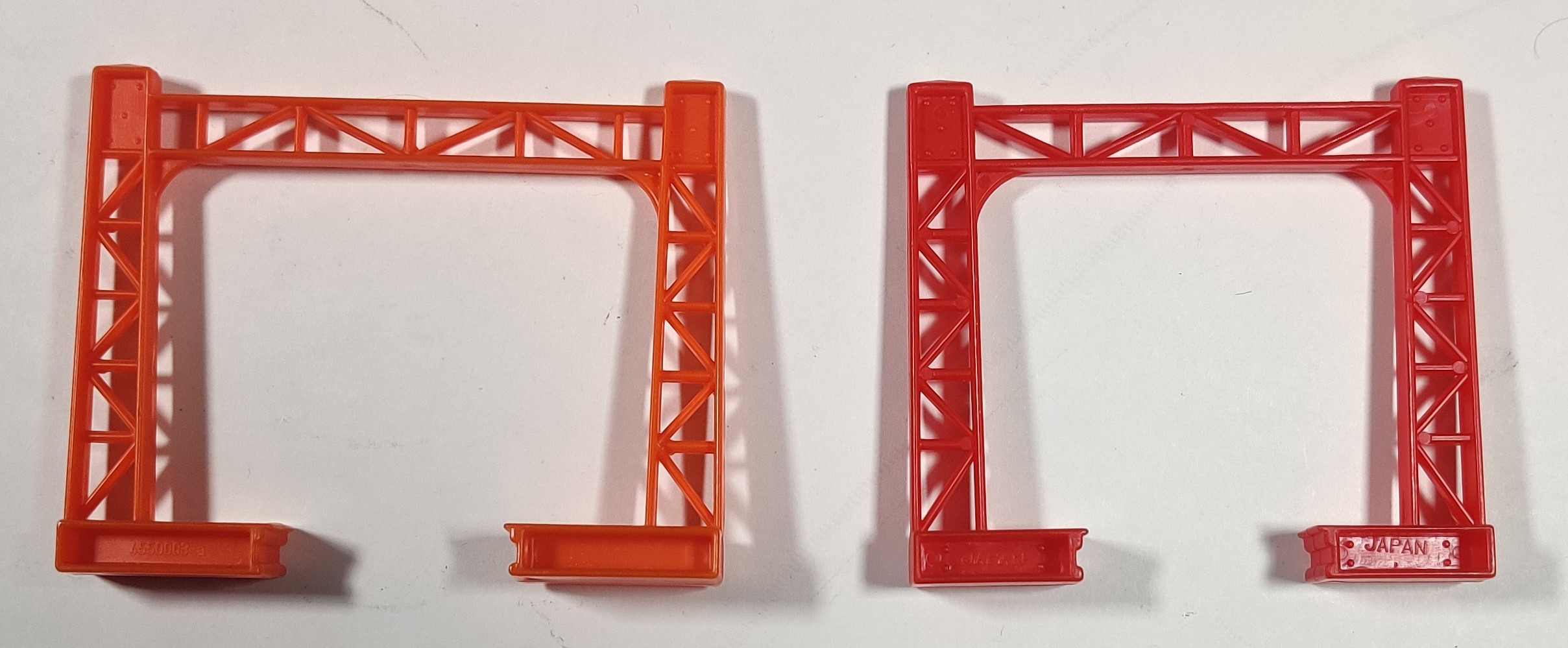
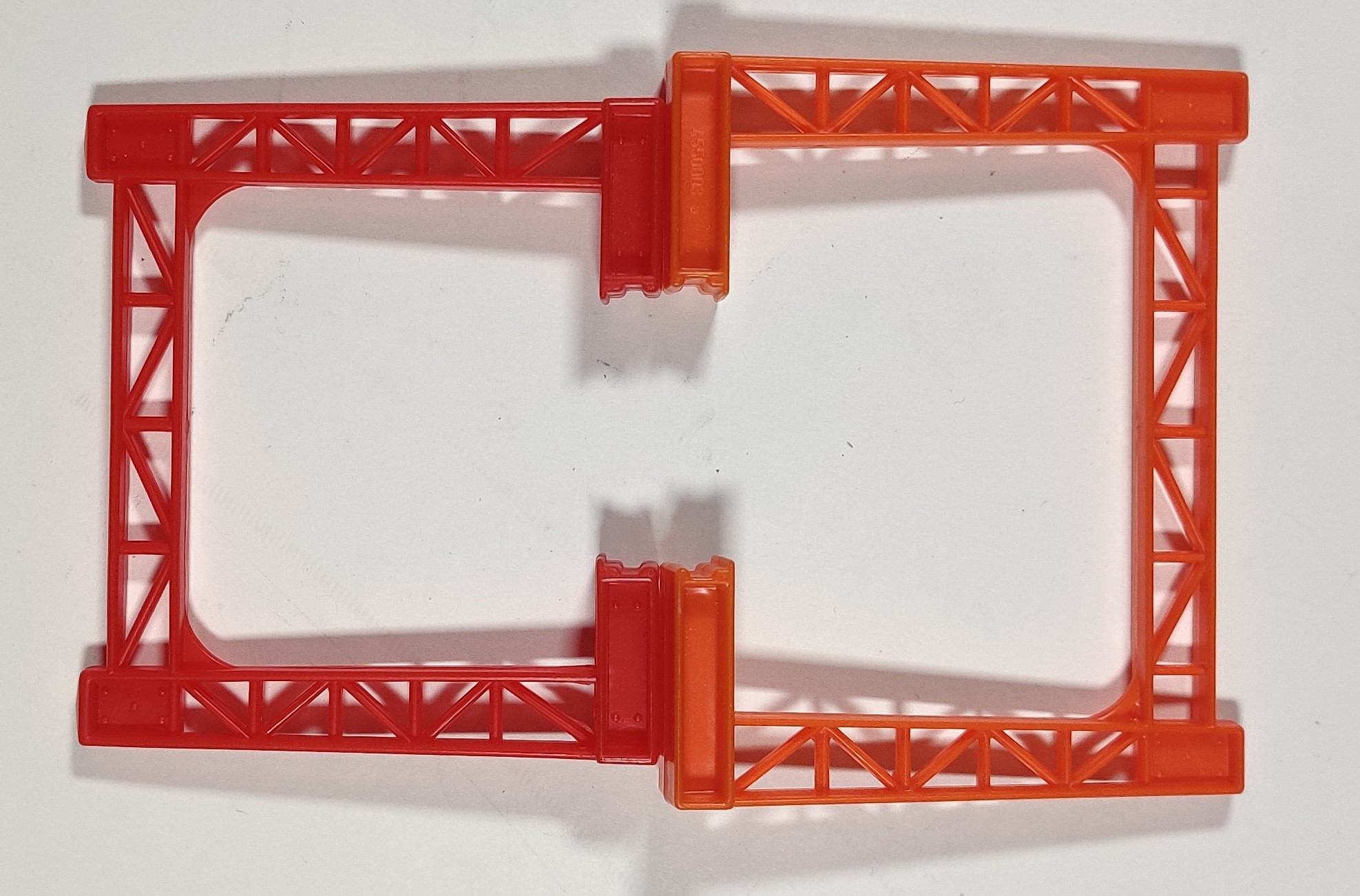
Catenaries are orange instead of red and stretch out slightly wider, perhaps because they were worried the longer Stelco rolling stock would sideswipe them on a curve?
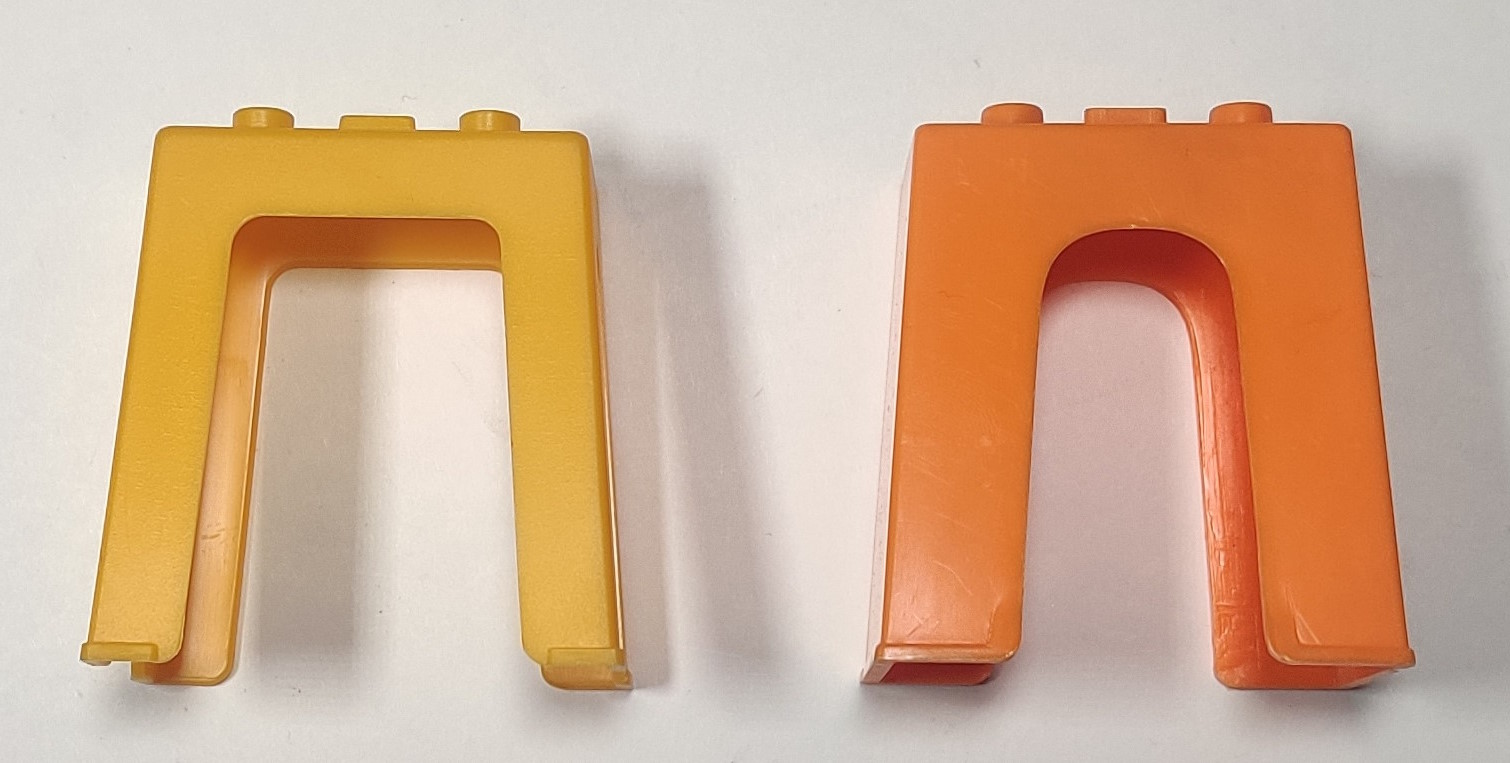
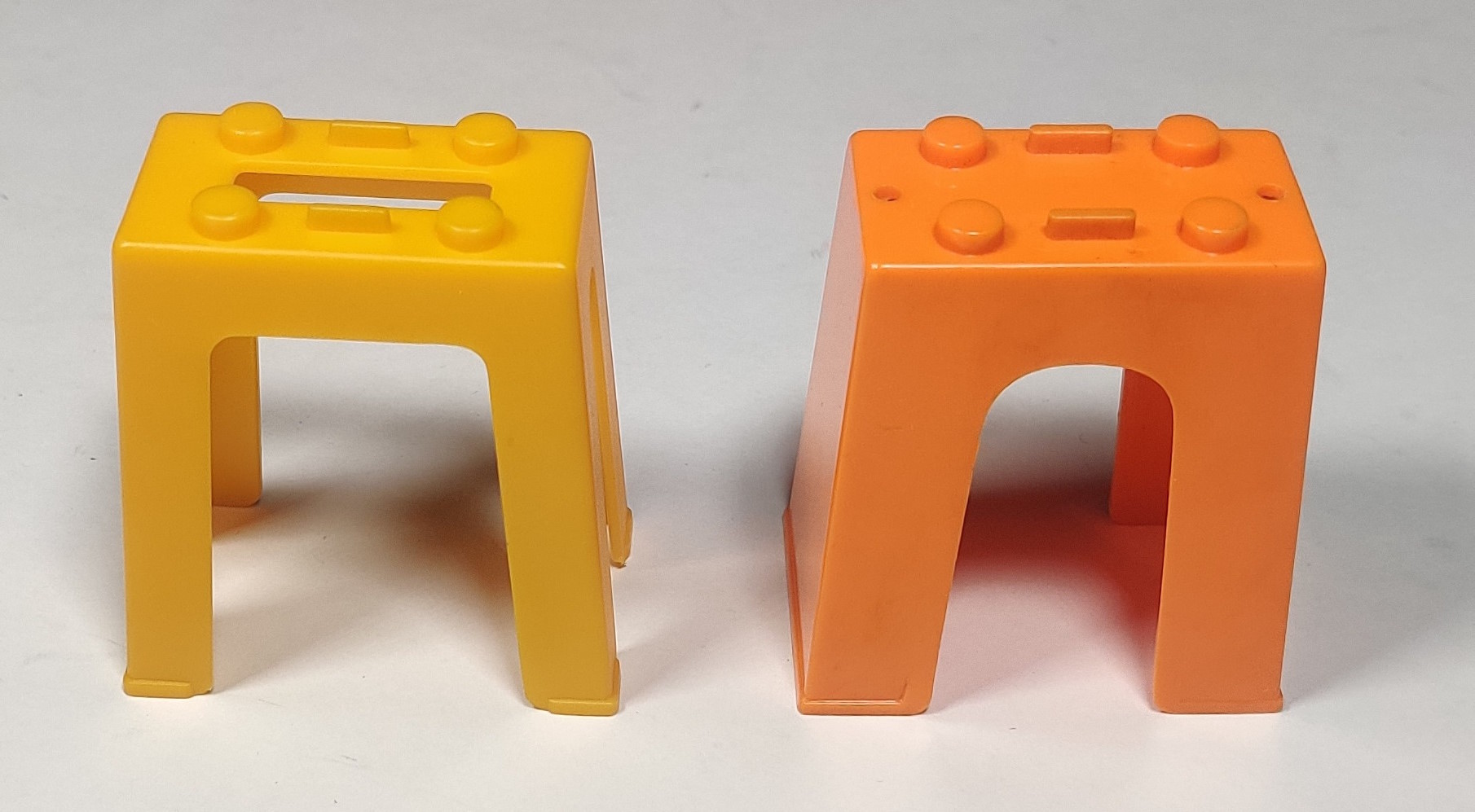
The bridge piers are similar to the 1970s clipless Plarail bridge piers (right) with a similar track locating system on top. The rounded portions fit into the rails molded into the "bottom" of the track and the raised tabs fit on either side of the track connection. Although clearly inspired by the Plarail design, they are also an original Stelco tooling. Like the Plarail originals, the piers raise the track approximately 61mm.
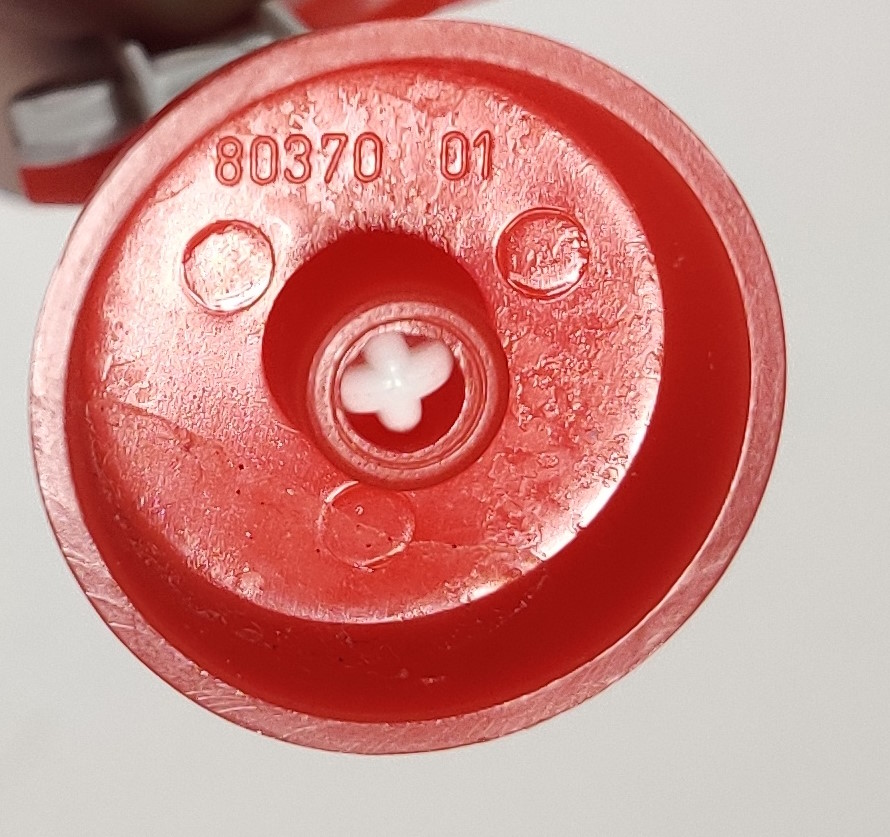
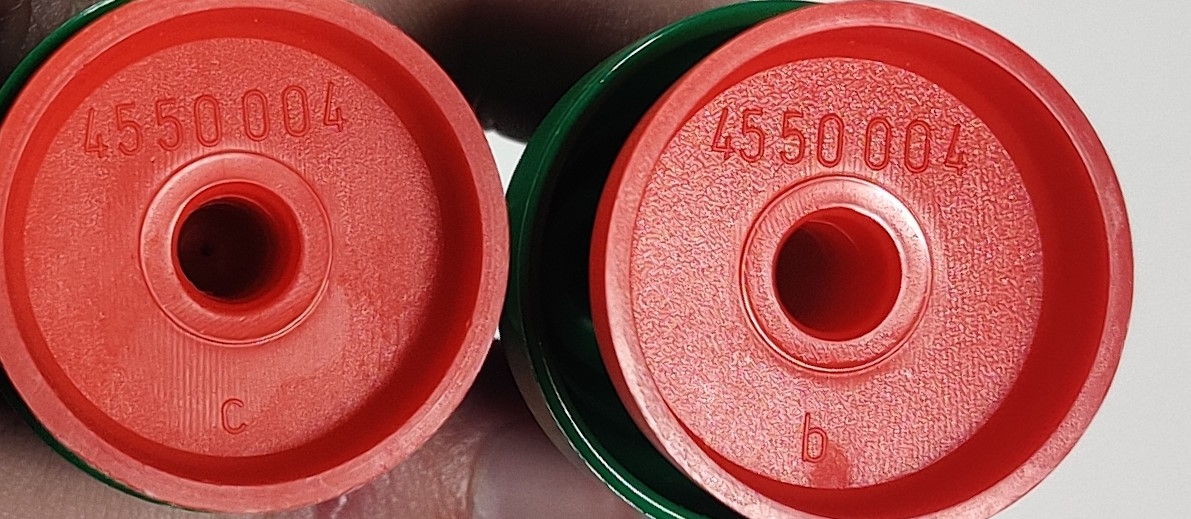
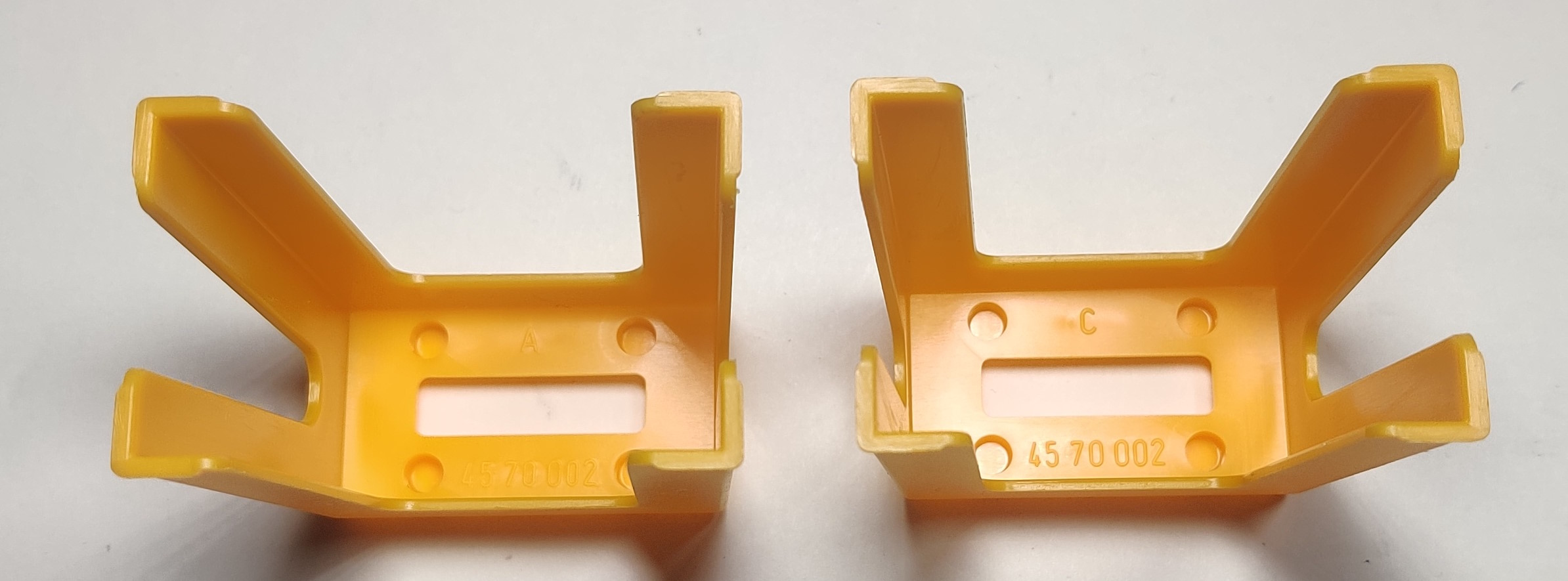
Like the track and rolling stock, the bottoms of trees, signals, catenaries, and other components are marked with product numbers as well as slot marks.
Sets
These are the set numbers and contents I am aware of, all of which appear in the 1979-1980 Stelco Catalogue. It seems to me that the initial range of incremented-by-five numbered sets may have been the initial wave that came out in 1978 as it seems to be that the two oddly numbered sets did not appear until 1979, with those sets continuing production into late 1979 under Tomy Spielwaren. If you know of any additional sets or information, please get in touch.
| Set # | Description | Picture |
| 4545 | Smallest Junior Express set, oval with EF58 and passenger train with accessories |
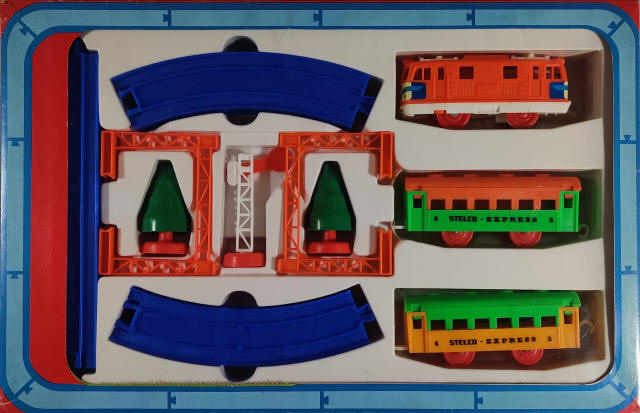 |
| 4550 | Oval with railroad crossing and C12 with passenger train | Can be seen in the 1979-1980 Stelco Catalogue |
| 4560 | Basic No.2-style set with oval with passing loop, railroad crossing, and C12 with freight train | Can be seen in the 1979-1980 Stelco Catalogue |
| 4565 | Big Junior Express set with large outer loop with bridge in the rear and smaller inner loop with C12 and freight train | Can be seen in the 1979-1980 Stelco Catalogue |
| 4570 | Large "overpass" style set with railroad crossing, elevated section, and C12 with tanker wagon and car carrier |
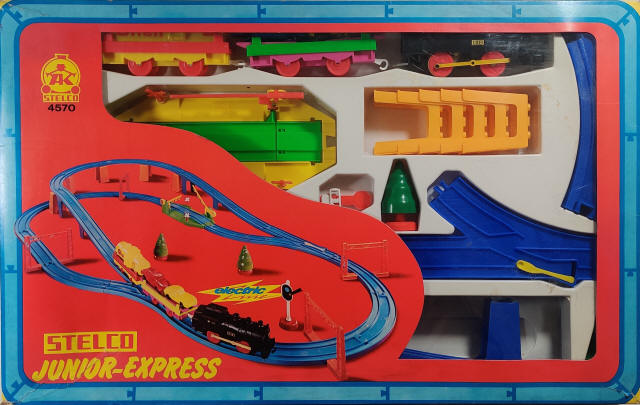 |
| 4582 | Oval with passing loop style set with an adaptation of the Plarail whistle-release station and C12 with passenger train | Can be seen here |
| 4583 | Cool adaptation of the pneumatic station into a little moveable crane, exclusive to Stelco Junior-Express, with a C12 and freight train | Can be seen in the 1979-1980 Stelco Catalogue |
| 4567 | Seemingly a slightly later set that always had the later C12 with a colorful assortment of rails | Can be seen here |
Some Junior Express trains as well as a neat hand-made diesel-type push train can be seen on this German forum.
